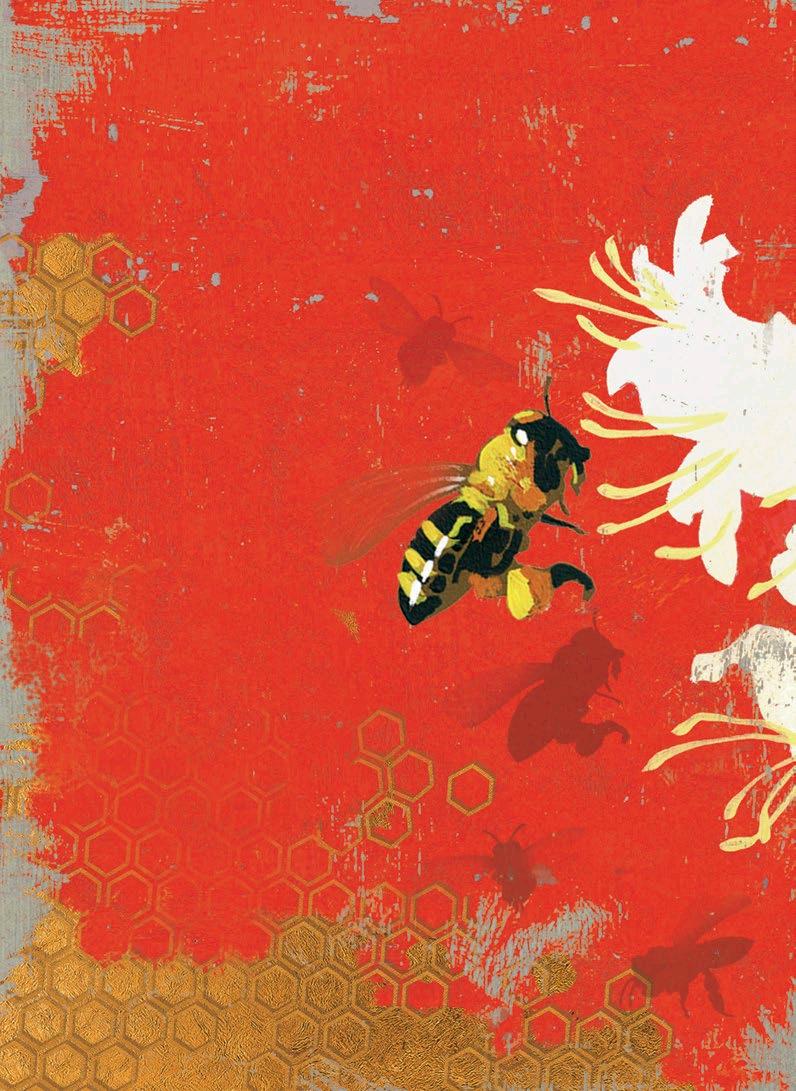

How We Feel About Sunshine



12 IT’S A MANN’S WORLD
Olly Mann is getting married— much to his surprise
The actor discusses Hollywood and his many famous friends Health
34 HELLO SUNSHINE!

76 BEST OF BRITISH: VINEYARDS
54 HOW TO TALK TO YOUR DOCTOR
Why good communication is the key to good health
Inspire
62 PASSING ON THE BUZZ
It turns out that beekeeping is vital to our future
70 SUMMER HAPPINESS PHOTO COMPETITION
Send us your snaps—they could win you a high-end camera!
Discover how Britain is turning into a top wine producer
Travel & Adventure
84 SWEDEN’S MOST PERFECT SEASON
With sunshine, seawater and seafood, there’s every reason to visit Scandinavia
96 A LEOPARD DOESN’T CHANGE ITS SPOTS
Photographer David Plummer is defying Parkinson’s Disease to grab life by the horns
EDITOR’S LETTER

THE IMPORTANCE OF BEES is hardly uppermost in your mind when you’re swatting them away from your picnic. But our feature on p62 demonstrates just how much we rely on these humble insects, and how a new generation of urban beekeepers is doing its bit to keep the population stable—something to consider when you’re next enjoying toast and honey.
Creatures of a different kind are on display on p96, courtesy of wildlife photographer David Plummer, who travels across the globe to capture his wonderful pictures despite being diagnosed with Parkinson’s seven years ago. And if you want to emulate his example, there’s still time to enter our own summer photo competition —find full details on p70.
Finally, those hoping to catch some rays this month (while dodging the rain) should read our feature on p34, which explores our love-hate relationship with the sun, and how to stay safe while unwinding on the beach!
 Tom Browne
Tom Browne
theeditor@readersdigest.co.uk
facebook.com/readersdigestuk
twitter.com/readersdigestuk
pinterest.com/rdigestuk
google.com/+ReadersDigestUK1

















EDITOR-IN-CHIEF Tom Browne
ASSISTANT EDITOR Fiona Hicks
DIGITAL EDITOR Mandi Goodier
ASSISTANT DIGITAL EDITOR Anna Walker
ART DIRECTOR Yvey Bailey
GRAPHIC DESIGNER Richard Cooke
ADVERTISING DIRECTOR Simon Fulton
simon.fulton@readersdigest.co.uk 0203 701 5936
ADVERTISING ACCOUNT DIRECTOR Mike Allen mike.allen@readersdigest.co.uk 0203 701 5935
CEO Gary Hopkins
CHIEF OPERATING OFFICER Julie Leach
PARTNERSHIPS MANAGER Maggie Champion
TRUSTED MEDIA BRANDS INC (USA)
President and Chief Executive Officer
Bonnie Kintzer
Vice President, Chief Operating Officer, International Brian Kennedy
Editor-in-Chief, International Magazines
Raimo Moysa
For all subscriber enquiries, please use the customer services number below
WE PAY...
£50 for the star letter and £30 for regular letters.
Email readersletters@readers digest.co.uk or go to readers digest.co.uk/contact-us
WE ALSO PAY...
£50 for the true stories, anecdotes, jokes in Laugh! and You Couldn’t Make It Up…, and contributions to end-ofarticle fillers and My Great Escape.
Email excerpts@readersdigest.co.uk or go to readersdigest.co.uk/contact-us
SORRY!
We cannot acknowledge or return unpublished items or unsolicited article-length manuscripts. Do not send SAEs. Article-length stories, poetry and cartoons are not requested.
CUSTOMER SERVICES
Contact Customer Services for renewals, gifts, address changes, payments, account information and all other enquiries. Call 0330 333 2220* or email customer_service@readersdigest.co.uk
TALKING MAGAZINES
Reader’s Digest is also available in audio and accessible etext editions from RNIB Newsagent, for blind and partially sighted readers. Call the RNIB Helpline on 0303 123 9999 or visit rnib.org.uk/newsagent
SUBSCRIPTIONS
Visit readersdigest.co.uk or write to: Reader’s Digest, PO Box 7853, Ringwood BH24 9FH. UK: £45.48 a year. Republic of Ireland: €61.20 a year. Prices include delivery. For gift subscriptions, contact Customer Services.
CARTOON COMMUTERS readersdigest.co.uk

Going for Gold
The 2016 summer Olympics kick off in Rio this month. To celebrate, we’re exploring the evolution of this unique global gathering, from the Sanctuary of Zeus in Olympia to the copycats of the French Revolution and the 2012 games in London. Read more about the games at readersdigest.co.uk/ inspire, where you can also learn about this year’s refugee team.
Hit the Road, David…
Fifteen years after The Office, Ricky Gervais has resurrected his most famous character. Apparently David Brent: Life on the Road, out on August 19, will be something like Martin Scorsese filming the Rolling Stones. Take a look at Brent’s most cringeworthy moments at readersdigest.co.uk/ entertainment

Illustrator October Jones passes time on the train by turning his fellow commuters into funny cartoon characters. Here are some of our favourites:



See more work from October Jones at readersdigest.co.uk/ laugh
Over to You
LETTERS ON THE JUNE ISSUE
We pay £50 for Letter of the Month and £30 for all others
✯ LETTER OF THE MONTH...
Dan Snow’s suggestion in “If I Ruled the World” that schools focus on boosting creativity and a love of learning is so simple and yet so important.
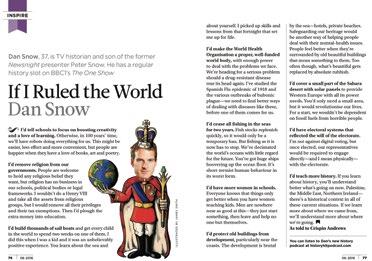
For too long, the sciences have been seen as superior and prioritised over the arts. Yet while science leads to innovations and physical developments that improve our lives, we’re wrong to neglect the arts, which are just as life-enhancing.
At present, a love of learning is being stifled by the need to achieve. Results-led lessons mean that students merely have to jump through hoops—an approach that stifles curiosity and independent thinking. It neither serves the individual nor the country well. It’s time something was done—perhaps Dan Snow could become the new secretary of state for education?
JENNIE GARDNER, BathCHRIS’ CREATURES
We enjoyed “I Remember” with Chris Packham. My wife is a wildlife photographer and we’ve long been fans of his. He’ll battle for badgers and beavers, wait hours to see a hummingbird, and won’t pander to the panda lobby. He gets down to brass tacks and tells it like it is.
It was therefore most interesting to learn more about him and his work. I note he’s always preferred animals to humans—and why not? Animals don’t lie, do they? He’s an amazing man doing wonderful things for this planet. I only wish there were more like him.
RYAN MATTHEW, ClwydHEALTHY AND WHOLESOME
“Best of British: Pick Your Own” reminded me of the time in 1963 when we spent four weeks picking strawberries in Tiptree, Essex. The farm produced fruit for Wilkins, the famous jam makers, and we took our two small sons. We pitched our tent in an orchard, which was adjacent to the fields.
When we left we were brown as berries and, after expenses, earned the princely sum of £9. I was five months’ pregnant at the time and when November arrived I had an almost painless confinement. In my condition, the free holiday, fresh air and abundance of good food made up for our primitive domestic arrangements—in spades.
PHILIPPA SAMPSON, DevonGO ON, OLLY!
Olly Mann’s column “A Walk on the Wild Side” talked about the head rambler leaving his village, and Olly deciding he wasn’t good enough to take over the role. Don’t give up, Olly! I’m 78 and do a bit of walking. I’ve taken to navigating with Ordnance Survey maps and a compass—surely you could do the same with the help of 20 or so villagers?
INDERJIT OBEROI, Northampton
FORGETTING FOXTON
You do this country a disservice in “See The World Differently” by saying that only in Poland would you find such an engineering marvel of a boat travelling on a railway line. How about the Foxton boat lift in Leicestershire?
TERRY KIGHT, NottinghamA HANDY REMINDER
Thank heavens for the letters on the “Over to You” page! This is how it goes: you’re reading your new Reader’s Digest when you get interrupted by life—work, cooking, housework, etc. So you put your magazine to one side. Visitors arrive and the side pile gets carefully filed out of sight and forgotten.
Some time later, your new magazine arrives and you tear off the polythene and begin reading— starting with “Over to You”. You read a letter that refers to a feature and think, I don’t remember reading about that. So off you go in search of the missing mag and, just like that, you have two months’ pleasurable reading to look forward to.
I’m currently re-reading August 2015’s edition, which I discovered in a pile of old birthday cards. The information is enduring.
JOAN WALL, Cambridgeshire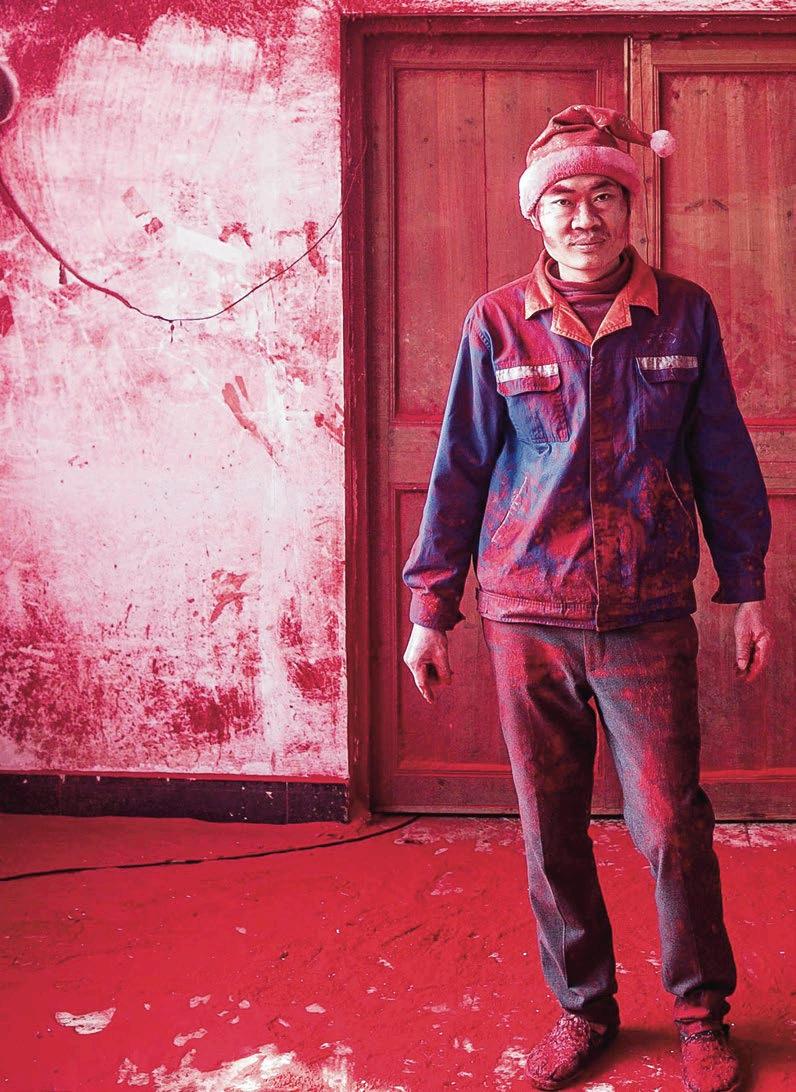

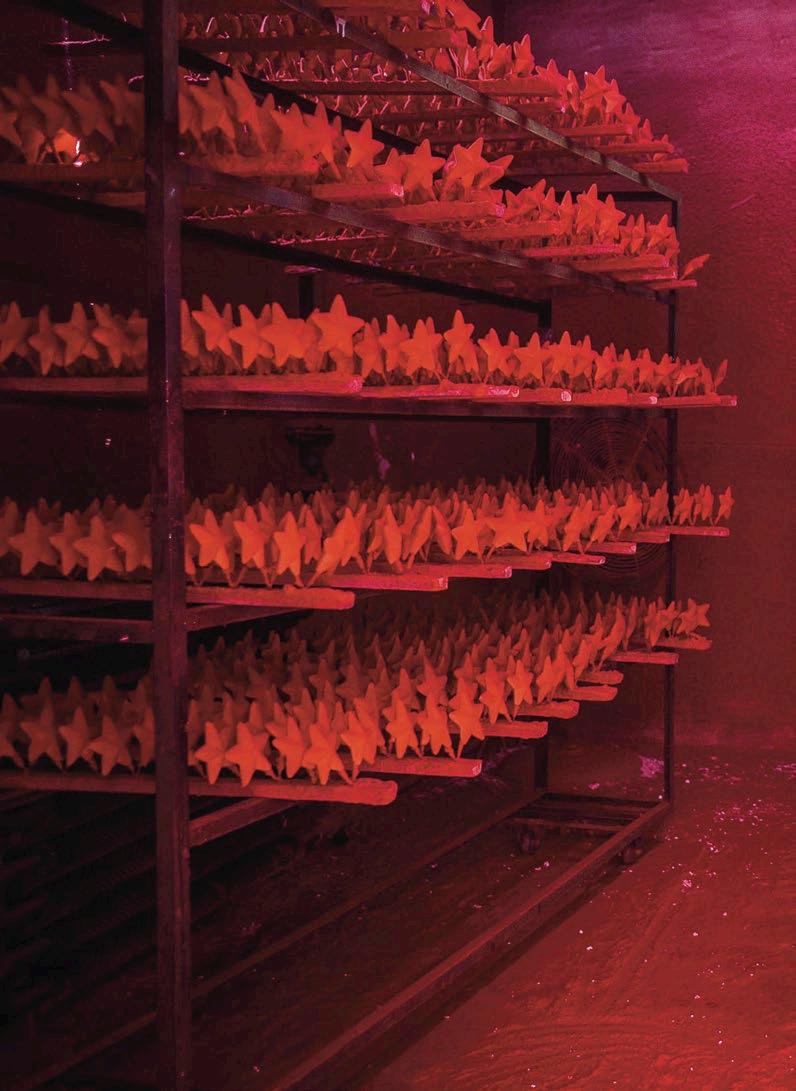
...DIFFERENTLY
Christmas at this time of year—where can you find that? Well, in the Chinese province! Summer in the town of Yiwu means peak production of Christmas decorations, even though the majority of people living there don’t celebrate the festival. In fact, with an abundance of snow, little elves and plump men with bushy white beards (all made from plastic), roughly 60 per cent of the world’s Yuletide decorations are produced and shipped from here.

A trip to Gibraltar has finally persuaded Olly Mann to tie the knot
Get Me To The Rock On Time

Olly Mann is a writer, radio presenter and serial podcaster, with shows including Answer Me This!, The Media Podcast and The Modern Mann
I’M GETTING MARRIED. This will come as a surprise to regular listeners of my Q&A podcast Answer Me This!—on which, for nearly a decade, I’ve heartily advised any poor soul writing to us to ask what their first dance should be, or what budget they should set for their party favours, or whether they should propose so soon into their relationship, that they’d be far better off NOT GETTING MARRIED AT ALL.
Yet I’m not anti-marriage: having spent the last 13 years in a faithful, monogamous relationship with a lady who now shares my mortgage and gave birth to my child, I have no difficulty with the concept of commitment, a stable family unit, or wanting to formalise that process.
I’m more accurately described as anti-wedding—but that’s not the whole truth either, as I love attending other people’s weddings. Where else but a wedding dancefloor do toddlers and pensioners share a boogie? Where else but in a father-ofthe-bride speech are dad jokes given a decent airing? Where else, except perhaps Buckingham Palace, is the entrance of a cake—a cake!—choreographed for maximum spectacle? Other people’s weddings are brilliant.
IT’S JUST THAT I AM—or at least I was—anti-MY-wedding. My partner Jenny felt the same. If we could click our fingers one day and somehow find ourselves married, that would be fine: it would simplify our financial affairs, make our son feel

more secure and act as a symbolic recognition of our feelings for each other. What we wanted to avoid was the organisational agony of wedding planning: the contortions of self-inflicted paranoia about our
guest-list or table plans; the endless bridal shopping; the hours of debate about tablecloths, or entrance music, or B&Bs, or floral centrepieces.
After all, we already live together and have a child, so the pretence that
our wedding would mark a significant watershed in our lives as a couple rings hollow. We’re not religious, so have no wish for God’s seal of approval: and, even if we did, I’m from a Jewish family and she’s C of E, so the very process of us staging a religious ceremony might alienate members of our respective extended families who actually care about that stuff, thereby increasing our chances of going to Hell. (Actually, Judaism doesn’t have Hell. Organising a Jewish wedding is the closest we can come to it.)
Most of all, we didn’t fancy standing up in front of everyone —and I mean everyone: friends of our grandparents, ex-colleagues we no longer see but felt obliged to invite, third cousins we’ve only met twice— to declare our love. It’s not that we don’t feel those things, it’s that we don’t feel the need for everyone to witness it. We think it’s a bit cheesy and a bit scary. Despite what I do for a living, the idea of giving a speech about why I love my girlfriend makes me feel physically sick. And Jenny’s never been the kind of girl who grew up wanting to marry her Prince Charming in a fairytale wedding. I mean, clearly. She ended up with me.
I guess what we want, really, is a civil partnership, set apart from the pressure of a “wedding”, so there wouldn’t be such expectation that everyone should attend, or a big deal should be made out of it. But in the UK you can only have a civil partnership if you’re gay.
The idea of giving a speech about why I love my girlfriend makes me feel physically sick
YET HERE WE ARE, about to get hitched. There are a few reasons
for this: the birth of our son has added a legal reason to unite (ah, inheritance law. What could be more romantic?). The death of my father, earlier this year, has spurred us on to arrange a happy event. And, when we were on holiday in Marbella last month, we discovered Gibraltar.
You see, for reasons
I still don’t fully understand, Gibraltar, despite clearly being in Spain, is British, or part-British, or an M&S franchise or something. So that means we can have a legit, British, non-denominational, registry office wedding there. However, unlike our local registry office in Hertfordshire, we’re guaranteed sunshine and have an excuse to keep the event small— it’s a long way away.
So, in a couple of weeks time, we’re heading off to the Costa Del
Sol with a very select group of our most immediate family and some school friends we’ve known since we were ten, for a…holiday. Not a wedding. Just a nice group holiday in the sunshine, of which our marriage ceremony will form a part.
That’s the hope, anyway. Despite all our efforts to keep it low-key, it
turns out there are administrative hurdles that must still be jumped: music needs to be played, we all need to be wearing clothes, someone needs to cook the food and someone needs to take the photos. But, in short, we might—might—be about to get away with getting married, without having a wedding.
BUDDING AUTHORS, TAKE A BOW!
This captivating, clever tale was one of thousands submitted to this year’s 100-Word-Story Competition. We’re publishing a commended story every month.
THE COMMUTE
Everybody is wearing black. Bottoms shuffle, eyes fix on feet, knees and elbows touch. Red-faced, last-minute stragglers bumble down the aisle, searching for seats.
It’s a funeral but not for somebody, for something. Time. These people are in mourning for the passing of time. Time lost sitting on this bus, Monday to Friday. Time pondered on pot-holed roads. Time squandered on this dreary déjà-vu destination. Time spent tapping feet and watching watches.
At the front, the driver conducts the service. At the back, rough kids provide the music. Everyone takes an order of service; the Metro. Laura Ogryzko, Glasgow

Laura says: “I haven’t been writing very long—just over a year and half. My story developed by reimagining a typical morning commute on a bus as a funeral service. The gravefaced passengers, suited and booted in black, awkwardly sitting next to one another. I liked the idea that they were collectively grieving for the passing of time in a literal sense; time they simply can’t get back, time lost in the daily grind.”
Laura will receive a cheque for £50


















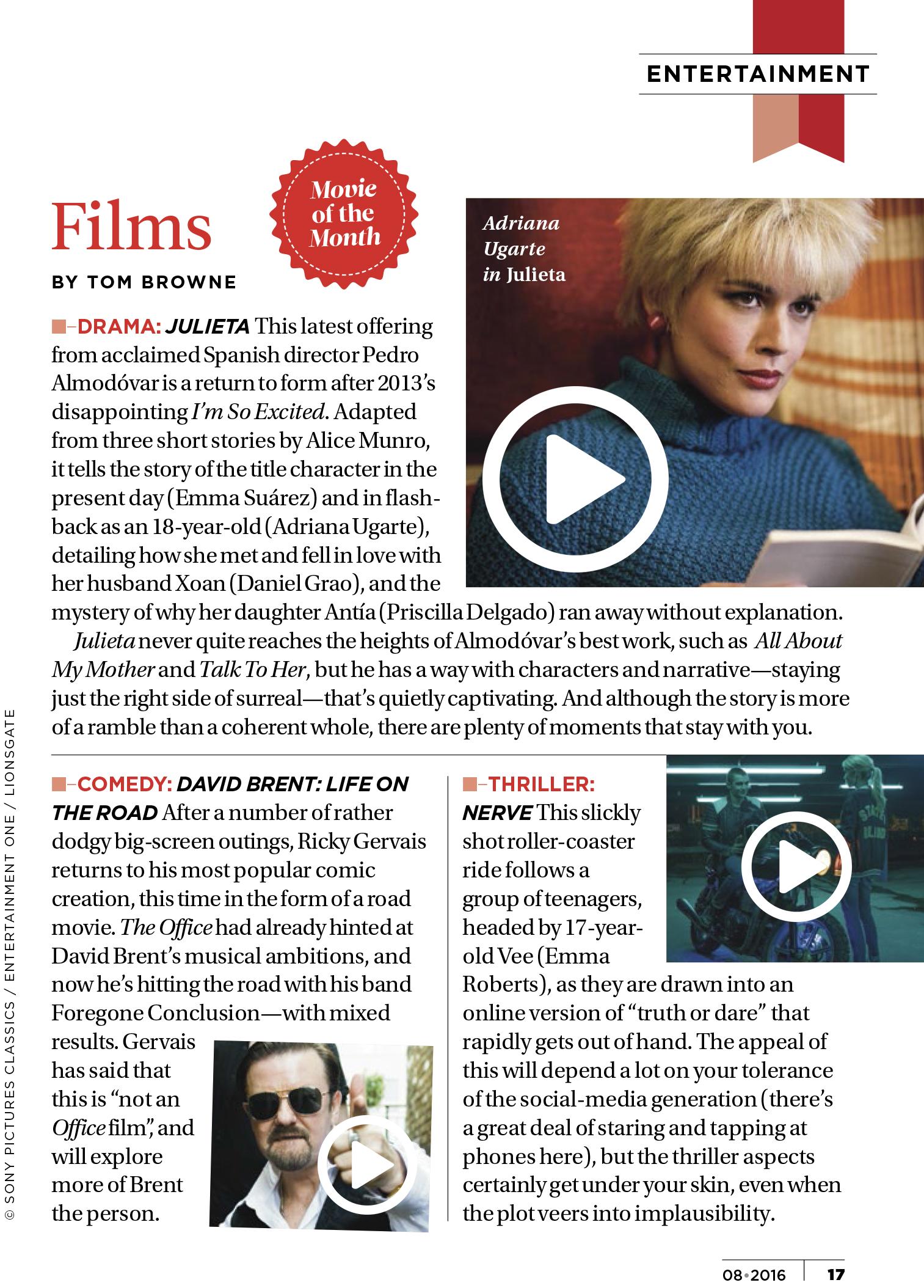
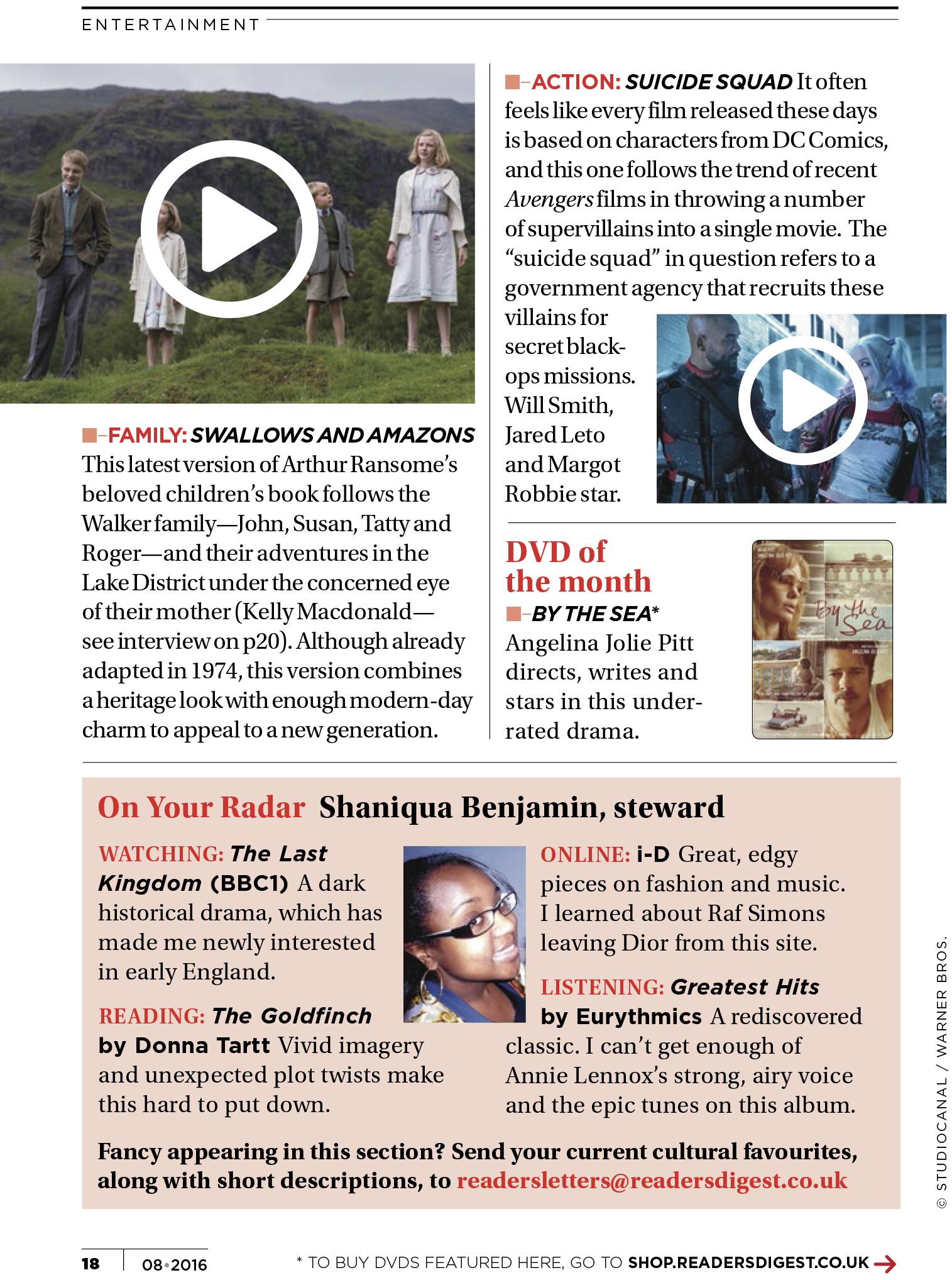
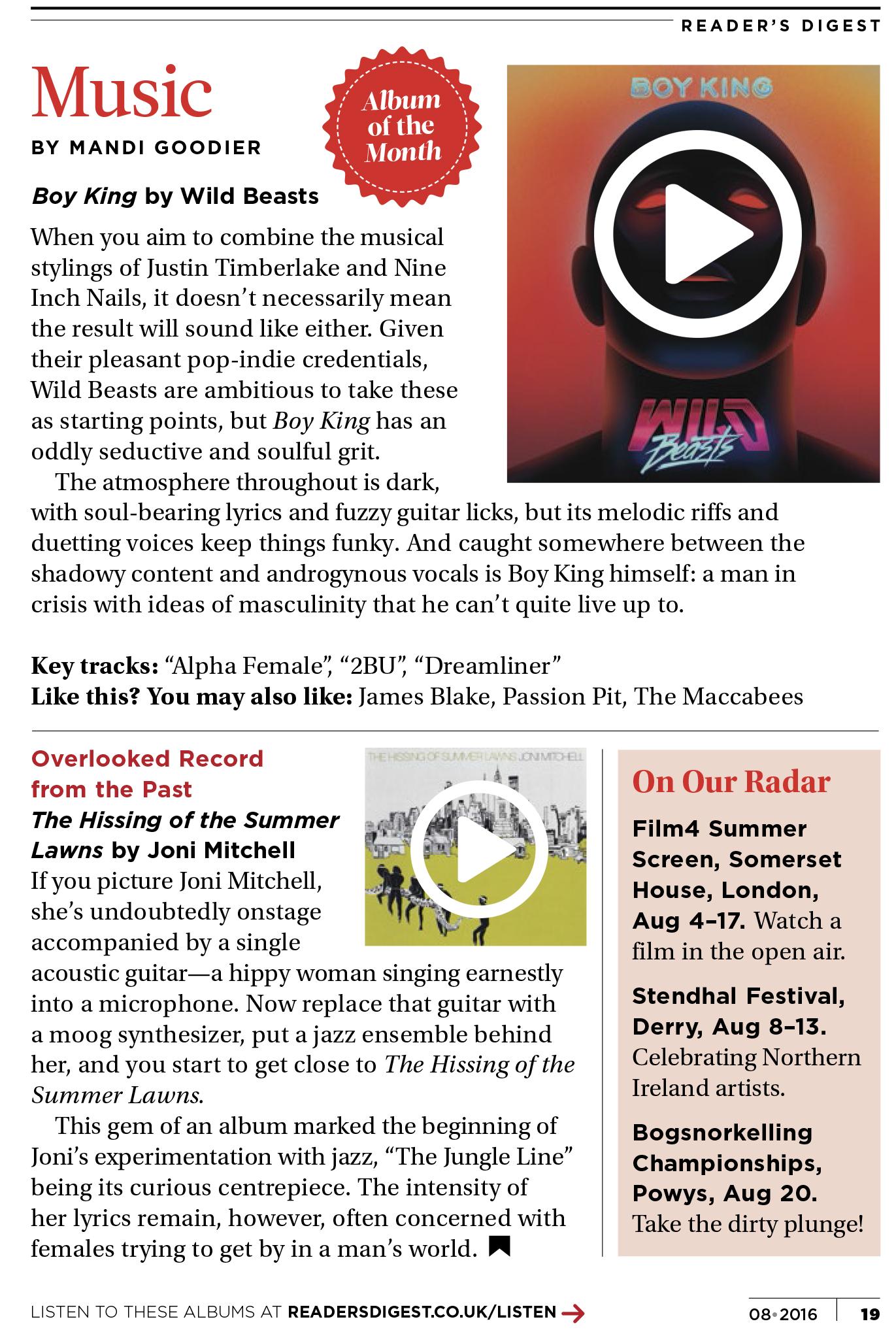
Lakes Adventures In The
After wowing America on the big and small screens, Swallows and Amazons sees Kelly Macdonald returning at last to British soil
BY TOM BROWNE
OVER THE YEARS , Kelly
Macdonald has slowly but steadily built up a reputation as one of our most respected actors. After exploding onto the scene in Trainspotting in 1996—as the underage girlfriend of Ewan McGregor’s Renton—she’s had starring roles in Gosford Park, Finding Neverland and A Cock and Bull Story, picking up an Emmy Award and an Oscar nomination in the process.
Her early success continued across the Atlantic. Although many British actors struggle to establish themselves in Hollywood, Kelly struck gold early on with a small but significant part in the Cohen brothers’ No Country for Old Men, displaying a talent for accents in her portrayal of Texan wife Carla Jean Moss. This in turn landed her the role of Irish émigré Margaret Thompson in HBO’s acclaimed crime drama Boardwalk Empire, for which she and the rest of the cast won a Screen Actors Guild Award.
Boardwalk Empire started in 2010 and ran until 2014, so her latest film—an adaptation of Arthur Ransome’s much-loved children’s classic Swallows and Amazons, in which Kelly plays the matriarch
of the Walker family—represents something of a homecoming for the Scottish-born actress. Not before time, you sense.
“It was such fun to be involved in something that was absolutely British,” she says with enthusiasm, “and also not to be playing the character I’ve been playing for years. It was just nice not to be Margaret Thompson for once. It gave me a bit of a bounce!”
SWALLOWS AND AMAZONS is that rare thing: a British film with a heritage look (steam trains, rolling countryside, picnic hampers) that will nonetheless appeal to audiences of all ages. Following the fortunes of John, Susan, Tatty and Roger Walker (the Swallows), and Nancy and Peggy Blackett (the Amazons), it takes full advantage of its Lake District setting in mapping out the children’s swashbuckling adventures on land and water.
Although these exploits are very different from Kelly’s own Glasgowbased childhood, she can relate to its depiction of a time when kids had a lot more freedom to roam. Can she imagine, for example, allowing her own children (she has two, with musician husband Dougie Payne) to sail off in a boat unaccompanied, as the Walker gang do?
“Hell, no!” she replies, aghast at the thought. “It’s just not something you can do now. People get freaked
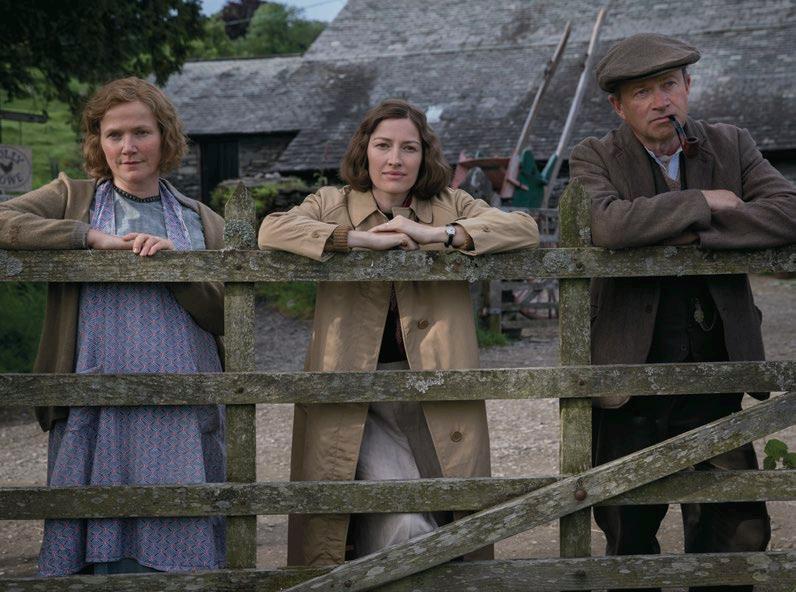

Kelly with Jessica Hynes and Harry Enfield in Swallows and Amazons. Starring in a British film gave her “a bit of a bounce”
“Kids sort of accept terrifying things. I remember going off on my bike with some friends to this little hill near us, and there was a flasher at the bottom of the hill. We were in the middle of nowhere, a bunch of little girls. Someone spotted him and we screamed and ran away, but it was kind of an adventure—you just think, Oh, that happened. But for a parent it’s absolutely traumatising.”
Much of the success of the film, in fact, is down to a similar sense of danger and realism, and also the out by their kids even walking to school these days. I was always playing in building sites as a child— just half-constructed houses, really dangerous places. And I’d be gone for hours and hours.
quality of its child performers —mostly newcomers. “That was down to [director] Philippa Lowthorpe,” acknowledges Kelly. “She worked really hard, going round so many schools and seeing so many children. We ended up with a tight-knit and cool little group!”
“I’ve worked on a few films where there have been a lot of child actors, and I’ve been really lucky,” she continues, alluding to her part in the Harry Potter franchise (she played Helena Ravenclaw) and the difficulty of being thrust into the limelight at an early age, as happened with Daniel Radcliffe. It’s something that applies to Kelly herself, who was just 19 when she was cast in Trainspotting.
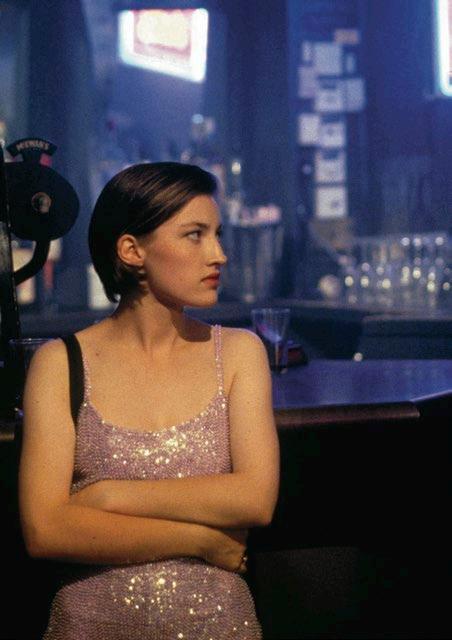
“Yes, that’s true, but things are different now with the internet and social media,” she points out. “That film was a great success, but we were pretty protected at the time. If it happened now, I think we’d be tabloid fodder.”
THE ORIGINAL IMPACT OF TRAINSPOTTING, which marks its 20th anniversary this year, is hard to overstate. Coming as it did during the height of “Cool Britannia” and boasting a memorable Britpopera soundtrack, this darkly funny but bleak tale of Edinburgh-based
heroin addicts was a huge boost to the UK film industry. Even its poster —a line-up of the main characters gesturing defiantly at the camera— seemed to capture the zeitgeist and added to the hype. Did Kelly find the overnight fame difficult?
“I don’t think it was difficult,” she replies, chewing over the question. “It was a shock, and unlike anything that had happened to me before. The poster you mention was quite a new way of promoting a film. It’s normal now to do a long run-up to the release and throw money at the advertising,
but Trainspotting was first of its type.”
Kelly wasn’t the only actor whose life was transformed by the film—it also catapulted Ewan McGregor, Jonny Lee Miller and Robert Carlyle, among others. All of them have since reunited for the sequel, which is currently in production, although Kelly herself is tight-lipped about her involvement (“I couldn’t possibly say” is her only reply, delivered with a mischievous laugh).
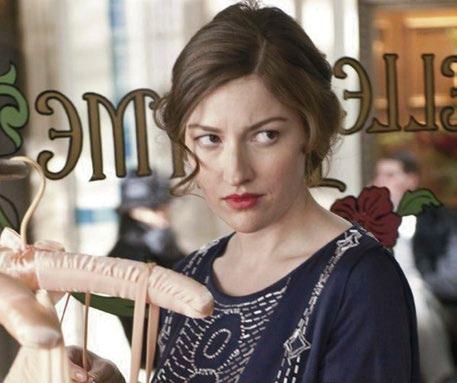
Despite her film success, it’s in television—and particularly Boardwalk Empire—that she’s found some of her most rewarding roles, although she acknowledges that a commitment to a long-running series is tough.
“There are other things to consider now that I’m a certain age and I’ve got a family,” admits Kelly. “I can’t up sticks every couple of years. But I’d never say never. If you’re lucky enough to work in this industry, you can’t complain about it. To be employed for any length of time as an actor is an amazing feat.”
For now, at least, the future looks
rosy. As well as working on a new film with Simon Curtis, who directed My Week With Marilyn, Kelly has just finished an episode of Charlie Brooker’s dystopian TV drama Black Mirror, which should be released later this year. “That was great fun—really dark and weird,” she laughs. “And I got to play the boss lady too, which is quite unusual for me!”
It may be atypical for now—but it’s a role that increasingly suits her.
Swallows and Amazons is released in cinemas on August 19 and is reviewed on p18.
LOVELY DAY FOR IT
Tired of the erratic weather? We’re lucky—it snows metal on Venus.
SOURCE: HUFFINGTONPOST.COM
Burt Reynolds, 80, is an actor, producer and director. He first appeared on the silver screen in 1961, and has since made almost 100 films and countless television series
“I Remember” Burt Reynolds
…MY PARENTS WERE THE MAKING OF ME. Dad was strong but Mum was the boss. He was a former colonel and became a chief of police when they moved to Florida after the war. Dad was my hero and I was always trying to please him. I developed this wild streak, though, and was always getting into trouble. I broke every rule I could and he came down on me like thunder.
…THE NIGHT DAD THREW ME IN JAIL. I was arrested for fighting and he let everyone go except me—and then threw every drunk he arrested on top of me. But if he hadn’t been
so tough, I wouldn’t have achieved so much. Like many men of that generation, he wasn’t demonstrative and never told me he loved me, although at the end of his life he finally said he was proud of me. That meant everything.
…MUM
HAD TO BE STRONG BECAUSE OF MY DAD. He was in the military and away for six years during and after the war, so she was both mother and father to me and my older sister Nancy. He could have been made general, but she told him, “You can be a general or a father.” Of course she got her way.

I loved it when they visited me on the set of my films. Dolly Parton flirted mercilessly with Dad when I did Best Little Whorehouse, which made him very happy!
…PLAYING FOOTBALL IN HIGH SCHOOL SAVED MY LIFE. I never really felt accepted or cool until I became a jock. As a teenager I was running around with
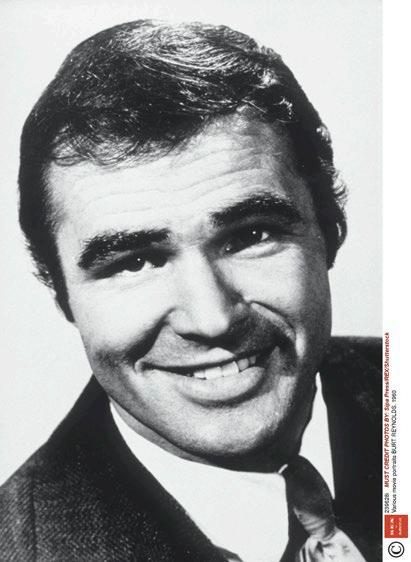
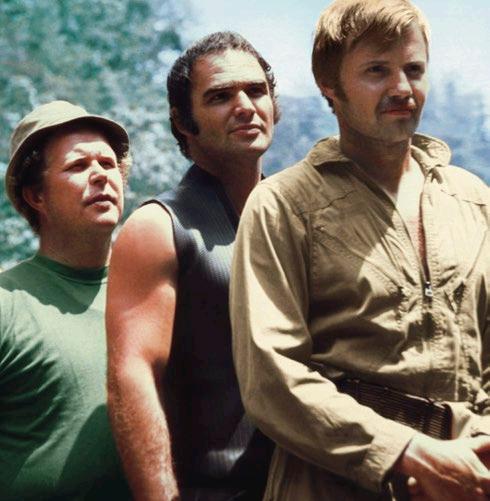
Burt, pictured with Ned Beatty and Jon Voight, says 1972’s Deliverance is “the best movie I’ve ever been in”
a crowd that were getting me into bad situations—and I could have gone either way. But being in the team turned things round for me. There was a lot of discipline and you had to be in shape, otherwise you’d get run over. Without it I’d have ended up in prison, no doubt. The other advantage was that I became more popular with the ladies.
…JOHNNY CARSON CHANGED PEOPLE’S PERCEPTION OF ME.
I was dogged by this reputation of the womanising tough guy and I hated it. People didn’t know I had a sense of humour, but that all
changed after I started appearing on Tonight. I was the first actor to co-host and Johnny was the reason I got to do comedy in films. I loved sending myself up and showing that I didn’t take myself seriously—and so did the audience. I’d say things like, “My movies are the kind they show in prisons or airplanes because nobody can leave.” It was the most fun I’ve ever had in front of a camera.
…NEARLY DYING WHILE MAKING DELIVERANCE. It’s the best movie I’ve ever been in, although it nearly cost me my life. I insisted on doing this stunt where I went over the falls. I got dragged under by whirlpool, which tore off my clothes and broke my sternum.
...THE START OF A LIFELONG FRIENDSHIP WITH JON VOIGHT ON THAT MOVIE. We’re complete opposites and yet we have this incredibly strong bond. I was going to ask out one of his ex-girlfriends, whom I adored. They’d been together for a long time and then they broke up. They’d been apart for a month or so when I thought I’d better ask him if it was OK to ask her out. He went ashen and said, “Burt, you can’t
Why did I marry Loni Anderson? Besides the physical attraction, it was the force of her personality. She wouldn’t be denied
do that to me. I don’t want you to hurt her.”
I was hurt that he said that, but I promised we wouldn’t date because our friendship meant more.
…THE
WORST
DECISION OF
MY CAREER. Just before Deliverance came out, I made a terrible decision to do a naked centrefold for Cosmopolitan. I’ve regretted that all my life because I think it damaged the movie and cost Jon and Ned Beatty Oscars for their performances.
…MAKING A
PERSONAL MISTAKE. I should have listened to my mum—she didn’t want me to marry Loni Anderson, but I’d gone so far as to arrange the wedding and I didn’t want to lose face. I always thought she wore too much make-up, and although we had nice times, I’d be thinking, This isn’t the person for me.
Why did I marry her? Besides the physical attraction, it was
the force of her personality. Her determination. It was something she wanted and wouldn’t be denied.
…THE WORST TIME OF MY LIFE.
I broke my jaw on the set of City Heat with Clint Eastwood. I couldn’t eat and I lost loads of weight. There were vicious rumours going round that I had Aids. I was treated like a leper in Hollywood—it was the most painful time of my life. But I found out who my real friends were, and I wasn’t surprised by who stuck by me.

With his adopted son Quinton, then aged 16, at the premiere of The Longest Yard in 2005
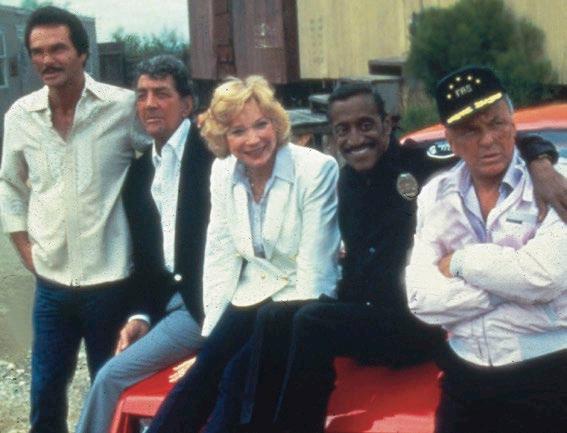
…THE JOY OF FATHERHOOD. My ex-wife Loni and I adopted Quinton. I’m happiest when I’m with him— but he lives in LA and I live in Florida, so unfortunately I don’t get to be with him enough.
He’s grown up to be such a handsome, unspoilt boy. I must give his mother credit for that.
…THE LOVE OF MY LIFE, DINAH SHORE.
I fell in love with her almost instantly the first time we met, when I was a guest on her show Dinah’s Place. We were soulmates…but my career was on fire and my ego was out of control. My biggest regret is parting ways with her; it was so stupid of me. But I didn’t think it would work because of the age gap and I was
In Cannonball Run II with Dean Martin, Shirley MacLaine, Sammy Davis Jr and Frank Sinatra; (below) Burt with Dinah Shore, who was 20 years his senior
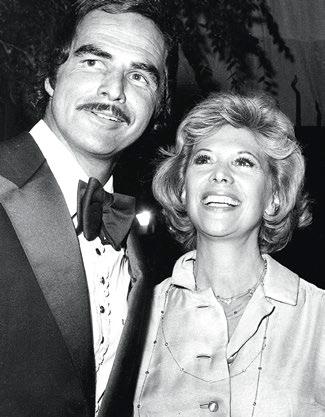
wrong. To this day it makes me sad, but at the same time I was so lucky to have had someone like that in my life. She was so young of heart and spirit in every way. I’ve never found anyone like her since.
…MARLON BRANDO’S HATRED OF ME.
I did a TV show with his sister Jocelyn, who was a wonderful lady. One night she told me that Marlon
Marlon hated me because I looked like him. I was young and had a sense of humour about myself, which he didn’t have
hated me because I looked like him. I was young and frisky and had a sense of humour about myself, which he didn’t have.
I met him once and he was so rude, accusing me of trying to capitalise on looking like him. I was devastated, but I told him I wouldn’t have plastic surgery and promised him I wouldn’t get fat. That hurt him. Looking at me probably reminded him of the mess he’d become.
…MY FRIENDSHIP WITH BETTE DAVIS. I was scared stiff of her when we first met because of her formidable reputation. She was in her later years, but we became great pals.
Once we were at function together and some guy who was sitting in the row behind leaned over and asked her if I was her new conquest. She slapped him so hard you could hear it in the whole theatre. That made me feel wonderful.
There was a mutual attraction and if we’d been closer in age I may have become husband number five. I think we’d have made a go of it.
…MY LOVE AFFAIR WITH SALLY FIELD. I wanted Sally for Smokey and the Bandit, because she had talent...and talent is sexy. One of the things people say about the film is that you’re watching two people fall in love on screen, and it’s true. But every time I wanted to get married, she didn’t and every time she wanted to get married, I didn’t.
If I had the chance to go back and start my relationship with Sally Field again, I’d probably try to be more of what she wanted. But I don’t know what she wanted. I think we were having such fun that she thought I was her pal, not her boyfriend.
…BEING IN SINATRA’S GANG. If you got Frank on side and he liked you, he was a great friend. We first met when I took Dinah to dinner on Sunset Boulevard. And of course he, Sammy Davis Jr and I worked together on Cannonball Run II. It was the last time I saw Frank.
Over the years I saw him do things for people who never knew he’d done it. It’s a side the public never got to see. He’d read about someone having a hard time and call one of his guys over, give them hundreds of dollars in cash and say, “Don’t tell them it’s from me.”
..SAMMY DAVIS JR WAS GENEROUS BEYOND BELIEF. I once admired a painting that was on his wall. He ripped it off then and there and gave
it to me. I never said I liked anything around him again.
…GETTING TO KNOW THE REAL
ELIZABETH TAYLOR. We just clicked. She was just as beautiful in the flesh as she was on screen and huge fun. I remember one time I asked her what she smelled like and she whispered, “Like my perfume.” I have no idea if she was trying to seduce me, but whatever it was, it was very nice!
I was blown away by how incredibly kind, sweet and generous she was. But I don’t think that’s a side of her that the public bought into. She didn’t help her image much by wearing all those huge diamond rings. But I was crazy about her.
…MY COMEBACK AS A PORN
KING. Boogie Nights resurrected my career and I was nominated for a best supporting actor Academy Award. But I admit that, at first, I tried my best not to do it and I kept turning the director down. I thought glamorising pornography was terrible idea.
…PUTTING THE RECORD
STRAIGHT. Having a few scores to settle was part of the reason behind my book. I don’t think I got it all in there, but I felt I had some things to say. It was very cathartic and I felt better after writing it. As told to Ruth Huntman
But Enough About Me (£8.99, Blink Publishing) is out now in paperback
EMPLOYEE OF THE MONTH
Shane works in a supermarket deli. He doesn’t seem to have grasped the rules of his job—as revealed by the notes left by his manager:
“Shane, stop putting out samples labelled as ‘mystery meats’.”
“Shane, stop asking, ‘Is this your final answer?’ and offering to let customers phone a friend after each order.”
“Shane, stop putting on multiple name tags and pretending you have a personality disorder.”
“Shane, any free samples you offer must come from the deli department— not electronics!”
“Shane, I don’t know what ‘swinecraft’ is, but ham cannot be sold as building material.”
SOURCE: THEPOKE.CO.UK






























INDECISION ADVANCE PAYMENT
FORD KUGA ZETEC WITH NAVIGATION, PREMIUM PAINT AND REAR PARKING SENSORS FROM ONLY £NIL* ADVANCE PAYMENT. TO FIND OUT MORE, VISIT FORD.CO.UK/MOTABILITY OR CALL 0345 60 40 019.
Important information
O cial fuel consumption fi gures in mpg (l/100km) for the Ford Kuga range: urban 30.4-52.3 (9.3-5.4), extra urban 45.6-65.7 (6.2-4.3), combined 38.2-60.1 ( 7.4-4.7 ). O cial CO 2 emissions 171-122g/km.
The mpg fi gures quoted are sourced from o cial EU-regulated test results (EU Directive and Regulation 692/2008), are provided for comparability purposes and may not reflect your actual driving experience.
* £NIL Advance Payment and free of charge Ford Navigation available only on Ford Kuga Zetec 1.5 EcoBoost 120PS Front Wheel Drive. Free of charge Ford Navigation available only where fitted. No cash alternative is available. Premium Paint includes Premium body colours but excludes Exclusive body colours. Exclusive body colours are available to order, but at additional cost. This programme is subject to the standard conditions of the Motability 3-year Contract Hire Scheme. Full written details and quotations available on request from a Ford Authorised participating Dealer of Motability Operations Limited. Through the Motability Scheme the vehicles are leased from Motability Operations Limited (Registered Company No. 1373876), City Gate House, 22 Southwark Bridge Road, London SE1 9HB. Applications must be received and accepted by Motability Operations Limited between 1st July and 30th September 2016.


Sunshine! Hello
From fears that it caused insanity to celebrity perma-tans—how our attitudes towards being in the sun have changed
BY AMANDA RILEY-JONESIN ANCIENT TIMES, pale skin indicated high status and was much-admired. Ancient Egyptian men and women lightened their skin with yellow ochre powder. From the eighth century, Japanese women created a white mask using poisonous lead- or mercury-based powders. The Chinese choice was rice powder, while ancient Greeks and Romans used chalk or white lead to create that whiter shade of pale.
During the reign of Elizabeth I, high-class women took care to keep the sun off their faces and wore heavy layers of “ceruse”— a horrific concoction of white lead and vinegar or powdered borax that could lead to gout, anaemia, renal failure and scarring. To add to the ghostly, porcelain effect, some drew a thin blue line across their foreheads, while others topped off their painted faces with egg white.
In the 19th century, well-born women used parasols and face-whitening lotion to protect their skin. Flamboyant dandies followed women’s beauty routines, and took to whitening the backs of their hands as well.
lower orders who toiled outside in the fields. This attitude held fast for centuries, until the Industrial Revolution saw millions of the rural poor move to towns to find work in mills and factories.
The second big change was when doctors started to see the light about the medical benefits of sunshine. In 1855, the natural healer
IN 1923, STYLE ICON COCO CHANEL CAUGHT THE SUN ON A YACHT—AND LAUNCHED A FASHION FOR TANS
Arnold Rikli opened a sanitorium in Austria to treat TB patients with light therapy. In 1890, medical missionary Dr Theobald Palm made the breakthrough observation that huge numbers of urban kids, kept indoors from the industrial soot and smog, were getting rickets through lack of sunshine.
It was all about status, of course. White skin distinguished rich from poor. The upper classes stayed pallid to demonstrate their genteel indoor lives of leisure, while tanned skin was beyond the pale—associated with the
A year later, physician and healthfood promoter John Harvey Kellogg invented the “incandescent light bath”, which he claimed had cured Edward VII’s gout. His contemporary Niels Finsen won a Nobel Prize for
In the early 20th century, highclass ladies went to great efforts to protect their complexions from the sun; (right) Coco Chanel
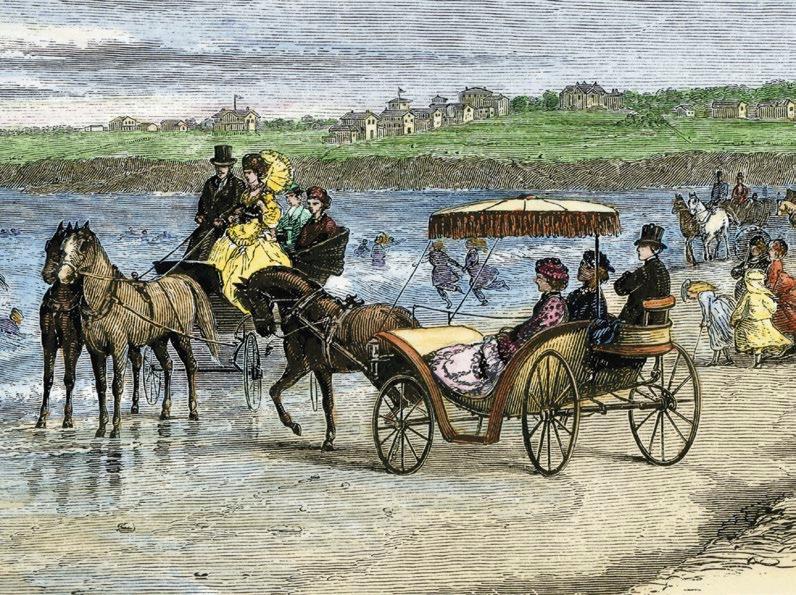
his work on phototherapy to treat diseases such as lupus.
Nevertheless, as the 20th century began, the British establishment still feared that the bright sun in the far reaches of the Empire was giving pasty Brits tropical neurasthenia— causing fatigue, irritability and even death. At home, a tan was still not fashionable in polite society. Wellborn ladies bought beauty products that promised to remove accidental tans and pesky freckles.
THEN, IN 1923, style icon Coco Chanel caught the sun on a yacht trip from Cannes—and inadvertently

launched a fashion for tans. For the first time, a tan hinted at leisure time, money to travel to sunnier climes and good health. It represented glamour, not peasantry.
Soon celebrities and socialites were flocking to hot destinations to work on their tans. In 1927, perfumer Jean Patou introduced a tanning oil. After the First World War, British workers surged to the coast on their days off and lidos became hugely popular.
THE CHANGING FACE OF SKIN COLOUR
2613BC–2494BC In Egypt, Prince Rahotep’s wife Nofret used resins from frankincense trees to keep her skin pale.
1500s Every day, Elizabeth I painted her face with white lead to produce snow-white skin, indicating wealth and high class.
1920s Silent-film star Clara Bow used pale foundation and powder to achieve her much-admired pale skin.
1940s Movie star Mae West famously protected her alabaster complexion by avoiding sunlight and cigarette smoke.
1950s Elizabeth Taylor was renowned for her porcelain skin.
1960s Bridget Bardot rose to fame. Posing on the beach, she became synonymous with the bronzed skin and glamour of the French Riviera.
1982 Pop group Wham’s orange tans, white teeth and shorts epitomised fun and optimism.
1990s Pamela Anderson’s golden tan and iconic red swimsuit in TV series Baywatch raised temperatures all over the world.
2000s The tabloids were full of male and female celebrities in various shades of orange, including Cristiano Ronaldo.
2011 Homeland star Damian Lewis bucked the trend to become a pale-skinned, red-haired heart-throb.
2013 Fake-tan fan Katie Price was turned away from a tanning salon because she was pregnant.
2014 The Daily Mail mocked socialite and hotel heiress Paris Hilton for her “radioactive” fake tan.
2015 Aussie actress Nicole Kidman claimed her delicate skin colour made her who she is. Too pale to spend her childhood on the beach, she took up acting instead.
2016 Other pale and high-profile celebrities include Keira Knightley, Gwyneth Paltrow and Lily Cole.














The Fifties marked the start of a new age of sun-worshipping; in 1979, Bo Derek was the ideal tanned woman in the film 10
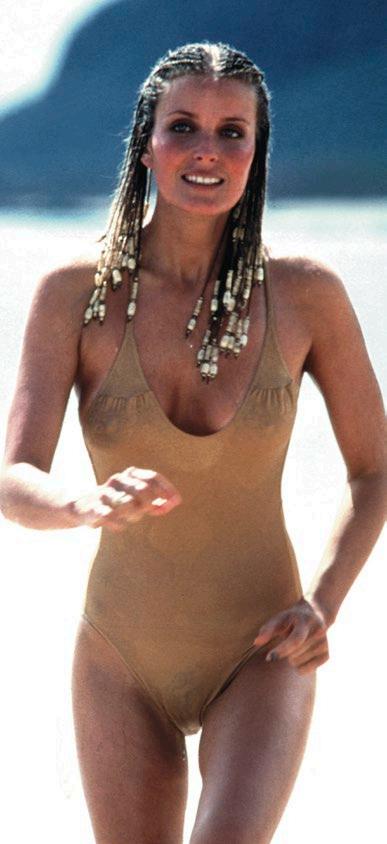
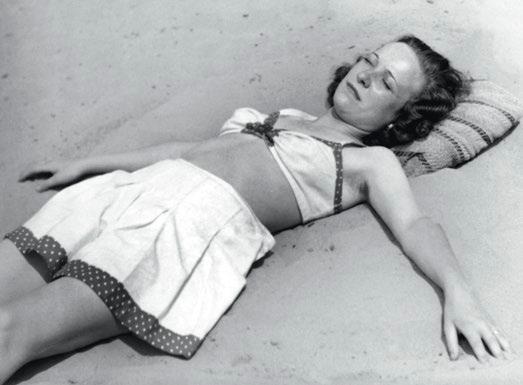
But the Depression and Second World War meant that the closest most women got to sun-bathing was staining their legs with Bovril or tea.
It was the Fifties when the new Bronze Age really began: swimming costumes became less modest and a 1953 Coppertone ad admonished “Don’t be a pale face”.
Man-Tan also exploded onto the market. This macho-sounding product marked the start of the huge tan-without-sun craze. It contained dihydroxyacetone (DHA), a chemical derived from sugar cane that reacts with amino acids on the surface of the skin. There was a rumour that its tanning properties were discovered when a nurse treating a diabetic patient with DHA accidentally spilled it on his chest.
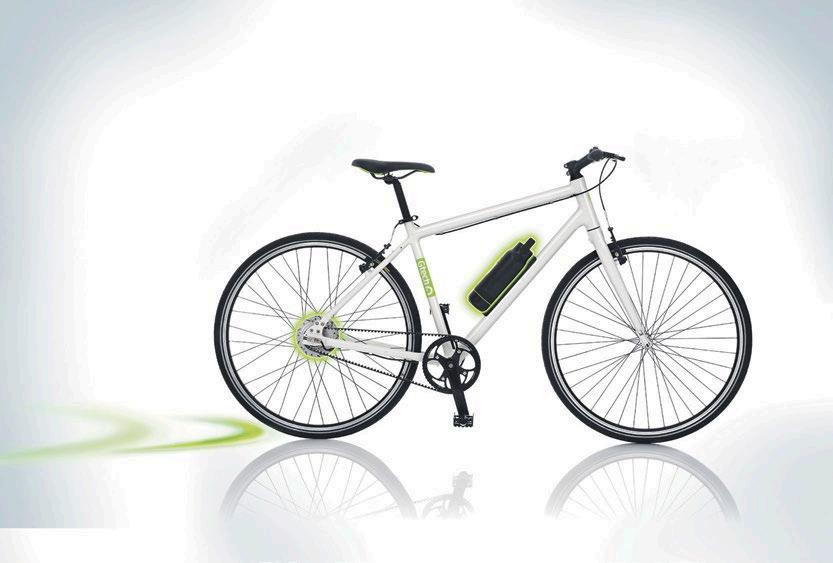


Tempted to rediscover cycling, but put off by the thought of struggling up hills? Give the new Gtech eBike a try...
The Gtech eBike cleverly boosts your pedal power whenever you need it; hills will feel atter, you’ll be able to explore further and arrive fresher.
Boost your pedal power
At the heart of the Gtech eBike is our latest Lithium-ion battery, the same lightweight, high performance technology that is used to power electric cars – giving you a range of 30 miles. Plenty for a day’s adventure or most trips to work and back.
A built in computer continually measures your pedalling, smoothly adjusting the power delivered to the maintenance-free motor, giving you a boost when you need it. Everything is automatic; if you pedal, the bike will help you up to 15mph, but you can pedal harder if you like and go faster. You will feel its power most if you reach a hill and start to slow down.
Pure simplicity
Riding the Gtech eBike is very simple, you pedal to go faster and brake to slow down. There are no confusing gears and the oily chain has been replaced by a clean carbon belt drive as used on high-performance motor cycles.
The battery easily removes from the frame for charging. A mains charger is supplied, which will fully recharge the battery from at in just 3 hours. The eBike has an easy to read LED display, to tell you how much charge you’ve got remaining.
You can choose from two cruising speeds at the touch of a button, or turn the power off to ride it like an ordinary bike.
Aviation grade, lightweight aluminium frame
The frame of the Gtech eBike is made from the same material used in modern aircraft –light, strong and designed to last. The aluminium alloy is also rust resistant, capable of withstanding the elements whether you are using the bike on roads or country paths. Thanks to its lightweight construction, the Gtech eBike weighs 16kg, so you can ride it easily with or without the power turned on.
Save money. Save time.
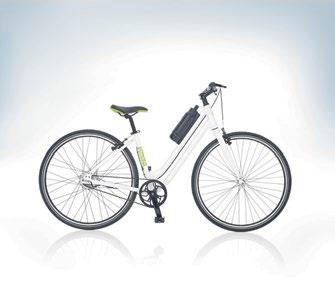
The average cost of a car is £3,500 per year*, and the average cost of a London travel card is £1,800 per year.∆ The Gtech eBike costs less than 4p† to charge, and there’s no road tax or insurance to pay. You’ll also be out there, getting tter, rather than stuck in a traf c jam or on a crowded train.

In the Sixties, affordable air travel, colour film and the allure of sunbathing attracted increasing numbers of Brits to “The Med”. The Beach Boys’ music made us all want to hit the sand.
By the Seventies, our magazines and movies were full of tanned stars, all epitomising the good life. A Malibu Barbie even emerged. However, there was a twist in the tale of tanning when dermatologists noticed a surge in cases of skin cancer. Research into the effects of UV rays on our skin made the link between extreme sun exposure and skin cancer. Sunlamps and tanning beds became more and more popular in the 1980s—until we were told that they too were dangerous.
NEVERTHELESS, MANY OF US
still love being in the sun. It makes us feel and look good—in the short term, at least. And of course our media is ablaze with perma-tanned male and female celebrities. Fifty per cent of Brits said that getting a tan was their number-one reason for going abroad, according to a 2000 survey.
Mind you, we have a distinctly love-hate relationship with the Tango’d celebrities around us—and the attitude now is that too much of a tan is frankly rather common. In 2004, The Sun mockingly matched deeply tanned celebrities, such as pop star Peter Andre and model Katie Price, to colours on a Dulux paint chart.
The discussion about tans heated
PROTECT YOURSELF FROM THE RAYS
n Dr Jana Witt, Cancer Research UK’s health information officer, says, “Enjoying the sun safely and avoiding sunburn can reduce your risk of malignant melanoma, the most serious form of skin cancer.”
n The best way to protect skin when the sun is strong is to spend time in the shade between 11am and 3pm, and to cover up with clothing including a t-shirt, hat and sunglasses.
n “Use a sunscreen with at least SPF 15 and four or more stars. Put plenty on and reapply it regularly,” says Dr Witt. “An adult needs about two teaspoonfuls to cover the face, neck and lower arms.”
n She adds that sunscreen isn’t as effective as shade or clothing—and shouldn’t be used to stay in the sun for longer.
up when the word “tanorexia” (meaning a physical or psychological dependence on sunbathing) was introduced into the English language, and organisations including The Skin Cancer Foundation reported that UVR exposure releases moodlifting endorphins that can build up a “tanning addiction”.
A prominent BBC News feature went on to ask, “Fake tan: How did it become the new normal?” and then, in 2012, Cancer Research UK announced that skin-cancer rates are soaring in the UK—and those

aged over 50 are worst effected by malignant melanoma, the most dangerous type of skin cancer.
ALTHOUGH
MOST OF OUR HIGH STREETS still have tanning shops, tanning seems to be fading in popularity. Thankfully, in 21stcentury Britain, our definition of beauty ranges across all skin tones,

Actress Nicole Kidman is proudly pale; (left) spray tans are declining in popularity today
from the perma-tanned to the gothically pallid. A host of celebrities are very proud to be pale, including British actor Damian Lewis and Australian A-lister Nicole Kidman.
In our cosmopolitan and globalised society, we happily have icons for every skin tone. Perhaps in the future, this time period will be reflected on for another cultural shift—that is, when we all learned to look and feel good in our own skin. A sunny day or two wouldn’t go amiss, though…
it to me. I never said I liked anything around him again.
…GETTING TO KNOW THE REAL
ELIZABETH TAYLOR. We just clicked. She was just as beautiful in the flesh as she was on screen and huge fun. I remember one time I asked her what she smelled like and she whispered, “Like my perfume.” I have no idea if she was trying to seduce me, but whatever it was, it was very nice!
I was blown away by how incredibly kind, sweet and generous she was. But I don’t think that’s a side of her that the public bought into. She didn’t help her image much by wearing all those huge diamond rings. But I was crazy about her.
…MY COMEBACK AS A PORN
KING. Boogie Nights resurrected my career and I was nominated for a best supporting actor Academy Award. But I admit that, at first, I tried my best not to do it and I kept turning the director down. I thought glamorising pornography was terrible idea.
…PUTTING THE RECORD
STRAIGHT. Having a few scores to settle was part of the reason behind my book. I don’t think I got it all in there, but I felt I had some things to say. It was very cathartic and I felt better after writing it. As told to Ruth Huntman
But Enough About Me (£8.99, Blink Publishing) is out now in paperback
EMPLOYEE OF THE MONTH
Shane works in a supermarket deli. He doesn’t seem to have grasped the rules of his job—as revealed by the notes left by his manager:
“Shane, stop putting out samples labelled as ‘mystery meats’.”
“Shane, stop asking, ‘Is this your final answer?’ and offering to let customers phone a friend after each order.”
“Shane, stop putting on multiple name tags and pretending you have a personality disorder.”
“Shane, any free samples you offer must come from the deli department— not electronics!”
“Shane, I don’t know what ‘swinecraft’ is, but ham cannot be sold as building material.”
SOURCE: THEPOKE.CO.UK
How To Become Sun-Savvy
BY SUSANNAH HICKLING
Susannah is twice winner of the Guild of Health Writers Best Consumer Magazine Health Feature
WE ALL THINK WE KNOW what we should and shouldn’t be doing when we grab a few rays. But do we? Skin cancer is still on the rise, so it’s time to follow the rules and stay safe in the sun.
DO…
■ Lather on the protection whenever you go out in the summer months.
■ Reapply sun screen every two hours. If you’re in the water, slap it on immediately after drying yourself, as towel drying removes even water-resistant products.
■ Reapply if you’ve been sweating.
■ Use at least two tablespoons’ worth of sun screen each time.
■ Apply that sun-protection factor (SPF) to all those places you don’t think are exposed to the sun—like between your toes and behind your ears. UV rays bounce around, so every part of you needs protection.
■ Give up on that tan, once and for all. The UV rays that give you that golden glow are the same rays that are responsible for sun spots, wrinkles and, worst of all, skin cancer.


DON’T…
■ Go below Factor 30.
■ Confuse SPF with UVA protection. The SPF rating refers to the protection your sunscreen offers against UVB, whereas there’s a separate star rating (up to five stars) for protection against UVA rays, which also cause skin cancer. Pick a potion with high ratings for both.
■ Use an old bottle of sun screen. The contents lose their strength over time.
■ Think you’re safe inside. UVA rays can penetrate glass.
DITCH THE BED
People who use tanning beds are 74 per cent more likely to develop melanoma than those who don’t, according to a University of Minnesota study. So don’t think it’s safer to get a summer glow that way. Opt for a spray tan every time.
SWAP AND DROP
To cut calories, swap summertime classics for fab foods—and drinks— containing less fat.
SWAP THIS… …FOR THIS CREAMY COLESLAW
Steer clear of heavy dressings that weigh down this otherwise healthy salad.

ICE CREAM
Full-fat ice cream is hard to resist, but crushing cravings is easy if there’s a good substitute.

PINA COLADA
Creamy cocktails are big calorie culprits, so it’s best to choose wisely.

VINAIGRETTE COLESLAW
Instead, make your own using olive oil and vinegar. For added creaminess, stir in plain yogurt.

SORBET
Sorbet is a fruity and light alternative. Blend and freeze your own in your favourite flavours.

MOJITO
A lighter choice with rum, lime, fresh mint and soda water over lots of ice.


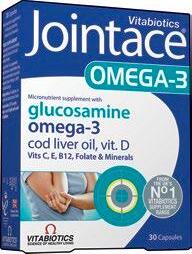







Spring all year round...
If you are looking for a daily supplement to give you extra support from within, Jointace® has been specially formulated by Vitabiotics’ experts to provide premium nutritional care. With a unique combination of nutrients, and vitamin C which contributes to normal collagen formation for the normal function of bone and cartilage.
Men’s Health: Why Don’t Men Live As Long As Women?
The answer, according to the UK’s mortality stats, is heart disease, which kills a little over 15 per cent of men. But cutting your risk needn’t be a chore.
DRINK TEA. Black or green, it doesn’t seem to matter, but draining at least two cups a day appears to help your heart, according to numerous studies.
DOWN A BEER ONCE A DAY. A study in the Journal of Agricultural and Food Chemistry found that men who drank one beer a day for a month lowered their cholesterol levels, increased levels of hearthealthy antioxidants in the blood and reduced their fibrinogen, a protein that contributes to blood clots.
EAT BAKED BEANS. By including legumes such as beans or peas in four meals every week, you could slash your risk of cardiac problems by 22 per cent, research has found.

HAVE MORE SEX. Making love counts
as physical activity, which is of course good for your ticker. Perhaps this is why Bristol University researchers found that men who have sex at least twice a week are less likely to have a stroke or cardiovascular problems.
GO TO BED AN HOUR EARLIER. More zzzs, less heart disease is the message coming out of the world of medical research. Men who sleep less than six hours have a higher risk of dying of a heart-related problem than guys who sleep for seven or eight. However, slumbering for nine hours or more isn’t good for you either.
BOOK SOME TIME OFF WORK.
American researchers analysed data on more than 12,000 middle-aged men from the famous Framingham Heart Study, and found that those who took regular holidays sliced their risk of death from heart disease by a third.
DEATH IS AN EMOTIONALLY DIFFICULT SUBJECT and for many of us is still taboo, so it’s unsurprising that we often deal only with practicalities as they arise. Yet planning your funeral now helps offer protection to you and your loved ones in the future. With the price of the average funeral plan projected to rise from approximately £3,609 today to over £5,000 in 2021*, it definitely pays to think ahead.
Act today to guard against predicted price rises and take advantage of our special reader offer: £175 off any of Co-op’s fully guaranteed Pre-paid Funeral Plans such as Co-op’s new Simple Funeral Plan at £2995.✦
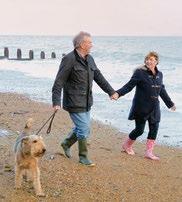
WHY CHOOSE A CO-OP PLAN?
Co-op Funeralcare is the UK’s leading provider of funeral services, with more than 80 years’ experience of providing and arranging the highest quality funerals. They have 1,000 UK-wide Funeral Homes and provide expert advice 24 hours a day, seven days a week.
■ Spread the cost of paying up to 25 years—this could mean a fully guaranteed Plan for as little as £15 a month, less than 50p a day** Choose
Unlike some Funeral Plan providers, Co-op guarantees to cover essential thirdparty costs for both burial and cremation so that your loved ones will have nothing more to pay for the services in your Plan, no matter how much they increase***.
CO-OP FUNERAL PLAN OPTIONS
Co-op Funeralcare has a range of fully guaranteed Plans to suit your needs and budget that start at £2,995. You can go into as much or as little detail as you like with your Plan—if you wish to create your own special tribute, Co-op also offer a Tailormade Funeral Plan available from your local Co-op Funeralcare.
FLEXIBLE PAYMENT OPTIONS:
■ Interest-free instalments over six and 12 months
✦ Terms & conditions: Discount is only valid for Pre-paid Funeral Plans purchased between 10 July 2016 and 10 September 2016 (inclusive). e promotional code for this advert is PRE223. e Promoter is Funeral Services Limited (30808R) trading as Co-op Funeralcare, with registered o ce at 1 Angel Square, Manchester, M60 0AG. Full terms and conditions can be found at www.co-operativefuneralcare.co.uk/ readero er’ * Mintel Consultancy Services ** Based on a Simple Funeral Plan over a 25 year term
*** As prices and availability vary across the UK, Co-op burial Plans do not include the cost of buying a grave
8 Easy Ways To Improve Leg Strength
1 Clench your bum when you stop at traffic lights. As you wait, tighten your thighs and bottom over and over again. It’s worth it, as stronger leg muscles will help you accomplish more every day, especially as you get older. You’ll climb stairs more easily, squat to pick things up and protect your back from injury.
2 Do leg lifts as you cook dinner. Flex your foot and lift your leg out to the side, lower it, then repeat ten to 15 times. Make sure you move only at the hip and don’t let your waist move. Then swap legs.
3 Step up on a stool to get something off a high shelf. Not only will you strengthen your pins, you’ll also avoid straining your back by reaching up.
4 Climb the stairs three at a time. This strengthens the gluteal muscles in your bottom and revs up your heart rate, boosting cardiovascular fitness. What’s not to love?
5 Do the twist. Twist again like you did, well, a few summers ago! This time it’s to help you burn a few calories and build up your leg muscles. To avoid embarrassing the younger generation, do this dance
in your living room and not at the next family wedding!
6 Add a hill to your walking route. As you trudge up, you’ll feel the muscles in the backs of your legs working hard to push off every time you take a step.
7 Lunge across the garden. Your neighbours might find it funny, but you’ll have the last laugh when you sculpt a toned pair of legs with just a few minutes’ effort every day. During each step forward, bend your knees and sink down until both legs form 90-degree angles. Then press into your front heel to rise. Lift your back leg and knee all the way into your chest before placing it in front of you for the next lunge.
8 Organise a tiptoe contest. Every other day, challenge your children, grandchildren, partner or friends to rise onto the balls of their feet and walk across the room. Whoever lowers their heels to the floor first loses. You’ll have lots of laughs and strengthen your arches, ankles and calves at the same time.

Chianti And Misconceptions
BY MAX PEMBERTON
Max is a hospital doctor, author and newspaper columnist
I HAVE A LOW THRESHOLD FOR BEING SCARED. Never mind hiding behind the sofa throughout an episode of Dr Who, I’ve been known to reach for a cushion during Miss Marple. You’d imagine, therefore, that I’d be a jabbering bag of nerves when I started work in a secure unit for the criminally insane. Clearly I’m going to get murdered and they’re going to eat my liver with a glass of Chianti, decided friends and family alike.
But of course this wasn’t the case. None of the patients were wearing Hannibal Lector masks when I walked in on my first day, and Jodie Foster certainly wasn’t evident. The patients in this unit are here because they’ve become mentally unwell and then broken the law. It’s been decided that they should receive treatment rather than punishment, which seems entirely appropriate given that they were incapable of making rational decisions at the time they committed their crimes.
AFTER A DAY ON THE WARD, my prevailing feeling was of sadness at how mental illness can destroy lives. The patients are on medication to treat their mental illness and seem very pleasant. One of them even made a card to welcome me.
Over the years, a number of my friends have expressed amazement that, given my low startle point, I was able to survive working in mental health.
“Isn’t it really scary with all those nutters?” they’d ask.

No, is the simple answer. It’s many things: frustrating, sad and often rewarding, but it’s not scary. Even when someone is acutely unwell, they’re far more scared of you than you are of them.
But the image of axe-wielding maniacs is pervasive in our society, and cases reported in the media when tragedy strikes and a person with a mental illness injures or kills someone do nothing to dispel this. These stories help to fan the flames of fear held by the general public that mentally ill people, especially schizophrenics, are all dangerous. It’s easy to forget that what makes stories like this worthy of news is the very fact that they’re so rare.
In fact, schizophrenics do pose a significant danger: to themselves.
One in ten people with schizophrenia kills themselves. The isolation they experience as a result of the stigma of mental illness is thought to be one of the main contributing factors.
WE NEED A LITTLE PERSPECTIVE
on these things. Of the tiny number of people killed by those with mental illness, most are family members or acquaintances. Far more people are killed as a result of domestic violence, and yet we don’t get in a jitter when someone gets married.
As human beings we tend to fear what we don’t understand, and this is the case with mental illness. In fact, alcohol intoxication is implicated in far more murder cases than mental illness. Think about that next time you sit down for a nice glass of Chianti.
MEDICAL MYTHS—BUSTED!
You Should Wait An Hour After Eating Before Swimming
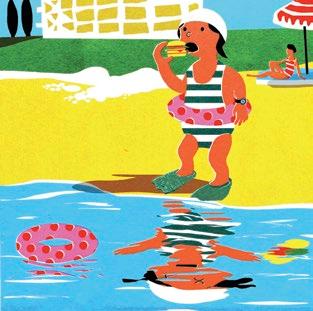
WHERE DID THE MYTH COME FROM?
I vividly recall the frustration as a child of being on holiday and having to wait a whole hour after lunch before we were allowed back in the sea to swim. My sister and I would plead with our mum to let us at least paddle. But the temptation to go deeper and deeper was just too much, and before we knew it we’d be on our fronts and our mum would be on the shore shouting at us to stop. I seem to recall that we were warned that at best we’d be sick and at worst we’d
drown. This worry is based on the idea that when you’re digesting food, the body diverts blood to the stomach. This weakens the muscles, making them liable to have cramps and thus get into difficulty when swimming.
WHAT’S THE TRUTH?
There’s not a single official medical organisation or group anywhere in the world that expresses concern or warns about this. There are also no recorded cases of food being cited as a reason for someone drowning. From a medical perspective, it’s true that after a meal blood is diverted to the stomach, but it doesn’t happen to the extent that the muscles in your limbs are unable to work properly.
SO THERE’S NOTHING TO WORRY ABOUT?
While any sort of vigorous exercise can be uncomfortable after a large meal, there’s no special reason why you can’t enjoy a leisurely dip after eating. Cramps can occur at any time, regardless of food consumption.
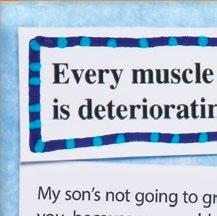
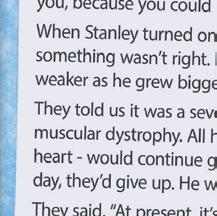
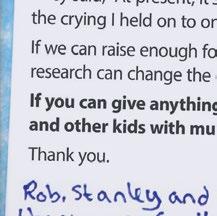
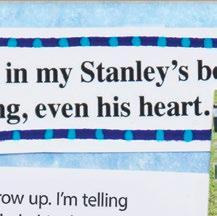

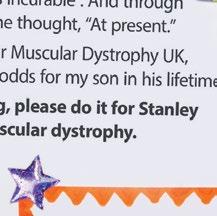
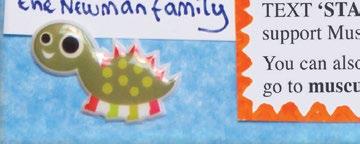

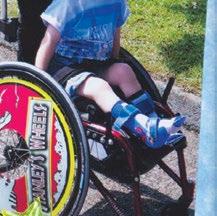
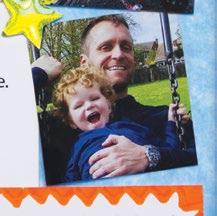

This space has been dedicated to the families of children with muscular dystrophy to tell their stories and help save young lives.
*Texts cost £10 plus one message at your standard network rate. Muscular Dystrophy UK will receive 100% of your donation. Make sure you obtain the bill payer’s permission. For further information, call 020 7803 4800
With health practitioners busier than ever, communication is essential to getting the best care
How To Talk To Your Doctor
BY MARY F HAWKINSAT ONE TIME OR ANOTHER, most of us have complained about feeling dissatisfied with a visit to the doctor’s surgery. And when I hear people voicing their concerns, I’m convinced that part of the problem lies in our difficulty speaking honestly with health practitioners.
Here are tips for conveying your needs, so your time with the doctor is as helpful as possible.
HUMANISING YOUR DOCTOR
We expect a lot of health practitioners: to spend a reasonable amount of time
with us, to communicate effectively, to be in a good mood and to have answers to all our medical questions.
If you ask patients whether these expectations are met, some will say yes, but the majority feel let down. Why? It may be that our expectations are unrealistic, or it may be the result of a breakdown in communication.
Patients often think of their doctors as infallible, but open conversation can change that. If we see our physicians as ordinary people, our expect ations will become more realistic.
For example, when a patient visited her doctor for a cold, the doctor was
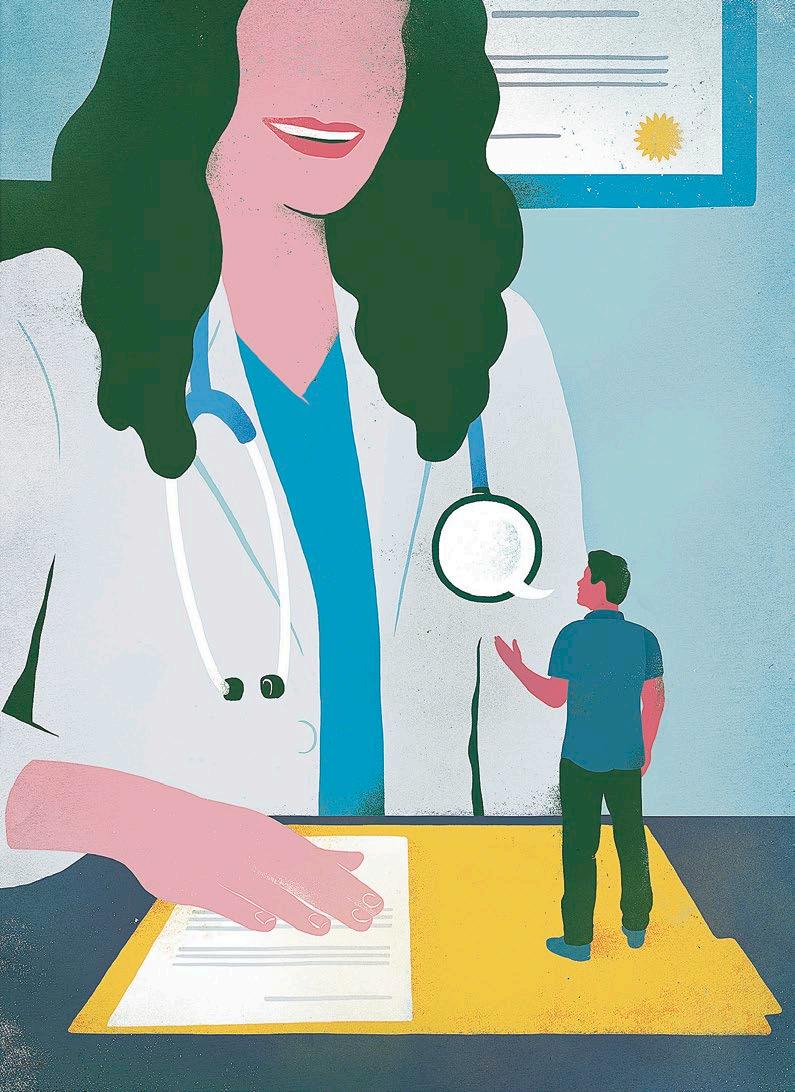
annoyed with her for taking up valuable time. The patient was surprised that he would speak to her so irritably. When he saw her reaction, the doctor apologised. He explained that he had a heavy patient load that week and was also worried about his young daughter, who was sick. The patient realised that perhaps her doctor had a point about a needless visit and that he, too, had personal stresses.
COMMUNICATING DISCOMFORT
Tell your doctor if you feel uncomfortable with any aspect of your care. You may be uneasy with groin, rectal or breast examinations, for example. A doctor will usually understand and try to decrease your nervousness.
The problem could be your own aversion to invasive procedures, which isn’t uncommon. If this is the case, you could try thinking or chatting about other things during such exams. Joking can help both the patient and doctor relax. If, however, you still don’t feel at ease, it might be time to consider finding another doctor.
FEELING IGNORED OR DISSATISFIED
Expressing how you feel to your doctor is important. However, not everyone is open to hearing your criticism, especially if that person is the target. Choosing the right time is important, as is figuring out how to make your point without causing offence. The old
adage that you can catch more flies with honey than vinegar rings true, as long as there’s sincerity.
Suppose you feel that your doctor doesn’t grasp your symptoms accurately. You decide he or she is being obstinate and unwilling to hear what you have to say, and perhaps you’re right. However, you might be able to get your message across by saying, for instance, “Doctor, for some reason, I don’t seem to be describing my symptoms clearly. I wonder if there’s some other way I could describe them to help you understand.” This would give your doctor an opportun ity to recognise that he or she isn’t on the same page as you.
EXPLORING YOUR FAMILY MEDICAL HISTORY
We often forget to inform the doctor about crucial family information that might affect diagnosis, prognosis, intervention and even medical treatment. There are many conditions with hereditary factors, such as heart disease, stroke, mental illness and certain types of cancer. If your doctor knows about these patterns, you can discuss which symptoms to watch for and which preventive steps to take.
Imagine that a patient becomes concerned about her risk of a stroke, so she books an appointment with her doctor to discuss it.
“I had no idea about the history of strokes in my family until my grandfather’s last year,” she says. “My mother
told me that her own grandfather had died of a stroke too.”
“I see,” says the doctor, taking notes. “I’m glad you’re telling me now. Better late than never.”
“Then a friend told me that chronic stress can add to the risk,” says the patient. “I have a highstress job, so I began to worry.”
“I think it’s premature to start worrying,” says the doctor. “A family history of stroke is no guarantee that you’ll
practitioner. It allows for early detection of potentially serious conditions and will give your doctor the opportunity to hear about any worries you might have.
Often, we don’t let the doctor know of the upsets and stresses in our personal lives, even though they might contribute to changes in our health. Emotional problems can, for example, aggravate depression, migraines, backaches, fatigue and stomach pain.
IT CAN BE DIFFICULT TO COMMUNICATE DEGREES OF PAIN TO A DOCTOR
have one too, and there are lots of things you can do to reduce your risk.” She explains some of the lifestyle factors the patient could control, before finishing up by saying, “You were right to tell me about this possibility. It gives me a good frame of reference and means we can work together to keep you as healthy as possible.”
The patient leaves the doctor’s office feeling relieved—and with a lot of accurate information about strokes.
DISCUSSING SYMPTOMS
You should take note of any changes in your body—such as unusual lumps, rashes or persistent pain—and be sure to communicate them to your health
“Doctor,” says a patient, “my headaches have become a lot worse since my wife and I separated last month. They’re interfering with my work, and I’m finding it difficult to concentrate. I’ve tried taking over the count er painkillers, like you suggested last time, but they don’t seem very effective. I don’t know what to do.”
“Oh,” says the doctor, “I didn’t know last time about all these changes in your life. They could be increasing your tension levels, which could be a reason for your headaches. How about I check a few other things?”
As she measures his blood pressure, she asks the patient to tell her more. The patient describes how he feels
about the break up of his marriage and the stresses of his job. By the end of the visit, he feels more relaxed about his situation.
DESCRIBING HOW YOU FEEL
It can be hard to describe how you feel and communicate degrees of physical or emotional pain. Sometimes using a comparison or an analogy might help, such as:
• “It feels like my shoulder has been pierced by an arrow.”
• “My stomach feels bruised.”
• “My muscles feel as if they are on fire.”
• “I feel a crushing sense of responsibility, as though I’m carrying a heavy backpack.”
There are many words or images you can choose; the point is to find a way to describe exactly how you feel.
For example, after an accident, a patient felt as if his knee would explode. “I can see that you’re in a lot of pain,” said his doctor. “Where does it hurt most?”
“Here,” said the patient, pointing to the side of his knee.
The doctor gently touched the knee. “It’s quite swollen,” she said.
“It’s burning, throbbing,” said the patient. “Please give me something to ease the pain.”
“First, tell me how deep the pain is,” said the doctor. “Can you describe it?”
“It feels as though a knife is piercing a nerve.”
DO YOU COMMUNICATE WITH YOUR DOCTOR EFFECTIVELY?
Select the answer that best describes you. The more you tick “yes”, the better the quality of your communication with your doctor. “No” answers indicate areas for improvement.
Do you offer your doctor a complete medical history? Y N
Can you find words to describe your symptoms and how you feel?
Do you get your point across?
Do you make lists of questions to ask your doctor?
Do you understand the advice your doctor gives you? Y
Do you negotiate with your doctor when you have differing opinions? Y
Do you tell your doctor if you are dissatisfied with the care you receive?
Y N
Do you feel satisfied with the service your doctor provides? Y N
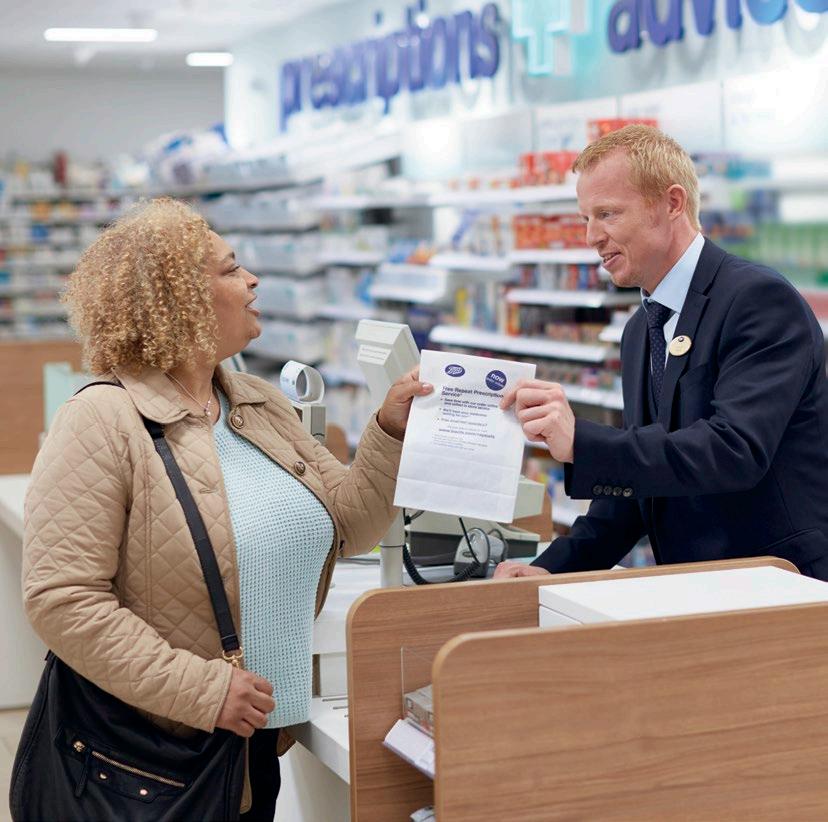

“I see,” said the doctor. “Has it been a gradual onset?”
“It started slowly,” said the patient. “But then it suddenly got worse.”
In this way, the patient gave his doctor a picture of his pain that allowed for appropriate treatment and speedier recovery.
PARAPHRASING
Putting what you hear into your own words is an element of good listening. It’s also a great way to check that you understand what your doctor is telling you.
A patient had an active life before she became plagued with chronic pain and low energy levels. She was no longer able to participate in sports and other exercises with the same enthusiasm as before. Eventually, she found a GP who diagnosed her condition as fibromyalgia, which involves chronic sore muscles, tiredness and mental fogginess, along with other symptoms.
“Make sure you stretch before you exercise,” said her doctor. “You might
also want to reduce the intensity of your exercise regime for now, to see how your body responds.”
He handed her some leaflets. “Here’s some more information you can read when you get home, and we can talk about it some more at your next appointment.”
“OK, let me get this straight,” said the patient. “I should take some time away from my regular sports, which are fairly intense. Then I should report back to you on how I’m doing. Is that right?”
“Right. Your next appointment should be in two weeks.”
“Will that be my last visit?”
“No, I think I should follow up for a little while,” said the doctor. “There are all kinds of options to explore, such as attending support groups and changing your diet. For now, start with those leaflets I’ve given you.”
If we’re mindful listeners in these patientdoctor exchanges, we’ll avoid frustration and misunderstanding, and experience better results.
SPEAKING OUT
We all have our head-in-the-clouds moments:
“I guess I’m gonna fade into Bolivian.” Mike Tyson
“It’s clearly a budget, it’s got a lot of numbers in it.” George W Bush
“I’ve been noticing gravity since I was very young.” Cameron Diaz
SOURCE: SADANDUSELESS.COM
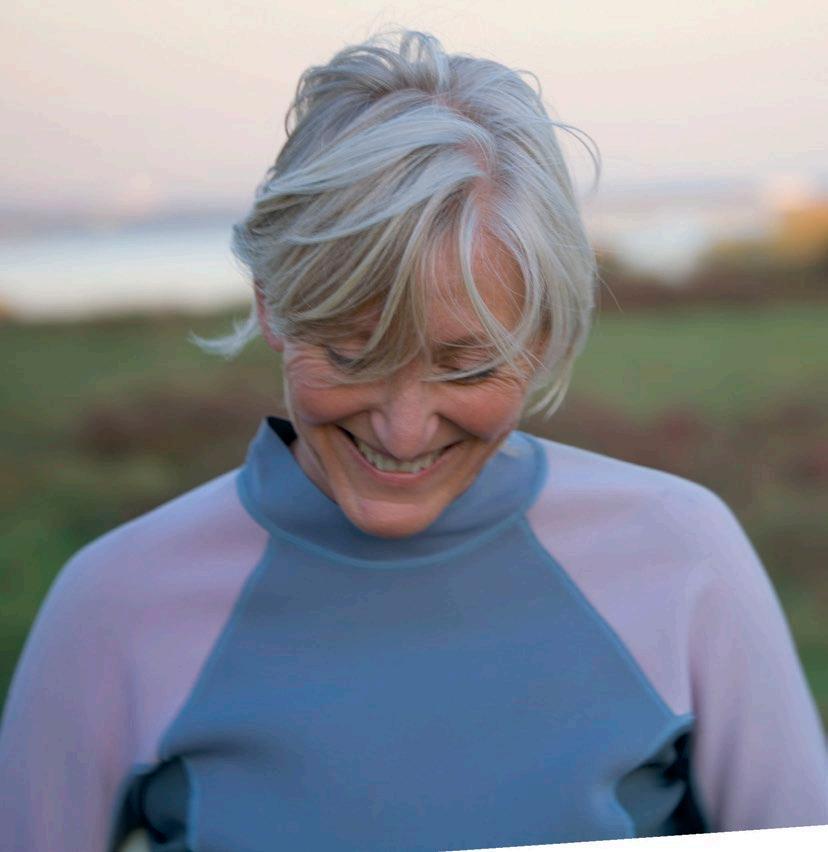
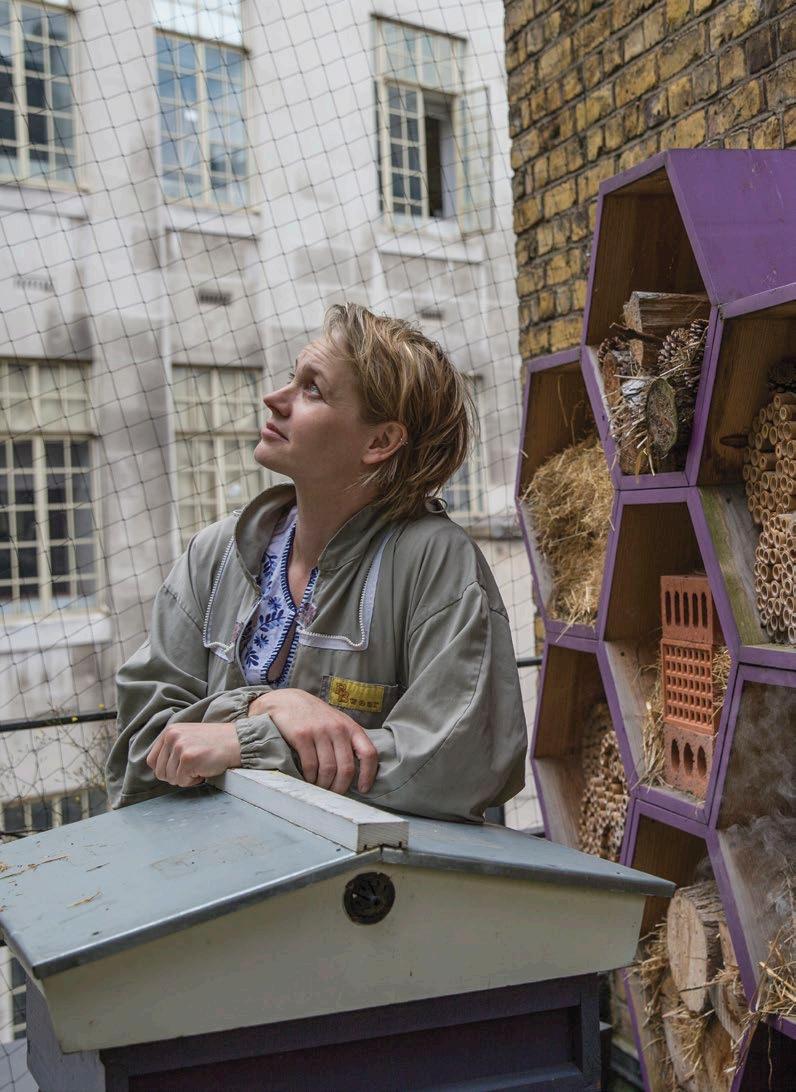
“EachUrban beekeeper Camilla Goddard. colony has its own personality”
Passing BUZZ on the
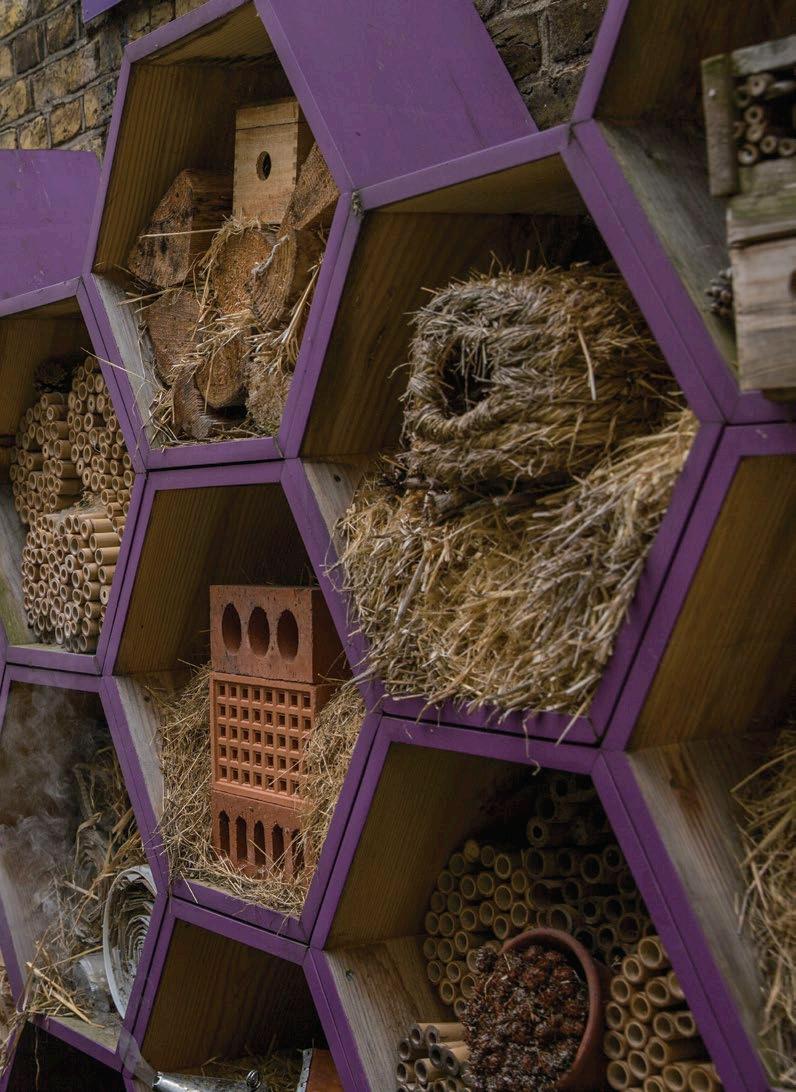
Far from being an old-fashioned pastime, beekeeping may well be essential to ensuring our future
BY CHRISTOPHER MIDDLETONIT SEEMS TOO FAR-FETCHED
to believe. Here in the middle of London, less than 100 yards from Scotland Yard, something extraordinary is going on. Listen hard and above the noise of the traffic you can hear a loud and unmistakable sound—not just of humming, but of frantic buzzing. It’s the sound of many thousands of bees doing what they do best: making honey.
What’s more, they’re performing their magic not in the leafy acres of nearby St James’s Park, but up on the balcony of the palatial, £329-a-night St Ermin’s Hotel in Westminster. Whereas most urban residences would do their very best to keep sting-bearing insects as far away from paying guests as possible, this hotel opens its doors to the capital’s bees.
Within certain limits, of course. The person who tends to the needs of the 300,000 or so patrons at this “Bee and Bee Hotel” is Camilla Goddard. Far from being a rustic beekeeper, Camilla, 43, tends to some 70 hives. Many of them are in surprisingly urban locations, including Notting Hill Gate and even, at one point in her career, a roundabout in Lewisham. At St Ermin’s Hotel, there are six hives.
“I began with a colony in a wood in Kent,” she recalls. “Later, I started to keep bees in London. In many ways, it’s a bit like farming. You’re always outdoors, often on rooftops in town, like here. And after a while, you listen to the hive and you can hear what
The hexagonal biomes of the “Bee & Bee Hotel” have condominiums to cater to solitary bees and boxes for the more social varieties
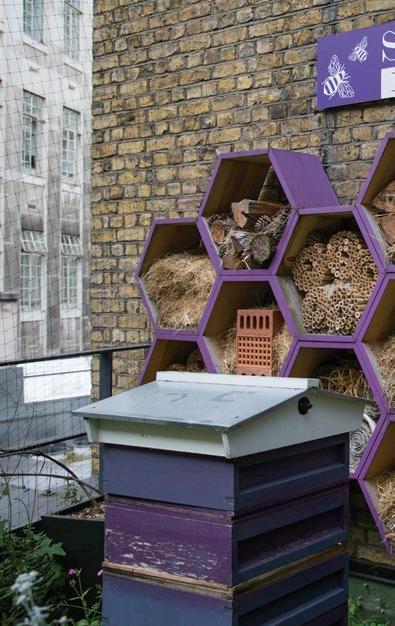
they’re feeling. Each colony has its own personality, its own mood.”
Lest it sound too idyllic, the job isn’t without its dangers. “You get used to stings,” she says. “The best thing to do is to knock the bee off, otherwise the toxins keep on pumping in. I find the simplest treatment is to rub the skin with icing sugar.
“In the long run, though, bees are amazing creatures to work with. You can’t help admiring the way they

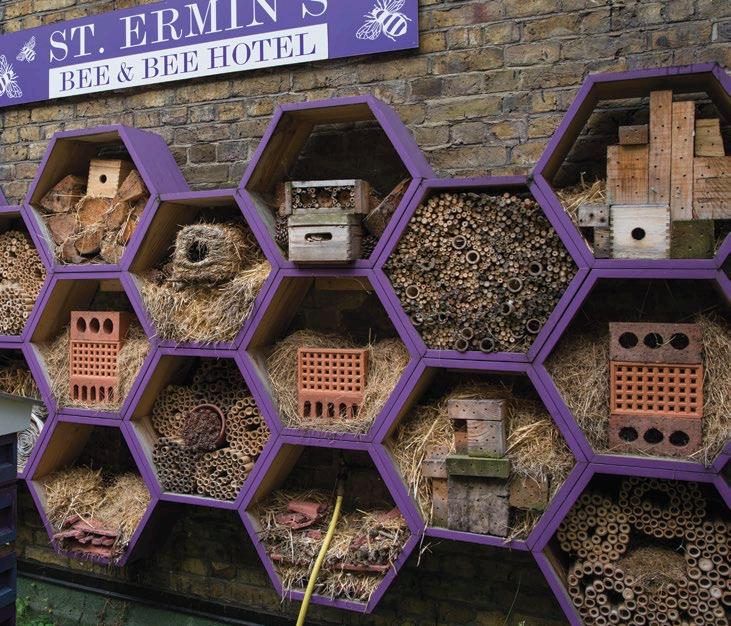
operate. They really do put the good of the community first.”
AS WELL AS PROVIDING an enjoyable pastime (not to mention jars of delicious honey), beekeeping is becoming increasingly critical. According to the British Beekeepers Association (BBKA), 70 different UK crops depend on bees for pollination.
“Bees are in danger of disappearing from our environment,” warns Tim
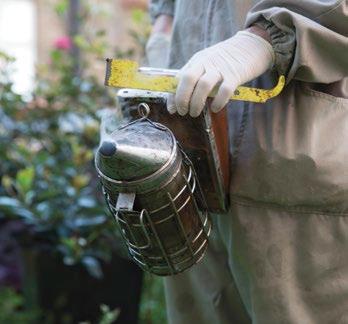
Lovett of the BBKA. “It’s only the care and treatment provided by beekeepers that’s keeping colonies alive. Attitudes must change, and a new generation needs to be educated about the value of bees and the threats to them.”
This is a grave issue, not least because our existence rather depends on their existence. Indeed, it’s been calculated that if the bee disappears from the world, then we’d only have four years of life left. Says Camilla,
“Without bees to provide pollination, one third of all our food wouldn’t survive. That’s their value, yet people don’t realise it.”
It’s estimated that the value of the pollination amounts to £200m per year. And this with a diminished winged workforce: at the end of the Second World War, there were 400,000 bee colonies in Britain and some 80,000 beekeepers. During the war, Winston Churchill was a staunch supporter of bees and made sure they got extra supplies so they could carry on with their pollination work, even as the Luftwaffe dropped their bombs.
Today, though, bee numbers are down by 50 per cent, for two main reasons.
The first is that the UK agricultural industry has started using more and more land, thereby reducing the number of spots where bees can live. Crop-protecting pesticides have also caused high mortality among the bee population.
The second blow was the arrival in the UK, at the start of the 1990s, of the Varroa mite—an eight-legged Asian parasite that first arrived in Devon and then spread across the country. It settled on the bodies of bees and not only weakened their immune system, but caused their wings to deform so that flying became impossible.
As a result, beekeepers have to monitor their hives throughout the year, to ensure that Varroa mites are kept to a minimum. Failure to do so can result in the ultimate disaster:

With 350,000 bees in the hive, Camilla wears a suit to protect herself from stings
colony collapse for the bees and loss of livelihood for the beekeepers.
PRODUCING HONEY , then, has become much harder work than it was a century ago. And it doesn’t help, of course, that beekeeping has increasingly become the province of the elderly (the average age is estimated at 60-plus).
Reasonably anxious about the decline of UK beekeeping, the BBKA has produced a schools information pack entitled “Bees in the Curriculum”. Not every school, it should be said, is keen to get its pupils up close to thousands of stinging insects, but
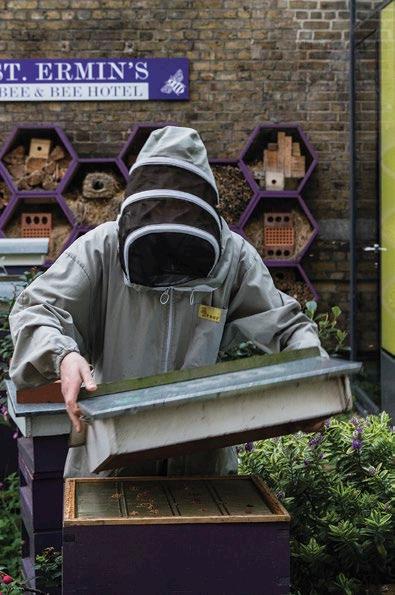
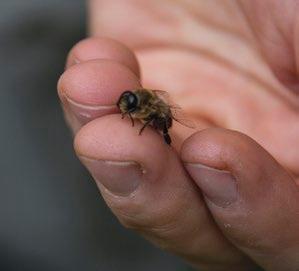
there have been notable exceptions: Walhampton Prep School, in Hampshire, keeps hives in the woods; Kimbolton School, a 950-pupil co-ed in Huntingdon, has positioned hives in the courtyard of the school’s science block; while at Yarm School, near Stockton-on-Tees, hives have been set up on a nearby farm away from the school—strictly for pupils trained in bee care.
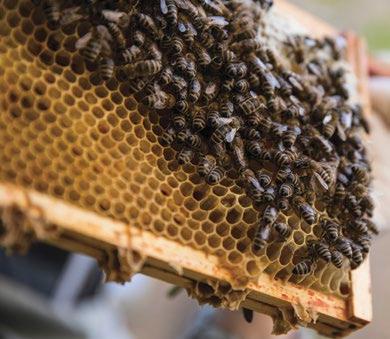
This is a grave issue, not least because our existence rather depends on their existence
Once the children have been around bees for a while, they learn not only to appreciate the insects’ work, but to be able to differentiate between a bee and a wasp: something many children can no longer do. What’s more, they get to understand the service that bees provide for us, rather than seeing them as the source of stings.
“If young people don’t come into bee farming, we won’t have British honey,” warns 26-year-old Rebeckah Marshall of British Honey Producers. It’s said that a single pot of honey requires 40,000 miles’ worth of flying, which is a lot to ask of any worker. Adds Rebeckah, “We’re already importing thousands of tons of honey because we can’t satisfy the demand from supermarkets.”
One of the vital roles that Rebeckah performs is supplying new queen bees

to hives across the country. To produce a queen, the larva has to be fed royal jelly—the magical elixir secreted by bees. It’s a demanding job, but is it worth it? There’s no doubt in Rebeckah’s mind. “Bees are so much more than honey”, she says, reiterating the severity of the situation. “You wouldn’t have a third of what’s on your plate if it weren’t for bees.”
It’s not just in the countryside that the honey revival is happening. You can now buy honey as produced on the tops of trendy East London warehouses. It’s good news from the bees’ point of view because the temperature is warmer in cities—so they can start work earlier in the year.
“Several hundred drones will mate with the queen bee,” says Camilla. “And while the queen lives for three to four years, the drones only live for several months.” Never does an individual
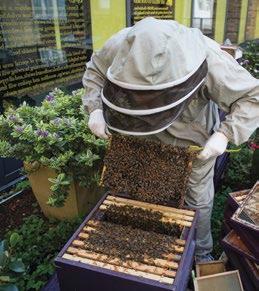
insect’s life get in the way of the col ony’s future.
Like wines, honeys come in many different flavours: eucalyptus, sage, clover, blueberry, avocado and more. Visit the London department store Fortnum & Mason and you can find more than two-dozen types of honey, costing from £6.95 to £21 a jar.
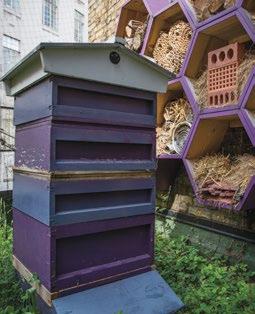
It’s certainly a luxury, but one that we’ve come to take for granted. As Camilla says, “It’s amazing what bees do.” If we want to continue to enjoy that teaspoon of honey in our tea— and much else besides—we need to help our bees carry on.
To find out about beekeeping courses and groups near you, visit bbka.org.uk. You can purchase a variety of biomes and hives at shop.readersdigest.co.uk

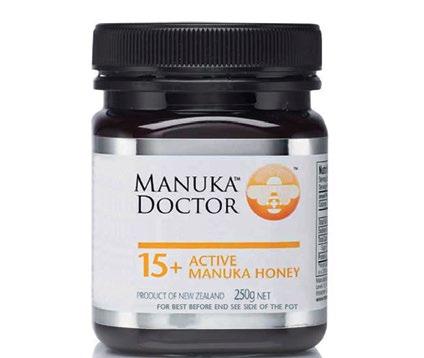



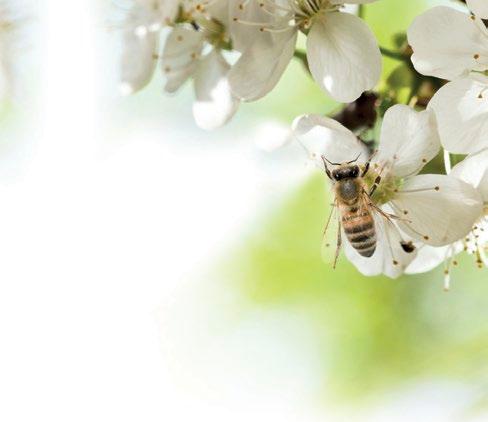
Send us your summer snaps— it could win you a fabulous camera!
Competition Summer Happiness Photo
THERE’S STILL PLENTY OF TIME TO ENTER OUR PHOTO COMPETITION.
Simply take a compelling picture that sums up summer happiness and send it to us. We’re looking for unusual approaches, so get your thinking caps on!

The competition will be judged by the Reader’s Digest editorial team with the help of photographer James Eckersley (above), and the winning entries will be published in our October issue.
James Eckersley, author of The Last Few, has work displayed in the permanent collections of The National Portrait Gallery and The Royal Collection. Here he shares his tips for taking a great photo and his own favourite summer snaps.
Summer is finally here! The days are long, the barbecue has been dusted off and it’s time to get out your cameras. Having chosen your subject or location, you need to concentrate on some of the key elements of a great photo, such as composition and lighting. Experiment by taking your photos from different angles or placing your main subject to the edge of the frame. Shoot at various times of the day or in different lighting conditions. None of these techniques require any expertise or expensive equipment— just some thought.
The images I’ve included above were shot on a simple camera phone, but they really sum up what summer happiness is for me—family days out at the seaside!


“Both of these photos of my children were taken in Bexhill-onSea, East Sussex”
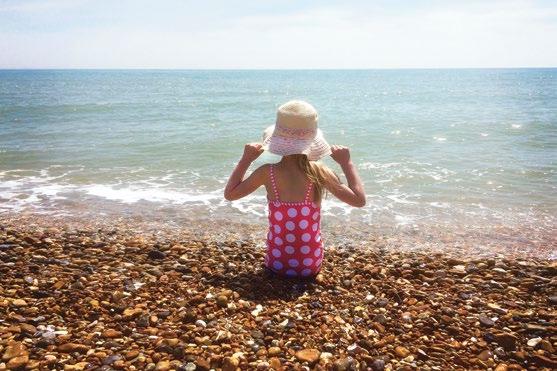
HOW TO ENTER
J Take a high-resolution photo with either a phone or digital camera. After saving it as a jpeg no larger than 2MB, go to readersdigest.co.uk/photo-comp and use the form to upload. Entries must be submitted by 5pm on August 25.
J There are two categories—one for adults and one for under-18s. The adults prize is a Nikon DSLR Camera worth £750; the under-18s prize is a Panasonic Lumix Bridge Camera worth £230.
J Please mark your entry either “Adult” or “Under 18”.
RULES: Please ensure that pictures are original, not previously published and taken specifically for this competition. If you’re under 16, you must ask your parent or guardian’s permission to enter this competition. We may use entries in all print and electronic media. Contributions become world copyright of Vivat Direct Ltd (t/a Reader’s Digest).
Entry is open only to residents of the UK, Channel Islands, Isle of Man and Republic of Ireland. It is not open to employees of Vivat Direct Ltd (t/a Reader’s Digest), its subsidiary companies and all other persons associated with this competition, their immediate families and relatives living in an employee’s household. The judges’ decision is final. n
For Your Injury? Could You Claim Compensation
IF YOU'VE
BEEN
INJURED
IN
AN
ACCIDENT that wasn’t your fault, make sure that you don’t miss out on thousands of pounds in compensation.
According to research, 18 per cent of adults in the UK have been injured in an accident in the last five years, yet only one in four have gone on to make a claim for personal injury compensation.
This means that every year millions of pounds are left unclaimed by accident victims who've been injured through no fault of their own.
CAN YOU AFFORD NOT TO CLAIM?
Injury compensation could be worth thousands of pounds to you. Injuries can range from soft-tissue damage to broken bones or permanent disability— and they can all impact your quality of life.
The law says you should not suffer personally or financially for someone else’s negligence.
GET EXPERT HELP AND ADVICE
Reader's Digest is pleased to introduce Accident Advice Helpline, the UK’s largest personal-injury specialist law firm, part of Slater and Gordon Group. A dedicated team of expert personal

injury solicitors will be able to provide you with the best possible advice.
Whether you've been injured in a road accident, at work or elsewhere, our solicitors are dedicated to getting you maximum compensation with minimum fuss. As a reader of Reader's Digest you can call 0800 740 8991 now for a quick and confidential FREE CLAIM ASSESSMENT.
Accident Advice Helpline is recommended by TV consumer champion Dame Esther Rantzen and has a five-star “Excellent” rating from Feefo, with 98% positive reviews.
HOW MUCH COULD I CLAIM?
Often people greatly underestimate how much their claim could be worth. Our website readersdigestaah.co.uk has a quick claim calculator to assist with valuations. How much you could claim

LEGAL
I was working in a busy kitchen and injured my head. It wasn’t my fault. Accident Advice Helpline were very professional, helpful and sympathetic. I felt secure that they were doing everything they possibly could for me. I received £6,500 for my injuries.
Ann, Leyton

depends on the circumstances.
Rebecca from Canvey Island received over £5,000 in compensation following a road accident, in which she suffered neck and back injuries. Call 0800 740 8991 to see if you could claim.


Take my advice: you can trust Accident Advice Helpline to look after you. Esther Rantzen
18% of adults have suffered some form of personal injury or accident in the last five years.
Don’t Miss Out

Only one in four of people who have suffered personal injury attempt to claim.
Your Legal Right
If you've been injured in an accident then it's your legal right to seek compensation.

FREE claim assessment—call Accident Advice Helpline now on 0800 740 8991 for a FREE confidential claim assessment. Our lines are open 24 hours a day, 365 days a year. Call 0800 740 8991 or visit readersdigestaah.co.uk
Award-winning comedian, actor, writer and presenter Ben Miller was studying for a PhD in quantum physics at Cambridge University when he decided to pursue a life in comedy instead
If I Ruled the World Ben Miller
I’d bring back proper sweet shops. The ones with very tall glass jars where you have to ask the shopkeeper to weigh out the sweets, which are then given to you in a paper bag. Youngsters today are missing out on one of childhood’s most important experiences—being in control of their own sugar intake.
I’d ban bottled water. The idea that it’s a luxury to drink water that’s been standing still in a fetid plastic bottle for ages is absurd. Tap water tastes much better. I’d have drinking fountains on every street corner and no waiter would look at you as though you were a cheapskate when you ask for tap water in a restaurant.
Corporations would communicate in formal language. I can’t stand them trying to get all matey with me. It all started with signs in trains saying things like, “Please do not place your paper towels,



hopes and dreams in the toilet.” I think, Ugh, am I being snuggled up to by a massive corporation? No, thank you. Stick with doing what you’re supposed to do in a nice boring way.
I’d bring back scary stories for children. I’ve had enough of books where a fluffy bunny teaches a child to say please. I was brought up on the stuff of nightmares, such as Der Struwwelpeter’s tailor chopping off children’s thumbs with huge scissors and Hansel and Gretel being imprisoned and tortured by a terrible witch. If we keep telling our children nothing bad is ever going to happen, what will they do when the penny finally drops?
I’d build nuclear fusion reactors. We need to look at different ways of addressing the energy crisis. I think the only hope on the horizon is nuclear fusion—not to be confused with nuclear fission. Nuclear fusion takes lovely small atoms, most commonly hydrogen, and fuses them together to form helium while creating large amounts of energy in the process. There’s an endless supply of hydrogen in the universe and the only waste product is water, so it’s an entirely clean source of energy.
I’d add to our citizenship test. With the passing of great names like Ronnie Corbett and Victoria Wood, I’m all too keenly aware that there are
whole generations who lack an understanding of the great British sense of humour. So my three crucial requirements for the Life In The UK test are: 1) have a pretty good stab at reciting Monty Python’s Dead Parrot sketch; 2) know a few of Ronnie Corbett’s answers from the Four Candles sketch; 3) hold a glass of wine and re-enact Del Boy as he falls through the bar in Only Fools and Horses. I reckon that would sort out our immigration problems in one fell swoop.
You’d never meet your heroes. In your head your heroes are your best friend; they’ve been the confidant of your innermost desires and wishes for yourself. But of course, horrendous as it is to acknowledge, they have no interest in you whatsoever. I was once at a party when I saw Paul McCartney was about to enter the room. I rushed out and locked myself in the loo; he’d never understand quite how much I love him and I just couldn’t risk him ignoring me.
All the things I continually lose would come microchipped. Then I might be able to find them. So my glasses, my keys, my phone, my wallet, my car, my kids, my wife... As told to Caroline Hutton
Ben Miller’s latest book The Aliens Are Coming, published by Little Brown, is out now in paperback.


Best of British
Vineyards
The UK is quietly becoming one of the world’s top wine producers—and these vineyards are leading the way
BY FIONA HICKSThis estate in Devon was farmland for a millennium before the first vines were planted

Sharpham DEVON
Did you know there were 139 vineyards in England and Wales when Henry VIII ascended the throne? For reasons no one quite knows, production dipped off as the centuries rolled on.
Happily, it’s again on an upward trajectory, and Sharpham is one of
the estates at the fore. Having been farmland for more than 1,000 years, the 500 acres were turned into a vineyard almost 25 years ago.
“We’re a family-run winery,” says assistant vineyard manager Charlie Brown. “We create numerous styles of wine, all of which are expressive of the unique terroir Devon has to offer.”
The “Sharpham Experience” tour
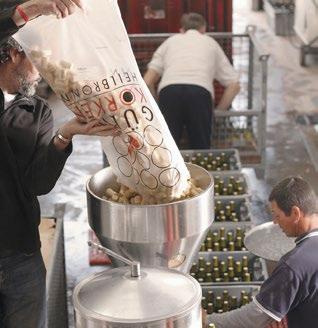

is a fantastic way to get a flavour of the estate. During a delightful four hours, visitors wander round the 18th-century house, amble down to the river Dart and enjoy a delectable lunch—including, of course, their superb wine and cheese. Don’t forget to buy a bottle from the cellar door shop before you leave.
■ Visit sharpham.com for details
Ryedale Vineyards YORKSHIRE
Situated near the village of Westow, these are the most northerly commercial vineyards in Britain. Split over two sites, there are over 10,000 vines covering ten acres in total, alongside an acre of orchards that produces fresh fruit, juice and, of course, cider.
A vineyard tour is held here approximately once a month, and they’re extremely popular with locals (as well as tourists passing through). Visitors are rather charmingly advised to “bring wellies and appropriate clothing” so they can traverse the northern countryside unsullied. In fair weather, the wine tasting takes place in the garden, but if it’s raining, everyone piles into the farmhouse kitchen. After a few hours in the fresh air, Ryedale’s Shepherd’s Delight rosé slips down very easily.
■ Visit ryedalevineyards.co.uk for details

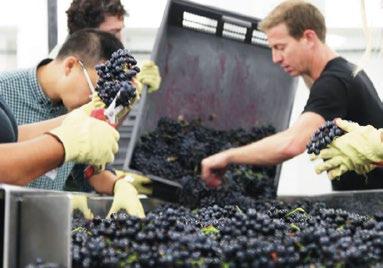
London Cru LONDON
Now this technically isn’t a vineyard, but we feel it deserves a mention because it’s London’s first (and currently only) winery. Central to the operation is winemaker Gavin Monery, who sources the best grapes from around Europe. He ensures they’re hand-harvested, refrigerated and transported to the London Cru site in Earl’s Court—all within 36 hours.
“The key thing with this project has always been quality,” says Gavin. “The growers we work with are among the best in their regions.”
They’re on a mission to ignite a passion for vinification in the public too, with regular tours of the historical headquarters (which are actually a former 19th-century gin distillery). You can even try your hand at the “Winemaker for a Day” special events, but be warned—tickets sell out quickly.
■ Visit londoncru.co.uk for details
Winbirri NORWICH
Established less than a decade ago, Winbirri’s awards are fast piling up. The winemakers picked up two silver and three bronze medals in the English and Welsh Wine of the Year Awards in 2014, and countless trophies and gold medals in the East Anglian Wine of the Year Awards in the same year.
When visiting for one of their “Tours and Tastings”, it’s easy to understand why they’ve been such a success. Head winemaker Lee Dyer is brimming with enthusiasm

Visitors can walk among the Winbirri vines before sampling five of their award-winning wines
and knowledge, and deliberately doesn’t give a set timeframe for the tour so guests can ask as many questions as they please. After walking through the vineyards and learning all about the hi-tech equipment in the winery, the experience is completed with a sumptuous selection of wine tasters —all topped off with local platter cheeses and cured meats.
■ Visit winbirri.com for details
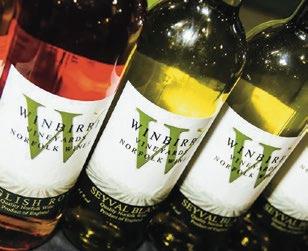

Camel Valley CORNWALL
Back in the 1980s, Bob Lindo and his wife Annie bought a farm in the heart of the Cornish countryside. Bob was a former RAF pilot and he and his wife were seeking a change from service life and a place to raise their young family. They initially farmed sheep and cattle but, after watching the sun brown the grass on the slopes of Camel Valley summer after summer, an idea was sparked.
They planted their first vines in 1989, and it was a steep learning curve. “We practically lived in the vineyard, doing all the work by hand,” says Annie. “When it came to harvest time it was just us and a few friends for picking, then Bob would stay up all night crushing the grapes.”
Twenty-seven years later, Camel Valley has won a plethora of awards and is stocked in some of the finest restaurants in London. Their Pinot Noir Rose Brut is a must-try.
■ Visit camelvalley.com for details



Three Choirs
GLOUCESTERSHIRE
This is one of the oldest vineyards in Britain, having presented its first vintage exactly 40 years ago. There are two locations (the other is in Wickham, Hampshire), but the Newent site in Gloucestershire is a particular favourite because you can stay overnight. Rooms are located near the restaurant and shop, and
Three Choirs’ Gloucestershire site offers beautiful, southfacing rooms for guests
each comes with a south-facing patio offering spectacular views.
“We get all sorts of people,” says managing director Tom Shaw. “Those who are very interested in wine, and those who just know a little. We don’t mind! We try to make it a friendly place that anyone can come to, and even if they don’t like wine, they can still enjoy the beauty and the peace.”
For those who do like vino, no visit would be complete without a winetasting tour, which conveniently takes place every day. For real oenophiles, there’s even an option to adopt a vine.
■ Visit three-choirs-vineyards.co.uk for details
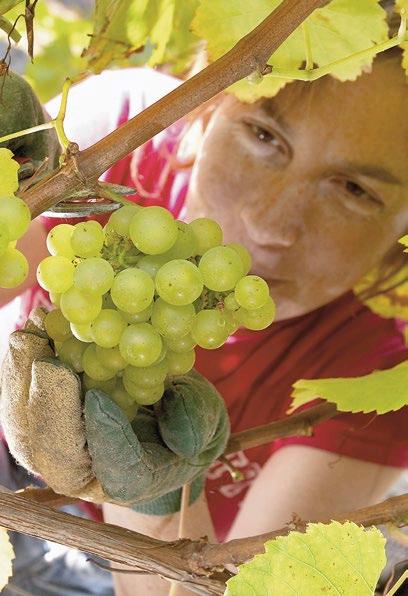
Nyetimber SUSSEX
This estate was mentioned in the Domesday Book in 1086, but it wasn’t until 900 years later when the first vines were planted on this especially fertile corner of Sussex. Says head winemaker Cherie Spriggs, “With views overlooking the South Downs, there’s an atmosphere and feeling here that makes you just know that this is the right place to grow grapes.”
and well worth the £25 ticket— not least because everything is so meticulously maintained.
Nyetimber has a reputation for being a patriotic company (each of their bottles is proudly emblazoned with “Product of England”) and also a perfectionist’s attention to detail. So much so, in fact, that in 2012, Cherie decided not to bottle an entire vintage because the grapes weren’t up to Nyetimber’s scrupulous standards.

Unsurprisingly, Nyetimber’s name is synonymous with world-leading fine wines. Their Classic Cuvée gives Champagne a run for its money.
■ Visit nyetimber.com for details
The vineyards aren’t open to the public all the time, but they hold open days that are hugely popular
Are you partial to a British tipple? Email readersletters@readersdigest.co.uk and let us know your favourite!
Sweden’s Most Perfect Season
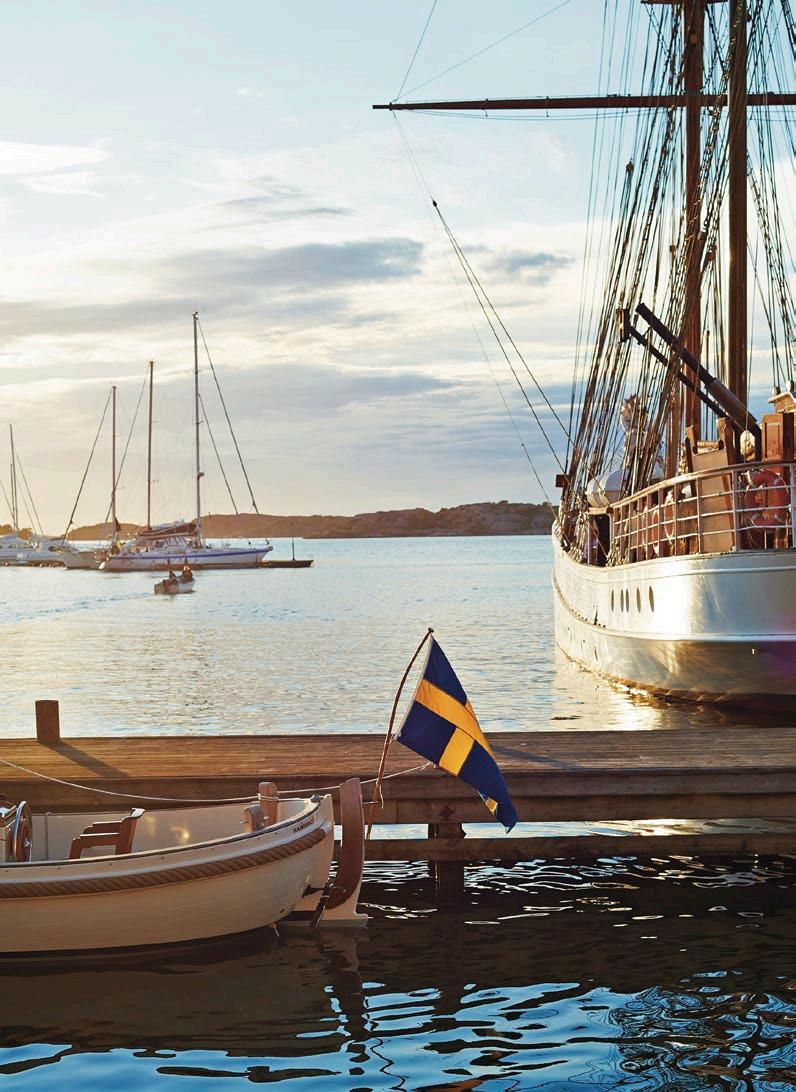
It blazes through like a comet. So in the happy mania of summer, Swedes soak up as much sunshine and seawater as time allows
BY PETER JON LINDBER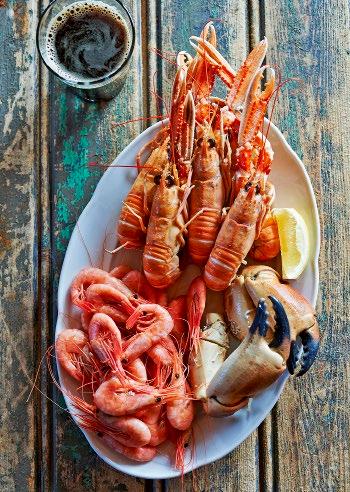
SWEDEN’S MOST PERFECT SEASON
IT’S ONE OF THOSE SHIMMERING SWEDISH AFTERNOONS
when everything seems to glow from within: the boathouses, pulsing vermilion red; the glittering, wind-rippled bay; the chalk-white houses of coastal Fjällbacka, luminous under the Nordic sky.
Laughter and ships’ bells echo off the marina. One could walk a halfmile to sea just by hopping across schooners and yachts. (In western Sweden there’s a boat for every man, woman, child and dog.) On the deck at Restaurang Matilda, a rowdy crew is singing Swedish folk tunes, knocking back aquavit and ripping into platters of crayfish.
In Sweden, summer blazes through like a comet, hot and bright, then disappears for ages. Even at midsommar’s crest, every gain—in temperature, in daylight, in crayfish—must be reckoned against impending loss. “Swedes worship summer like a religion,” says acclaimed Stockholm chef Niklas Ekstedt. That started in pre-Christian times, with Midsummer’s Day. But neither the church nor commercialisation has killed that tradition.
And so, around the third week of June, Swedes begin their great migration to vast inland lakes, fast-flowing rivers and, especially, the coasts—to soak up as much sunshine and seawater as time allows.
As the grandson of Swedish immigrants, I’m well acquainted with the quasi-pagan rites of summer. Growing up, I’d embraced similar rituals in Maine, where days were measured in saltwater ablutions and lobster-shack lunches. But it was the cajoling of my pal Marcus Samuelsson, the SwedishAmerican chef—who spends time each summer in his ancestral home
of Smögen—that inspired me to make my own return to the source.
With Marcus as my occasional cohort, last year I traced Sweden’s Bohuslän Coast in that happy mania. I’d rise at 5am for kayaking, spend every golden hour outdoors and linger until the last of the sun’s rosy aura vanished from the midnight sky.
In contrast to Sweden’s leeward, verdant east coast, this western county is raw and wind-lashed, more granite than green. Its seaside resorts just a few hours’ drive from Oslo, to the north, and Göteborg, to the south, the region routinely draws streams of summer revellers.
Bohuslän’s resort towns may appear interchangeable, but there are some variations—primarily, the favoured local catch. There’s Lysekil in the south, with its distinctly nutty mussels. Grebbestad in the north, with its celebrated oysters. And Smögen midway, with its sweet, rose-coloured prawns.
Fjällbacka, the prettiest of these communities, is known for two former residents. Ingrid Bergman kept a

house on the island Dannholmen off Fjällbacka from 1958 until her death in 1982. There’s a bronze bust of the actress in the town square.
Whole walking tours are devoted to Camilla Läckberg, the wildly popular crime novelist. Her eight books are set, improbably, in this sleepy town of 900 (the summer population swells to 15,000). I’ve read a few of Läckberg’s mysteries, and her imaginative gifts seemed all the more impressive when I saw Fjällbacka in the cheerful light of day. Really? This place, a sinister town-of-secrets? It recalled a miniature village from a model railway.
As I set out on my first morning, a line had formed outside Setterlinds Bageri, a favourite of Bergman’s, who made pilgrimages for Mandelberg cake

and kardemummabullar (savourysweet cardamom rolls).
On the pier, children gobbled bags of gummy sweets. Handsome women and tanned men were hiking Vetteberget, the granite butte that juts 250 feet up from the town centre. On a gentler hillside above the harbour, cobblestoned paths wound past cottages with red-tiled roofs and the gingerbread trim known as snickarglädje or “carpenter’s delight”. Geraniums filled every window box, and the Swedish blue-and-yellow flapped on rooftops.
THIS ODD MIX of harshness and grace—of wind-scarred rock and rose bushes—is what gives Bohuslän its stirring beauty. But its greatest assets are hiding underwater. From these
A view of Fjällbacka from the water; (left) swimming off the docks in Smögenclean bays comes northern Europe’s finest seafood, not least the coveted saltwater crayfish, which are actually plump, delectable langoustines. Here, the sea is everything.
If you’ve come, like me, to devour as much seafood as possible, you’ll chart a course for Grebbestad, where half of Sweden’s lobster, 70 per cent of its crayfish and 90 per cent of its oysters
This was easier than I’d expected. From the boathouse pier, Per dipped his eight-foot oysterman’s rake, rummaged in the seabed and pulled up half a dozen shallow-cupped European flats. Soon we had three dozen. We took our pail onto the brothers’ small fishing boat and, with Lars at the helm, chugged into the bay.
THIS ODD MIX OF HARSHNESS AND GRACE IS WHAT GIVES BOHUSLÄN ITS STIRRING BEAUTY
are harvested. I’d driven up from Fjällbacka to spend the day and night in Grönemad, a fishing village that feels like a Viking encampment on the edge of the world. If Fjällbacka is sleepy, Grönemad is comatose.
Brothers Per and Lars Karlsson run oyster and lobster “safaris” out of their 130-year-old boathouse, Everts Sjöbod. Inside it’s still 1884: candle wax overflows from old brown beer bottles; lanterns rest on wooden barrels; knotty rafters are tangled with ropes and fishing nets. Last May the brothers added six guest rooms with kitchenettes and pine interiors. Per showed me to one of the smaller suites upstairs, where a terrace overlooks the bay. Then we went out to harvest oysters.
After we moored off an islet where seals were basking, Per handed me a knife and we set to work shucking. Even in summer the oysters were fullbodied. Still cool from the sea, they didn’t even need ice. They also paired well with Per’s home-brewed porter. “We used to serve champagne,” he said, “but it didn’t feel very Swedish.”
After another 20 slurps, I was high on porter and oyster liquor. It was early evening, but the sun still hung high. “Back to the sjöbod?” asked Lars, knocking back one last half-shell.
LATER, THE SUNSET painted everything crayfish-pink. It was 9.55pm and I sat on my terrace reading Läckberg’s The Stonecutter. A Fjällbacka girl had turned up drowned (murdered?), her corpse entangled in a lobster trap.
Then I heard a scream and a splash. On the public pier, kids were somersaulting into the glassy bay. A Swedish family was savouring the last of the light. This looked too fun to miss. I put on my swimsuit and leaped off my boathouse dock. The water was surprisingly warm. When the light finally left, the family followed suit, and on
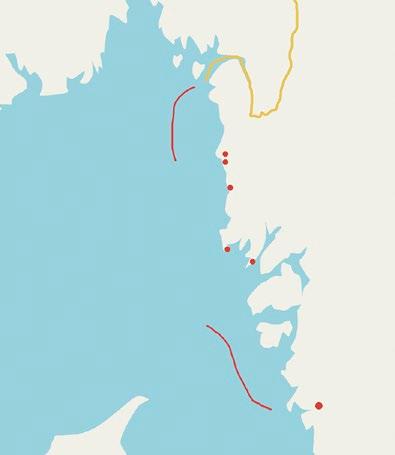
the water all was silent. I swam back and tiptoed upstairs to bed.
The next morning I was off to Smögen, where Marcus waited. The chef is a proud son of Göteborg, but many of his childhood memories took place 50 miles north, in Smögen. The Samuelsson clan would gather every summer in a three-storey Victorian house owned by Marcus’s grandmother. Young Marcus learned to fish and, not least, cook his catch under the watchful eyes of his father.
Smögen—year-round population 1,400—is one of Europe’s great fishing towns. Its famous fish auction, founded in 1919, still operates twice daily but is nowadays seldom open to the public. Smögen is also the headquarters of seafood conglomerate Abba, maker of Sweden’s beloved Kalles Kaviar (fishroe spread), whose retro packaging is familiar to IKEA shoppers.
Alongside its harbour is Sweden’s longest boardwalk—lined with restaurants, souvenir shops and fish markets. It’s one of Sweden’s top attractions. Marcus and I strolled it on our first afternoon. Inside, the restaurants were empty, but the dockside patios were jammed. “In July,” said Marcus, “there are people all along the boardwalk— some jumping in, some falling in.”
We were with Marcus’s cousin Karin Samuelsson, who runs a local rental agency. She and Marcus know half the people here, and as we walked everyone called out hellos. For a visitor used to Nordic reserve, it was funny to see Swedes so voluble. “For nine months we hardly even see the neighbour’s cat,” said Karin. “Then, for that short spurt, we’re relentlessly social.”
I spent three days in Smögen with Marcus and his family, and consumed half my body weight in crayfish. On the final day Marcus and I booked a crayfishing trip with Martin Olofsson, a ninth-generation fisherman. Martin speaks with a sing-song inflection that, per Marcus, “is sort of the Swedish equivalent of a Maine lobsterman’s accent. As a kid I couldn’t understand a word. Now I get about half of it.”
Wearing overalls and thick rubber boots, we head a few miles out to sea. Crayfish traps resemble lobster traps, and retrieving them from the seabed was fairly simple: Martin aimed for his orange buoys, and with hooked poles Marcus and I would grab the lines, then use a crank to hoist the traps.
Most held at least a couple of crayfish, plus the odd crab or jellyfish. Working fast, we’d empty the traps—the crabs’ claws snapping at our fingers—rebait them with chunks of salted herring and stack them on the deck for later.
After an hour we’d netted 63 langoustines. Good timing, said Martin: that morning, prices had hit a season high of £12 a pound.
Earlier on the sunny pier, I’d thought our rain gear excessive. Now, as the sky grew heavy, I saw what generations of Olofssons could teach a Lindberg
about weather in western Sweden.
We were within sight of Smögen’s Hållö lighthouse, yet being tossed on huge swells as if in the heart of the Atlantic. Sliding across the rain-slicked deck, careening into each other, Marcus and I managed to toss back all the traps. Martin, meanwhile, stood firm and smiling at the wheel.
“Jag älskar sommaren!” he shouted to us, flashing a grin as a monster wave crashed over the hull.
“I love summer too!” shouted back Marcus, and we fell into laughter.
SWISH SWEDEN
STAY
Everts Sjöbod Grebbestad, rustic, six-unit guesthouse in Grönemad. Shellfish “safaris”, seafood feasts, from €75 (evertssjobod.se).
Stora Hotellet Bryggan, hotel near Fjallbacka’s main pier, doubles from €250 (storahotelletbryggan.se).
Hotell Smögens Hafvsbad, modern rooms in central Smögen, doubles from €182 (smogenshafvsbad.se).
Smögens Rum o Stuga. Holidayrental agency run by Karin Samuelsson, offering rooms and cottages around the Smögen area (info@rumostuga.se).
Strandflickornas Havshotell, “oldetyme” Swedish character in the fourstorey main house in Lysekil, doubles from €195 (strandflickorna.se).
Gullmarsstrand Hotel, across the fjord from Lyeskil, this occupies a breezy peninsula outside Fiskebacksil, doubles from €183 (gullmarsstrand.se).
EAT
Setterlinds Bageri, Falkevägen 2A, Fjällbacka, best bakery in town.
Restaurang Matilda & Cafe Bryggan, Ingrid Bergman’s Torg, Fjällbacka. Popular dockside restaurant-barcafeteria (storahotelletbryggan.se).
Göstas Fisk, Fiskhamnsgatan 32, Smögen. This simple seafood spot is a favourite of Marcus Samuelsson (gostasfisk.se).
Lyckans Stenugnsbageri, fabulous roadside cafe and organic bakery, between Smögen and Lysekil on road 171 (stenugnsbageri.se).








































































































The most northerly state in the US boasts some dramatic landscapes
BY CATHY ADAMSMy Great Escape: Boating In Alaska
Frances Harris from Essex breezes through the freezing yet magical US state

Cathy has danced in Rio, been microlighting in South Africa and hiked the mountains of Oman


WE WERE SAILING through a world of enchantment: a world of snow and ice, of soaring mountains, narrow fjords and glaciers that tumble to the sea, alongside incredible wildlife. We were in Prince William Sound, Alaska.
We’d boarded at Whittier, a town on the southern Alaskan coast. Aboard a large catamaran, heading to a nearby sealion colony, we marvelled at the mountains and glaciers reflected in the clear-blue waters. Normally the sea would be grey and the mountains covered in cloud, but today the sun was shining.
We crowded to the bow to watch Dall’s porpoises in front of the vessel, then watched in awe as a humpback whale breached over and over again. We saw sea otters, which swim on their backs when they are preening, almost doing a leisurely backstroke.
We saw 26 glaciers that afternoon. Sometimes they start high on the slopes and literally hang from the mountainsides. At other times they move towards the ocean’s edge and calve into the sea, shedding slabs of white and blue ice that crash into the water. We went right up close on several
occasions—so close we could hear the glaciers moving.
Our last stop was by the large kittiwake colony across the bay from Whittier, where the mountainside was white with birds. We went ashore with reluctance—we didn’t want to leave the world we had discovered at the other end of the tunnel, the spellbinding marine wilderness of Prince William Sound.
■ WILDLIFE & ICE
Return flights to Anchorage, Alaska, start from around £580pp (0344 209 7777, virgin-atlantic.com).
A humpback whale breaching the surface
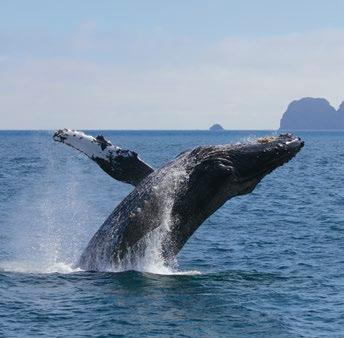
WE WANT TO HEAR FROM YOU!
Postcard from ... Greenland
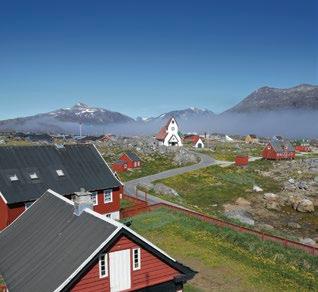
FOR SOME, August is a month to fly south and soak up the effortless heat of the Mediterranean. For others, it’s a good excuse to migrate north—and there’s nowhere more exceptional during the light summer months than Greenland, within the clutches of the Arctic Circle. This is the season when migratory birds arrive and the Arctic flora blooms—making it a beautiful time to visit the remote country. Expect midnight sun cruises, dramatic icebergs and husky sledding, even in the height of summer.
■ SUMMER SLEDDING
Discover the World offers a five-night “Essential West Greenland” package from £1,808pp in August (01737 214 291, discover-the-world.co.uk).
Tell us about your favourite holiday (send a photo too) and if we include it on this page we’ll pay you £50. Go to readersdigest.co.uk/contact-us
Things To Do This Month

RIO DE JANEIRO IN TWO MINUTES
■ EXPLORE: SANTA TERESA You’ll know Rio de Janeiro for its beaches— less so for its bohemian side. Santa Teresa, set into the hillside above the city, is all cobbled streets and handicraft shops (visitbrasil.com).
■ STAY: BELMOND COPACABANA
PALACE Escape Olympic fever in this graceful, iconic property right on Copacabana Beach. Inside are chandeliers, marbled halls and a rarefied atmosphere—as well as a stunning pool from which to watch local life go by (belmond.com).
■ SEE: CHRIST THE REDEEMER
There’s a reason so many tourists go to the top of Corcovado Mountain— to see the Christ the Redeemer statue up close. You can hike up a fairly steep hill or you could take the narrow tram, which takes around 20 minutes to reach the top.
LONG/SHORT: BEACH HOLIDAYS
LONG: Corfu
With a new Ryanair base on the island, meaning extra flights each week from the UK, Corfu is the Greek island to be on this summer. Its mountainous interior and white sand-flecked coastline has long been popular with visitors—it’s easy to see why (01733 224 808, thomascook.com).

SHORT: Cornwall
Just north of Newquay is Watergate Bay, a two-mile-long stretch of golden sand home to myriad watersports and foodie experiences. Enjoy the view from the Watergate Bay Hotel (01637 860 543, watergatebay.co.uk).

TRAVEL APP OF THE MONTH
Hitlist, Free, iOs. Tired of trawling flight-comparison websites? Plug your desired destinations into Hitlist and it’ll let you know the best options. It has great scenic shots too.

Innovative new mobile phone network puts an end to signal black spots
MOST PEOPLE IN THE UK now own or use a mobile phone.
Yet, while our reliance on mobile communication is growing all the time, we still suffer frustrating black spots all over the country when our mobiles drop out of signal range because no single provider covers 100 per cent of the country.
This is not only inconvenient, it could be the difference between life and death in some instances, and it certainly could mean being unable to call for assistance, or for you to be reached in an emergency.

When you travel abroad, you can allow your mobile to “roam”, meaning it picks up the strongest signal from any one of a number of operators. But this roaming has never been available in the UK—until now.
Stay in touch wherever you are Innovative network carrier Anywhere SIM has created a roaming solution for the UK that virtually eliminates black spots by picking up signal from O2, EE and Vodafone, meaning wherever you are in the UK you will virtually always been in touch.
Moving to an Anywhere SIM is easy, with great value pay-as-you-go tariffs, and you can even transfer across your existing number. This phone is perfect for those who travel frequently because our rates stay the same there as they are in the UK. It’s also great for those who live in rural areas where signal is weakest.

David Plummer is a top wildlife photographer, spending months of the year in some of the world’s most exotic locations. Diagnosed with Parkinson’s seven years ago, he’s now using his images to raise awareness of the condition
A LeopardDoesn’t Change Its Spots
BY AMANDA RILEY-JONES

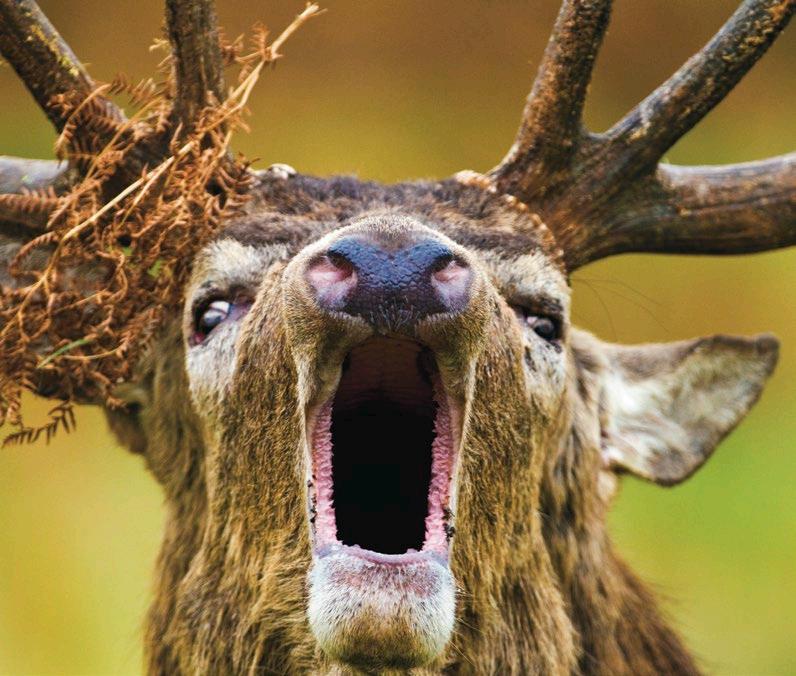

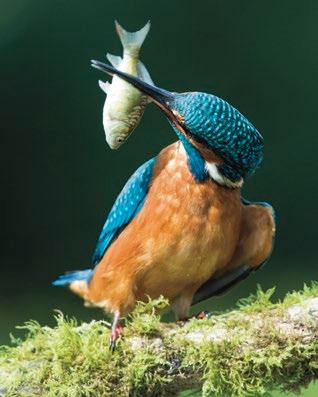
“N
ATURE HAS ALWAYS BEEN MY OBSESSION,” says
David Plummer. “My earliest memory is, aged two, bringing peabugs in from the garden and rolling them into balls across Mum’s coffee table!” At seven, his father built him a bird table and, from the moment a female sparrow came down, the youngster was hooked.
The next year, David (right) bought a secondhand SLR camera and managed to get a fullframe shot of a blue tit in its nest. By 14, he was bunking off school to cycle down to the northKent marshes near his home in the Medway Towns to photograph wading birds on the mudflats.
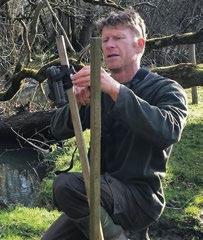
He left school with 10 O Levels, not knowing what to do—and ended up joining the Metropolitan police force. But wildlife and photography remained his passions. “At the top of a tower block, looking out for criminals, I’d be watching the kestrels,” he laughs. When he transferred to Grand Cayman, he spent every lunch hour scuba diving among the tropical fish, turtles and stingrays.
At 26, David took the leap to work towards becoming a professional wildlife photographer. “I moved to Sussex and did various odd jobs— which included cleaning and care work—in order to survive while I built my contacts and work experience,” he
says. “Being a volunteer photographer for the Sussex Wildlife Trust was a turning point.”
THESE DAYS, David is a respected wildlife photographer, teacher and conservationist. The 47-year-old leads photography holidays to exotic locations such as Kenya, Brazil and the Galápagos, as well as wildlife-watching and photography events in the UK.
Previous page (clockwise from top): Richmond Park, London. “This wild herd has become habituated to people, which allows for closer photography. This stag ran out from the bracken roaring, so I just took the shot.”
Knepp Wildland, Sussex. “Kingfishers are one of my favourite birds. I’ve got used to setting up for them, with a bucket of water, baiting fish and a good perch.”
Masai Mara National Reserve, Kenya. “I was watching a pride of about 20 lions, including about ten cubs. These ones were four or five months old.”
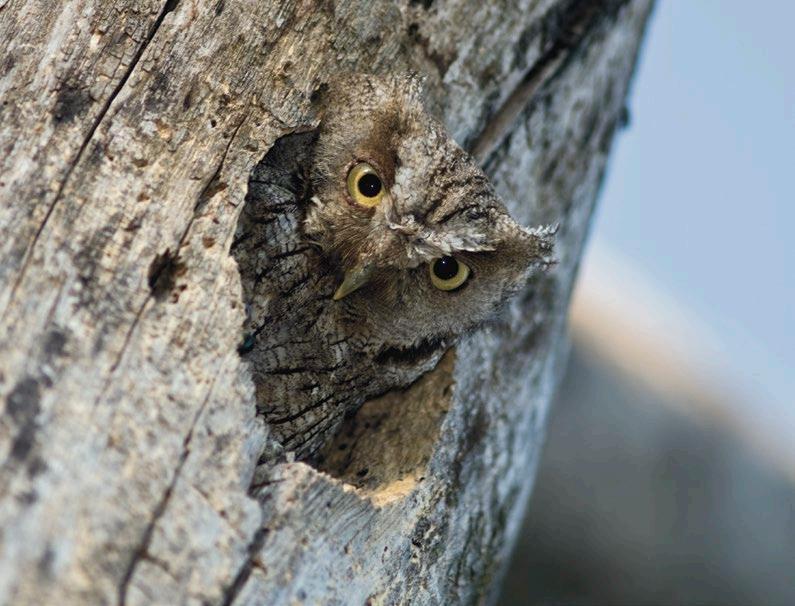
Pantanal, Brazil.
“I always investigate tree cavities as they’re usually home for something. The owl just popped his head out, so I pointed my camera up the trunk and grabbed the shot.”

Masai Mara National Reserve, Kenya. “Lions had killed a bull eland and it was a pretty bloody scene. By focusing in on small details, I got this shot of a cute cub framed by a bloody carcass.”

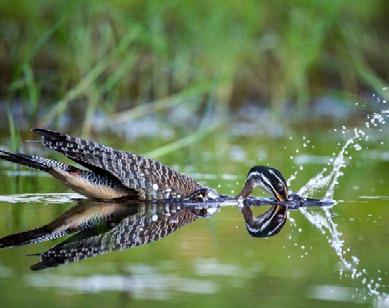


Clockwise from top left:
Abbots Wood, Sussex. “Apart from using a macro lens, it’s field skills that are needed to get you close to your subject. I learned mine photographing flowers and butterflies closer to home, including this pearl-bordered fritillary.”
Pantanal, Brazil. “This was a surprisingly easy shot to take and totally unplanned. I was teaching a group who were scattered about me and we were in front of a small pool. I just lay down and the bitterne wasn’t bothered by me at all.”
Masai Mara National Reserve, Kenya. “A zebra got stuck in a river crossing and three lionesses killed it in deep mud. This lioness dragged the carcass into some bushes and I waited over an hour to get this shot of her looking directly at me. They don’t view you as prey when you’re in a vehicle, but it can be quite chilling when they look straight into your face.”
Masai Mara National Reserve, Kenya. This adult leopard is called Fig locally. I’ve photographed her on and off for seven years or so—she’s not interested in our presence! Mother and cub came down the tree and started chasing each other, practising killing. All big-cat play is about killing.”
Seven years ago, he started to have tremors in his left arm. Aged 40, he was diagnosed with Parkinson’s Disease—an incurable, neurological condition with symptoms such as tremor, rigidity and slowness of movement. “There were some dark months, but all my life I’ve chosen to be positive. I know I’ll lose function,
but Parkinson’s has galvanised me to be alive. I’ve decided to grab life by the horns!”
When he’s taking images, his only concession to his condition is to use faster shutter speeds to counteract camera shake. If he’s leading a trip on the other side of the world, he flies ahead of the group so he can have a night’s rest in a hotel before the tour starts. At home, voice-dictation software on his computer and a newly hired PA (a retired man who’s equally passionate about wildlife) are helping him stay on top of the admin involved in running a business.
“I don’t think about the disability while I’m working, I don’t care if I’m stiff and aching. I’ll do whatever it takes to get the shot,” says David, who happily spends hours in a floating hide covered in leeches.
Next year sees the publication of his coffee-table book Seven Years of Camera Shake, which is filled with stunning images taken since his diagnosis. “I want to tell other people facing health challenges not to limit their ambitions,” he enthuses. “This book is not about what Parkinson’s has done to me. It’s about what it has not done to me. I’m seven years down the line and I’m still going strong.”
Seven Years of Camera Shake will be available to buy next year, with 50 per cent of proceeds going to Parkinson’s UK (parkinsons.org.uk). For details of David’s book, courses and tours, visit davidplummerimages.co.uk
A Will Is Not Enough!
PREPARING FOR THE FUTURE INVOLVES FAR MORE THAN JUST WRITING A WILL...
The right advice could help you protect what you’ve worked hard for, allowing you to pass as much of your hard-earned wealth as possible to your loved ones in the fullness of time. There are a number of threats to your wealth in later life, and only with good planning at the right time can you protect your home and savings.
LONG-TERM CARE FEES
According to the most recent research, more than 45,000 homes are sold each year to fund care, with one in ten people (or one in five couples) shouldering care costs of at least £100,000.
The rules changed last year with the introduction of The Care Act 2014,
but the new rules are complex and research shows very few will benefit. Planning and protecting what you’ve worked hard for has never been more important, but requires specialist advice not readily available from high street law firms—choosing the right adviser is essential.
I’ve worked hard all my life to leave something for my children, why should the Local Authority get it all?

LEGAL
MENTAL INCAPACITY
Impairment of the mind shouldn’t just be associated with illnesses such as Alzheimer’s, as a bang on the head or stroke—for which there is often no warning—can leave an individual unable to manage their own finances. Many people wrongly assume a spouse or children can automatically step in, but the truth is that without an Enduring or Lasting Power of Attorney in place, both solely and jointly owned accounts can be frozen. A long, complex, intrusive and expensive court process then awaits your loved ones to gain control of your affairs.
WHAT NEXT?
Planning for the future requires far more than just writing a simple Will. If you fail to plan effectively, there could be little left to pass on to your loved ones. Taking advice from a specialist is vital, and you can take the first step by requesting your FREE information pack by calling Reader’s Digest Legal on 0800 031 9516* and quoting reference RDL 14.
Busting The Bank Of Mum And Dad
Many parents continue to support their children well into adulthood—but their generosity is costing them
BY ANDY WEBB
Andy Webb is a money expert at the Money Advice Service. Visit money adviceservice. org.uk for details

THE DAYS WHEN YOUR CHILDREN left the family nest at 18 are long gone. Now it’s not uncommon for “kidults” in their 30s to still be living at home with their parents—and that’s putting pressure on the Bank of Mum and Dad.
The increase in stay-at-home adult children has come at a time when rents take up much of the take-home pay, making it increasingly difficult to save for a deposit for a home (which are more expensive than ever before).
But supporting grown-up children isn’t just through free or reduced rent and board. Even so-called financially independent offspring who do live on their own are making claims on their parents.
Recent research from Experian found the average outlay on adult kids is £6,000, and a large part of that is down to poor management of their finances by the children. Two in five parents (41 per cent) had to bail out their children who couldn’t cover unexpected costs, a quarter (24 per cent) of kids had run out of money due to bad money management, one in five (22 per cent) asked for money to help with a deposit for a home, while one in seven (15 per cent) needed help paying off debts.
Sound familiar? It’s natural that parents want to help their children—but if you’re still paying for your kids even though they’re earning their own income, there’s every chance it’s causing your own financial problems.

Putting pressure on the parents’ finances
Experian also uncovered that a third of parents had their finances put under strain by these requests, with close to three quarters (72 per cent) using their own savings to find the money. Worryingly, one in eight (13 per cent) resorted to credit to provide the cash.
The danger of raiding savings is that money is no longer available if parents face their own unexpected costs. From emergency repairs to being unable to work, a depleted back-up could put the whole family at risk. Likewise, borrowing money, especially if it’s to pay off children’s debts, can cause long-term damage if there’s no repayment plan in place.
Where to go for help with debt
Papering over a child’s poor money management with Bank-of-Mumand-Dad cash might be a quick fix, but it doesn’t necessarily mean the problem is solved.
The best option is to seek help to prevent the problems happening again. You can find free and impartial advice near you through the Money Advice Service website.
How to get kids back on track
A simple budget can make a huge amount of difference in knowing what money they have, and how much they spend. Start early by giving teenagers a budget to buy their lunch with, encouraging them to save and setting a good example.
Keep Track Of Your Spending

1 Start a simple budget
Use an online budget planner—or just make some notes in a pad—to work out what the regular bills add up to. You’ll then know what you have to spend each month.
2 Set up direct debits and standing orders to go on the same day
If you can arrange your bills to be paid a day or two after you get your salary, it should be easier to keep track of the money that’s left, and not accidentally be unable to cover your credit card or electricity bill.
3 Use online and mobile banking
Though not exactly real-time, you can use apps on your smartphone (or online banking at home) to keep
an eye on payments in and out, and that all-important bank balance.
4 Keep your receipts
If you’re out for an evening or regularly using cards to pay, it’s easy to not know quite what you’ve spent. Get into the habit of asking for a receipt—you can go through them all at the end of the day.
5 Take cash only
For anyone worried about going overdrawn, taking only the cash you can afford out with you is the ultimate trick to stop you spending more than you intend. Since you’ll be able to see how much you have left, you’ll be able to track your spend. Just make sure you leave your card at home too.
Dialling Down Cold Calling
Fed up with unsolicited calls to your mobile phone? There’s now an easy way to reduce how many you receive. It won’t cut out all of them (scammers don’t play by the rules), but it could be a welcome relief from at least some of them.
Simply text “TPS”, followed by your email address, to 78070. You’ll get a confirmation text back, and your number will then be added to a no-call list run by the Telephone Preference Service (TPS). It’s free to register.
It takes up to 28 days for the service to be fully operational, but you’ll hopefully see a reduction in cold calling after a few days. You can also register your landline at tpsonline.org.uk

COULD YOU COVER CANCERCARE COSTS?

Research by Macmillan
Cancer Support has found that unexpected costs and loss of earnings bring an average bill of £570 a month to sufferers and their families.
If you think you’d struggle financially if you were ill and unable to work, it might be worth starting an emergency savings fund, or perhaps consider critical-illness cover—though these don’t cover all types and stages of cancer, so you’d need to read the documents carefully.
You might also be entitled to some state benefits, while charities such as Macmillan offer advice on grants, loans and other support.
How Mini-Bonds Can Deliver
“Maxi” Returns
THERE SEEMS TO BE NO END IN SIGHT to the pain experienced by UK savers. In June, the Bank of England’s Monetary Policy Committee voted again to maintain the base rate at 0.5%. Having first fallen to a historically low level in March 2009, this rate has now been in force for over seven years!
Savings rates a little above 2% pa are available from a few conventional deposit-takers, provided you’re prepared to tie your money up for five years. To get a more meaningful rate of return, however, consumers are increasingly looking to alternatives—hence the arrival of the “mini-bond”.
Mini-bonds are a way for individuals to lend money directly to businesses. They are, in effect, IOUs that companies sell to investors. Typically, these mini-bonds have fixed terms of three to seven years and investors earn regular, fixed interest payments during the life of the bond. At the end of the
term, investors receive back their initial investment.
Another reason for companies to offer mini-bonds to individual investors is that they see it as a way of engaging with their customers. By doing so, they can encourage them to become true stakeholders in the company and strong advocates of the brand.
UNLIKE
TRADITIONAL
Mini-bonds are a way for individuals to lend money directly to businesses
BONDS, mini-bonds cannot be traded and are not listed on any exchange. They must be held until they mature, therefore, and cannot be cashed in early, which means an increased degree of risk: if the issuer goes bust, investors will have to join the queue along with all the other creditors. Investments in mini-bonds are also not protected by the government-backed Financial Services Compensation Scheme, which protects those saving in “traditional” accounts up to £75,000.
MONEY
The Wellesley Mini-Bond offers rates of 7%, 7.5% and 8% for terms of five, six and seven years respectively. The funds raised are used primarily to drive Wellesley’s business expansion, as it continues to grow its lending activities to small and medium-sized residential property developers, a sector that has experienced particular difficulty in raising finance since the recession.
This form of lending is referred to as “asset-backed”, in that all Wellesley’s borrowers provide security for their loans in the form of a tangible property asset, which can be sold in the event of the borrower’s default. Couple the high returns available with the relative security of “bricks-and-mortar” assets and you might just have the best of both worlds!
Benefit from our exclusive offer for Reader's Digest readers and earn up to 8% pa gross and 3% cashback with a Wellesley Mini-Bond.
Claim up to 3% cashback only at minibond.wellesleyfinance.co.uk/rd

Easy-to-prepare meals and accompanying drinks
Pork, Potatoes & Peas
BY RACHEL WALKER
Rachel Walker is a food writer for numerous national publications. Visit rachel-walker.co.uk for more details
PORK, POTATOES AND PEAS …it sounds like a cafeteria meal, right? Wrong! This recipe goes to show the magic of herbs when it comes to enlivening a dish.
It’s a particularly good one to keep up your sleeve for a summer barbecue. The “potatoes, peas and pesto” is a riff on a potato salad, and pork loin chops can be cooked on the hob, under the oven grill—or on a charcoal one.
Serves 6
• 1tbsp herbs de provence
• 6tbsps olive oil
• ½tsp freshly ground pepper
• 2tbsps Dijon mustard
• 6 pork loin chops
For the peas and potatoes
• 800g Jersey Royal potatoes
• 180g frozen peas
• 25g basil leaves
• 55g Parmesan, finely grated
• 55g pine nuts
• 2 cloves of garlic, crushed
• 150ml olive or rapeseed oil
• Lemon Optional serve: dressed watercress salad
1. Start by preparing the pork marinade. Use a fork to mix the olive oil and herbs de provence, then add the ground pepper, Dijon mustard and a dash of salt. Coat the pork chops in the marinade, cover and refrigerate.
2. Cook the potatoes in a pan of boiling water.
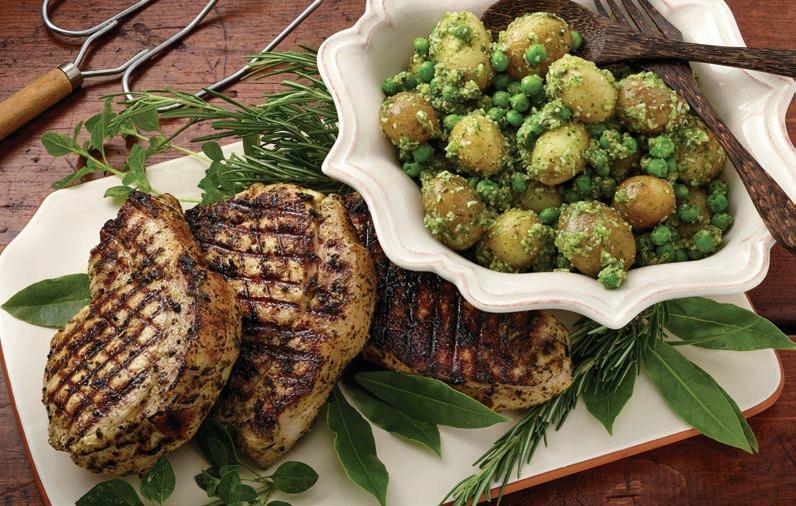
3. Meanwhile put the basil leaves, Parmesan, pine nuts and garlic into a blender, with a tablespoon of oil to loosen. Blitz into a paste. Slowly drizzle in the rest of the oil and continue to blend to a rough paste.
4. After 12 minutes, the potatoes should be near “done” and tender enough to poke a fork into them without much resistance. Add the peas into the pan and cook for 2 more minutes. Drain, and then return the peas and potatoes to the pan.
5. Use a spatula to scoop the pesto into the pan with the peas and potatoes. Put the lid back on and rattle
TIP…
it until all the warm potatoes and peas are well-coated in the pesto. Tip the warm salad into a serving bowl and set to one side.
6. The key with cooking pork loin chops is to do it quickly and at a high temperature—ideally hot enough that the outside takes on a bit of colour, without cooking them so long that the meat dries out. Usually 2–3 minutes on each side is about right, but it depends on thickness.
Butchers usually offer far better quality meat than supermarkets. Look for a thick cut of pork with a fatty rind—that’s where all the flavour is!
7. Put the cooked pork chops on a board and serve them along with the warm potato salad. It’s ideal as part of a barbecue, or as a quick and nutritious dinner.
How Low Can You Go?

AS LONG AFTERNOON barbecues roll on into the evening, it’s worth putting some thought into the ABV (“Alcohol by Volume”) of the wine you’ll be drinking. After a few glasses on a hot summer’s day, the small difference between 12% and 14% can have a big impact how you’re going to feel the next morning.
Broadly speaking, the alcohol level of wine is linked to the amount of sugar the grapes contain when they’re harvested. The higher the sugar, the higher the potential for alcohol— which is why warm climates such as Argentina and Australia are often associated with high-alcohol reds (13.5%–16%).
A counter-trend towards lowABV wines is bubbling away though, driven by people wanting to rein
back the units they consume for health or weight reasons (the higher the alcohol, the higher the calories). One in four people now cite ABV as an influence in the wine they choose and, as a result, companies are producing low-ABV spin-off ranges, such as First Cape’s “Cafe” Collection (5.5%) or Jacob’s Creek’s “Cool Harvest” (9.5%–11%).
ANOTHER OPTION is to look for wine that’s naturally lower in alcohol, and it tends to be the more northern and higher altitude regions where there’s a long tradition of low-ABV bottles. While global trends have seen the percentage of alcohol creep up, a wine such as Moscato d’Asti—a sparkling white produced in Northern Italy—has doggedly remained around 5.5%–7%. Then there are the German Reislings creeping back into fashion and light Beaujolais. Even Lambrusco, which was written-off in the Eighties for being sickly sweet—has had a 21st-century makeover. Crisp, refined bottles (around 11%) are on wine lists at smart restaurant group Ottolenghi.
Of course, there are a growing number of British vineyards too (see p76). Our mild climate means our home-grown vino has a pleasantly low ABV—which could help prevent that morning-after headache...
LOW-ALCOHOL WINES
■ The Society’s Vinho Verde (11.5%) £5.95, The Wine Society My pick of the bunch (and it’s nothing to do with the price!). Crisp and clean with a gentle effervescence, which makes each glass feel like an occasion.
■ Asti Spumante (7.5%) £9, Marks & Spencer Super-dry fizz fans may find this unnervingly sweet—but it’s not remotely cloying. Sherberty, aromatic and very drinkable.
■ Chapel Down Bacchus (11%) £12.99, Waitrose Crisp, dry and great with food, this has been billed as “England’s answer to Sauvignon Blanc”.



■ Dr L Riesling 2014 (8.5%) £7, Asda Its elegance and applecrispness is sure to convert Riseling doubters. A good match for spicy food.
■ Cuvée des Vignerons, Beaujolais (12%) £6.99, Waitrose A light red—the antithesis of those that turn your mouth purple—that can be chilled for summertime drinking.
■ Cantina Cleto Chiarli, Vecchia Modena Lambrusco di Sorbara (11%) £13.95, Great Western Wine Hot pink, with rose and wildstrawberry notes, this is proof that Lambrusco has changed since the sweetened plonk of 30 years ago.



BOOK
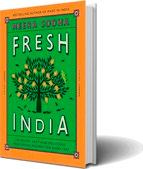
Fresh India, Figtree, £13.60. Even if the weather fails, this will guarantee a bit of heat.
BARGAIN

Pork loin cutlets, Turner & George, £11.90. Top restaurant quality at a fraction of the price.
BLOW OUT

Seed Pantry grow pod + seed kit, £35. Entry-level hydroponics kit for fresh herbs all year round.

Pudding of the Month
Baked Nectarines
This is such an easy pudding and it’s scalable—so perfect for feeding a crowd. Pop by a local fruit and vegetable market to find softer nectarines (rather than “ripen at home”) and pick up a bargain too.
Serves 12
• 12 ripe nectarines
• 100g amaretti biscuits
• 200g mascarpone
• 1tsp cinnamon
• 2tbsps runny honey
Optional serve: crème fraîche, blueberries
1. Preheat the oven to 180C. Wash and then halve the nectarines. Remove the stones and arrange them in a baking tray, flat side up.
2. Put the amaretti biscuits in a sandwich bag and gently pound with a rolling pin to break them into chunks (not so small that they turn to crumbs).
3. Mix the crushed amaretti biscuits, mascarpone and cinnamon. Then use a teaspoon to divide the mixture between the nectarines.
4. Drizzle honey over the nectarines and then bake for 20–25 minutes, until soft.
5. Serve with crème fraîche and blueberries.

Sear The Ultimate Selection!
Fire up the barbecue for the finest quality, grassfed, fully matured UK steak and more, with this outstanding offer from Royal Warrant holding butcher, Donald Russell
Turn your next barbecue into a banquet with this impressive array of cuts. All perfectly sized to cook quickly, this extensive variety of premium meaty treats, from Pork Fillet to Lamb Loin Cutlets, shows there’s more to BBQs than burgers!
Donald Russell’s premium quality Mini BBQ Selection comes professionally frozen and delivered direct to your door on a day to suit you. At only £29, with free delivery*, it’s what barbecues were made for!
How to order: Order today by either calling 01467 629666, quoting RDG1603 or visit donaldrussell.com/rdg1603
■ 4 Beef Mini Rump Steaks, 200g
■ 2 Lamb Loin Cutlets, 180g
■ 6 Pork Fillet Medallions, 300g
■ 4 Sirloin Sandwich Steaks, 120g each
■ 1 pack Free-range Chicken Lollipops, 200g
■ 1 pack Garlic & Herb Chicken Wings, 220g
■ 8 Pork Chipolatas, 225g
■ 6 Mini Steak Burgers, 270g

Lynda Clark is a homes, property and interiors expert, and is editor of First Time Buyer magazine
A Room With A View
A CONSERVATORY offers beautiful garden views all year round. If used as a dining area, aim to get as much natural light into the space as possible by having a glass roof, skylights and floor-to-ceiling windows. Bi-folding doors are also a popular choice—when open, they’ll transform the room into an al-fresco dining area. Keep to a neutral colour palette and just allow the greenery in the garden to act as your backdrop. Mirrored finishes will reflect light even on an overcast day, while soft wooden or wicker furniture will create a country feel.
Dante six-seater dining table, £399; dining chair, £100; Libra Salvador square lantern, £160; ceramic cutlery, from £3.50
■ All available from John Lewis (johnlewis.com)
Get The Look
Enjoy the garden all year round with these pretty accessories perfect for a conservatory.
■ Balmoral conservatory chair, £145 (one.world)
■ Chrome finish vintage style pendant light, £107.40 (darlighting.co.uk)
■ Cream étagère, £128 (miafleur.com)
■ Mirrored clock, £5.95 (chandeliersandmirrors.co.uk)





HOW TO BE A GARDENER

Origin, a British manufacturer of bi-fold doors, has launched a series of how-to gardening videos with Jack Shilley (left), director of the Young Horticultural Society. “The Great Gardening Gap” series gives young homeowners the knowledge and confidence to make the most of their outdoor spaces. From window boxes to vegetables, it’s filled with useful tips (origin-global.com).
Enjoy a tasty BBQ with friends and family SIZZLING SUMMER

Berkeley three burner gas BBQ, £127 (diy.com)

Louisiana charcoal BBQ and pizza oven, £149.99 (homebase.co.uk)

Portable bucket
charcoal BBQ, £9.99 (homebase.co.uk)
Find more tips at readersdigest.co.uk/ BBQ
Are You Missing Out On Hundreds Of Pounds Worth Of Savings?
Save up to £336 simply by switching broadband provider
PEOPLE ALL OVER THE UK could be saving hundreds of pounds simply by switching to a better monthly broadband and home phone service. The good news is that the Reader's Digest free switching support services are here to help as they will make that switching process quick and hassle-free.
Many busy families don’t switch supplier because they think it’s too much hassle and quite simply have no time to find a new deal that would tick all of the boxes. That’s where the Reader's Digest Switching service comes in. Don’t be put off by thinking that switching your internet service will be a hassle, or be daunted by the plethora of deals to choose from!
Even the smallest change can earn you considerable savings.
IT’S SIMPLE!
STEP 1: Call our experts FREE on 0800 380 0061.
STEP 2: The Reader’s Digest Digital Switching service will put you in touch with one of our UK-based broadband experts.
STEP 3: Let us know exactly what you want from your service. Faster broadband? Extra TV channels? We can sort this all for you.

STEP 4: Based on this, our experts will sort through over 11,000 deals to find the right one for you, and talk you through every aspect of switching to a new deal.
STEP 5: Sit back and relax! You don’t have to do anything else. We will let your old supplier know you’re moving, and even arrange your installation for you. It’s completely hassle-free!

Best of all, the Reader’s Digest Digital Switching service, provided by Simplify Digital, is Ofcomaccredited. This means the choice we offer is comprehensive, our advice is extremely accurate and
up to date, and it illustrates our commitment to giving you the very best independent advice.
We will only ever recommend the deal that’s right for you.
So give us a call on 0800 380 0061 and find out how much you could save today.
Calls are free from landlines and mobiles. Dedicated team available 7 days a week, 8am–9pm.
From creating a perfect lawn to cooking healthy pasta, the latest gadgets make every task a breeze
A Cut Above The Others
BY OLLY MANN
Olly is a technology expert, radio presenter and podcaster
EGO POWER + LM2102E-SP, £660
I hear there are men who enjoy mowing the garden (and getting things out the loft, or emptying the bins), but I’m not one of them. In our gaff, I’m just as likely to be doing the dusting while my girlfriend mows the lawn. So we need a mower that’s not massively heavy and doesn’t require a big, manly tug to kick into life. This monster looks like Robocop, but is built on a light frame and has a handle that minimises vibrations.
Best of all, there are no trailing cables, as it’s powered by an 56v lithium ion battery that recharges in minutes. And, by God, can it mow!

APPLE APP OF THE MONTH:
THE ROLL, FREE
Its great that my phone can hold thousands of photos, but it takes ages to scroll through them all. The Roll is an elegant solution. Its image-recognition software


analyses the content of your camera roll, and divides your photos into albums for speedy access. Plus, it prioritises the best-composed shots in a series—so you needn’t go through them all to find that fab one of your cat.
LAKELAND EASY-STORE SPIRALIZER, £34.99
Pasta substitutes (courgetti spaghetti, etc) have been a hit in the supermarkets this summer, so spiralizers are having something of a renaissance. Lakeland’s premium product comes with no less than four easily switchable blades to achieve different thicknesses (though no spaghetti-hoop function, regrettably). I must admit that on my first attempt, I found myself shredding rather than spiralizing, covered my kitchen floor with butternut-squash residue and sliced off some of my thumb. But after a bit of practice, I was whizzing up salads so sanctimonious they’d sit comfortably on Gwyneth Paltrow’s blog.
NONDA ZUS, £21.99
Bitter experience of angrily traversing car parks in the rain has taught me to always make a mental note of where I’ve parked. But occasionally I still forget, or discover that the street I parked on in daylight looks utterly different at night. Zus to the rescue: this GPS-enabled USB charger plugs inside my car’s cigarette lighter, syncs to my smartphone and, every time I turn the engine off, sends my parking location to an app on my phone. A time—and sanity—saver.

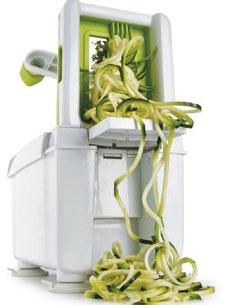

ANDROID APP OF THE MONTH:
TEXTGRABBER + TRANSLATOR, £7.99
This app is a seamless, jawdropping blend of technology and productivity. It digitizes words from a printed page into your mobile phone— so you can point your phone at an article in this magazine, and after a couple of taps be pasting that text into an email. One more tap and you can translate the text into 60 languages, with no need for internet access. Amazing.


Georgina is a fashion and beauty editor for numerous travel titles and a blogger at withgeorgia.com
Sun Smart
IT WAS ONLY A MATTER OF TIME before beauty went high-tech. Now La Roche Posay has come up with the first-ever wearable sun-care patch, which links to an app and monitors your exposure to harmful UV rays.

You can place the adhesive patch wherever you choose on your body. Once you’ve uploaded your personal information to La Roche Posay’s My UV Patch app, take a photo of the patch and it will give you an accurate reading of your current UV risk in your precise location.
The patch itself comes in a pretty blue-heart design and is less than a human strand of hair in thickness, so once it’s on you’ll barely notice it. It’s such a clever way to keep tabs on sun exposure—especially for young children and sun worshippers. Visit their website (laroche-posay.co.uk) to find out how you can get your hands on one.
FAKE IT
■ If you can’t take the heat but desire that sun-kissed holiday glow, then try Green People’s Gradual Tan Facial Moisturiser (£15, greenpeople.co.uk). This non-sticky product builds up a natural bronze tint and is safe to use even on the most sensitive skin types.

PROTEIN FIX
■ A key ingredient in Philip Kingsley’s Trichotherapy Tricho Pro Volumizing Protein Spray (£35, philipkingsley. co.uk) is quinoa protein, which contains all the amino acids needed to restore strength and shine to broken, thinning hair.


■ Forget bikinis; onepiece swimsuits are far more elegant (£35, whitestuff.com).
BEACH CHIC For Her For Him

■ A pair of fast-drying swim shorts make going for a “quick dip” much more practical (£29.50, marksandspencer.com).
■ Protect your face when out in the sun with a trendy beach hat—this headpiece provides both glamour and a wide brim for more shade (£22, topshop.com).


■ Cover up and stay cool on the beach in this cotton kaftan (£50, verrykerry.com).
■ Go from the beach to the bar in this quirky shark and surfboard print shirt (£39.95, whitestuff.com).


■ Not a sandals man? Slip-on espadrilles will lend some comfort and sophistication to your beach holiday (£40, dunelondon.com).
This month’s page-turners are an absorbing willthey-won’t-they tale and a witty insight into old age
August Fiction
BY JAMES WALTON
James writes and presents the BBC Radio
4 literary quiz
The Write Stuff
Miss You
by Kate Eberlen (Mantle, £12.99)Even before publication, Kate Eberlen’s first novel has already caused a stir in the books world, with tales of a frenzied bidding auction and comparisons to David Nicholls’s all-conquering One Day.
Sure enough, Miss You serves up a classic willthey-won’t-they plot: the twist here being that what the central couple might or might not do is meet properly. The book opens in 1997 when Tess is in Florence interrailing after her A Levels, and occasionally bumps into an English boy. But while there’s an obvious attraction, she doesn’t even find out his name is Gus.

And from there, we move through the years with chapters that alternate between her story and his. These duly contain several tantalising near-meetings. Yet, what makes for such a satisfying read is that both narratives are thoroughly absorbing in their own right, with plenty of great subplots, and Tess and Gus proving highly appealing characters who try to lead decent lives, even though they sense something is missing. Now and again, Eberlen’s use of coincidence and the slightly soppy moments do perhaps make Miss You a bit
NAME THE AUTHOR
(Answer on p128)
Can you guess the writer from these clues (and, of course, the fewer you need the better)?
1. He had a teddy bear called Archibald Ormsby-Gore.
2. He was the Poet Laureate.
3. He wrote the line, “Come friendly bombs and fall on Slough.”
of a guilty pleasure—but a pleasure it remains nevertheless.

The Secret Diary of Hendrik Groen, 83¼ Years Old
by anonymous (Michael Joseph, £12.99) And here’s another book that’s provoked quite an fuss—partly because it’s been a huge best-seller in Holland, but mostly because the identity of the anonymous author is a genuine mystery. Is he really an octogenarian writing from inside an Amsterdam care home? Or is he an established author pretending to be?
Either way, the book is terrific.
Right from the first sentence (“Another year, and I still don’t like old people”), Hendrik Groen never sentimentalises his subject. He writes straightforwardly about physical decline and the fear of Alzheimer’s.
And yet, despite his own fears that his diary may be too gloomy, this is by no means a depressing book. For one thing, Groen and a few likeminded residents form the Old-ButNot-Dead club, and rather surprise themselves by what good times they have. For another, there’s a bracing note of defiance, as Groen flouts the house rules and ruminates on the treatment of the elderly. Whatever its source, the result is a sharp, poignant, funny and entirely convincing portrait of old age in all its aspects.
PAPERBACKS
■ The Silent Ones by William Brodrick (Abacus, £8.99). Last-ever outing for the deservedly well-loved priestdetective Father Anselm, this time tackling clerical abuse. Powerful yet sensitively done.
■ Suspicious Minds by Rob Brotherton (Bloomsbury Sigma, £8.99). A thought-provoking history of conspiracy theories— and why they appeal to us.
■ When the Floods Came by Claire Morrall (Sceptre, £8.99). Much-admired novel set in a future Birmingham at a time when a virus has cut off Britain. Morrall’s love for her native city shines through beautifully.
■ Take Six Girls by Laura Thompson (Head of Zeus, £8.99). Not the first-ever book about the Mitford sisters—but it might well be the best of the lot.
■ Word Play by Gyles Brandreth (Coronet, £8.99). A delight for word-lovers as the former MP and TV regular serves up puns, anagrams palindromes and verbal curiosities of all kinds.

RD’S RECOMMENDED READ
The inspirational story of how a bricklayer from Sunderland became an expert stargazer
Reaching For The Sky
WHEN HE LEFT SCHOOL at the age of 16 in 1982, nobody—least of all himself—could possibly have imagined what Gary Fildes (right) would be doing 34 years later.
From an early age, he’d been fascinated by the stars. But for reasons of not getting beaten up, he says, it was an interest he kept to himself. Then, after leaving school, there was the rather more immediate business of earning a living in recession-era Sunderland. Eventually—after a spell as a football hooligan—aged 19 and already married with a child, he became a bricklayer and remained one for the next two decades.
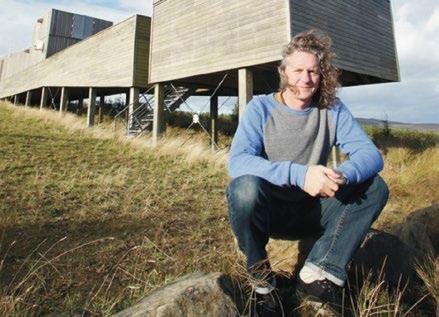
In the mid-90s, though, he finally
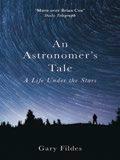
An Astromoner’s Tale: A Life Under the Stars by Gary Fildes is published by Century at £16.99.
came out as an astronomer, buying himself a proper telescope and joining the SAS. (That’s Sunderland Astronomical Society. Motto: “Who Stares Wins”.) Over the following years, both his knowledge and his reputation greatly increased. Even so, it came as quite a shock when he was asked to found and be the lead astronomer at the Kielder public observatory in Kielder Forest, Northumberland—a post he’s held ever since. When it opened in 2008, the plan was for 240 visitors a year. In 2014 it had 24,000.
In The Astronomer’s Tale, Gary tells this astonishing story with
impressive modesty. His feeling of awe about celestial bodies remains undiminished, as well as infectious. As a true evangelical for the subject, he also provides tips for the rookie astronomer and a full guide to the night sky over the course of a year. (“It all begins,” he says, “with looking up and being curious.”)
But we join him here back when he and his mate Shaun were still working the local building sites…
The summers were the best. In the early 90s it wasn’t unusual for us to be working onsite with a group of other lads, everyone in just a pair of speedos and a set of steel-toed boots. What a vision. Bare-chested we would toil all day in the sun, returning home to our family sunburnt and worked out.
Winters were not as pleasant. One year we were doing contract work for Barratt Homes. We were self-employed, which was better for the money, but if you didn’t work you didn’t get paid—even if it was freezing. With four kids now to provide for, and nearing Christmas, the pressure to earn was intense. I bundled up warmly every day to fight the biting winds, but that didn’t solve the problem of the ice-cold bricks. Bricks have a knack of getting wet, and can absorb enough water to nearly double in weight. One morning I went to pick one up. It was hard and cold and so I grabbed
RD
EXCLUSIVE: GARY FILDES’S CHOICE OF ASTRONOMY BOOKS
■ Collins Gem: Stars by Ian Ridpath and Wil Tirion. Mine and many other stargazers’ most trusted companion. I actually have five in various cases and bags, so as never to be caught without one.
■ The Eerie Silence: Searching for Ourselves in the Universe by Paul Davies. A whistle-stop tour into the no man’s land between “I wish aliens existed” and the unexpected view from science that we probably are alone in the universe.
■ The Grand Design by Stephen Hawking and Leonard Mlodinow. I love this book and have forgotten how many times I’ve read it. It’s full of real scientific “knowledge gems”. Read and enjoy.
■ A Universe from Nothing by Lawrence M Krauss. A bit of a read: this is physics after all, and can be stranger than you’d think. But it also has some great stuff that the layperson can absorb—especially as Krauss’s good science is combined with a good sense of humour.
it more vigorously than usual. When it didn’t budge, I hit it with my hammer and up it came. But there it stayed; I couldn’t get it off. The
have no homes to live in. I knew this and felt proud to be doing the work. But internally I felt numb and the dream of astronomy from my youth
I had tried everything to get out. But I could never find an escape. As well as the physical toll, the thought preyed on my mind that somehow this life wasn’t for me
water had frozen my fingers to the brick’s surface. I shook my hand, which only made matters worse as it was too heavy for that. Eventually I tore my fingers away with my other hand, and off came the skin; or rather it remained attached to the brick. In exquisite pain, I screamed up into the grey hanging sky, heart pounding, and I remember thinking, Get used to it, you are here to stay.
I was back on the site again the next day, and the day after. Without brickies and this army of workers who endure these conditions, we would

AND THE NAME OF THE AUTHOR IS…
John Betjeman
(who died aged 77 with Archibald in his arms) His wishes for Slough were atypically unkind.
was a distant memory. What I was doing now I would be doing until I could do it no longer.
As I grew older, things got tougher. Backache is probably the worst part of the job. After a shift I would need to lie down on the floor at home and the kids would stand in the small of my back, to ease the pain and stretch me out. Afterwards I would gingerly lower myself into a hot bath.
I had tried everything to get out. But I could never find an escape. Although the winters could be hard, few jobs around Sunderland could match the money. As well as the physical toll, the thought preyed on my mind that somehow this life wasn’t for me. I had internalised my passion for astronomy since I was a child; around most of the lads at work
I was Gaz the lad, Gaz the Sunderland football fan. Most had no idea that by day I was trowelling, and by night I was reading physics books.
Books
THAT CHANGED MY LIFE

Aarathi Prasad has a PhD in genetics and has presented numerous documentaries. Her new book In the Bonesetter’s Waiting Room: Travels through Indian Medicine is out now.
The House of the Spirits
BY ISABEL ALLENDE
We moved from the UK when I was small and I grew up in the West Indies. I never felt rooted anywhere, and a lot of my emotional development in those formative years came through books. This extraordinary novel, about different generations of powerful women, the tragedies they went through and the strength they found to deal with them, captivated me. I related to the themes of identity; what we inherit and what we make our own.
Mutants: On Genetic Variety and the Human Body
BY ARMANDMARIE
LEROI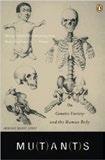
As a science writer myself, this was my biggest influence —a brilliantly written story of people,
history and science. All varieties of human life are here, from giants to bearded women, conjoined twins to dwarves. We learn how societies all over the world have viewed our differences—and you find yourself effortlessly reading about things like signalling molecules without feeling you’re taxing your brain.
Helen of Troy: Goddess, Princess, Whore
BY BETTANY HUGHES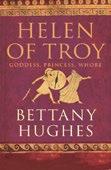
By focusing on the “real” Helen, an aristocrat from the Greek Bronze Age, Bettany brings all the other guises of Helen into play. The politicisation of her character through the ages tells us that, to have been so powerful, she must have been doing something dangerous or wrong. Having my own daughter has made me feel even more strongly that, in terms of progress, there’s still a long way to go... As told to Caroline Hutton
You Couldn’t Make It Up
Win £50 for your true, funny stories! Go to readersdigest. co.uk/contact-us or facebook.com/readersdigestuk
MY FRIEND’S CAT has a reputation for getting himself into tricky situations and having to be rescued. On one occasion, he was discovered teetering on the topmost branch of a tree outside her house, and quite a crowd had gathered.
When a neighbour offered to help get him down, I heard some bright spark say, “You’ll have to carry out a whisker assessment first!”
I ASKED MY HUSBAND when was the last time he’d emptied the dishwasher. “But I never put anything in it,” was his reply.
Unfortunately, that’s true.
MY SON LUCA was watching The Hive, one of his favourite cartoons in which the characters are bees. I asked him, “What do honey bees make?”
“Honey, Mummy”, he replied, rolling his eyes, “and bumble bees make bumble.”
I didn’t have the heart to correct
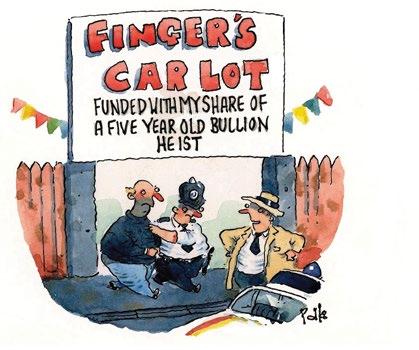
“Well, well, well! I knew if we sat tight long enough you’d get cocky!
him—I don’t know what I’ll do if he asks me for some bumble on his toast!
DANIELA BAKER, by emailDURING THE 2012 OLYMPICS, my husband was one of the many Games Makers. He was a driver. One evening, during a particularly quiet shift, the group were asked for a volunteer to “drive a van to Hollyfield”.
There were confused looks around the group since they weren’t trained
to drive vans. My husband, an experienced minibus driver, said he was quite happy to do it—although he didn’t know where Hollyfield was.
It was only when he went outside that he learned he was being asked to drive the boxer Evander Holyfield, of lost ear fame!
PAULINE SOUTHERDEN, by email
MY WIFE ARRIVED HOME by ambulance after surgery and realised that they’d forgotten to bring her crutches. I took a bus to the hospital to pick them up and, on my way out, noticed a bus pulling up nearby.
With the crutches under my arm, I made a mad dash for the bus and just made it. I had to laugh when the driver looked at the crutches and asked, “Been to Lourdes, have you?”
JIM KERR, by emailMY FATHER, aged 89, surprised my mother one afternoon by arriving home in a police car. The policeman explained to her that my father had said he’d got lost in the woods.
My mother, incredulous, exclaimed that he’d been doing the same walk in the woods for more than 20 years. My father, whispering out of earshot, said, “I wasn’t lost. I was just too tired out to walk back home!”
JAYNE WILE, ClwydJAMES, four years old, was listening to a Bible story. His dad read, “The man named Lot was warned to take
his wife and flee out of the city, but his wife looked back and was turned to salt.”
Concerned, James asked, “What happened to the flea?”
ARTHUR SMITH, Glasgow
MY SIX-YEAR-OLD GRANDSON overheard someone swearing the other day and commented, “That was a swear word—I’ll never use swear words”.
Upon which his four-year-old brother solemnly promised, “No, I won’t either—and no triangle words or rectangle words or circle words.”
SUE FLOWERDEW, Surrey
I’VE SEEN SOME STRANGE THINGS written in toilets, but nothing as odd as the sign I encountered recently. It read: “Please flush the toilet when you are done. Failure to do so may cause a build-up that will throw the earth out of orbit and plunge us into the sun.”
LEE HALL, KentI WAS HELPING my grandfather plan a party for his 90th birthday. I noticed that his invitation list included lots of relatives and neighbours but not many friends. Keen to make it a good party, I asked him why he didn’t invite some of his old school friends— but he shook his head and said if he did he might get arrested.
Laughing, I asked why. He replied, “Grave-robbing is a crime, you know!”
CARYS SCOTT, LondonREADER OFFER
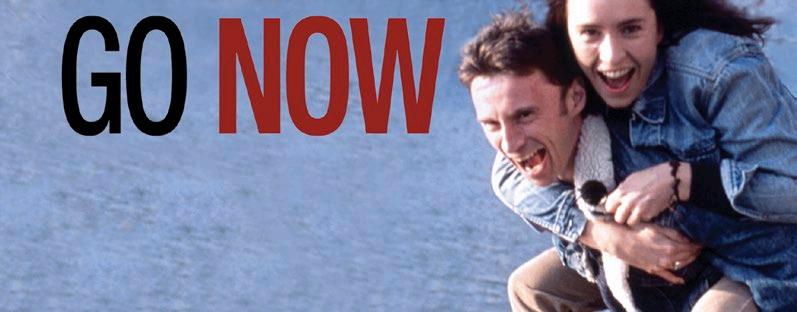
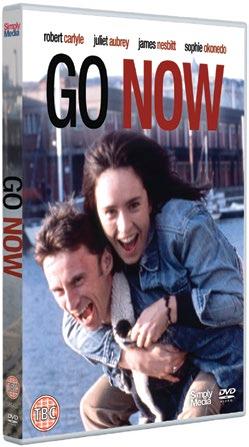

HOW TO ORDER
Amateur footballer
Nick Cameron (Robert Carlyle) has the best of everything when he falls in love with soulmate Karen. But complications arise when a mysterious illness begins to sap his energy. As MS sets in, his physical powers diminish. He becomes wheelchair bound and loses his job. James Nesbitt co-stars. It is a gritty, uplifting drama described as “A big-hearted anthem to love and friendship” – Variety. Exclusive interview with Danny Wallace as a DVD extra. 1hr 21.
£1 from every purchase will be donated to the MS Society

166430 Go Now DVD is out on 12/09/2016.
RRP: £19.99
Selling Price: £16.99
Reader’s Digest subscribers can pre-order now and receive an extra 10% OFF—quote RDGONOW when ordering to claim your discount.
(Please quote RDGONOW when ordering)
Online: shop.readersdigest.co.uk
Phone: 0844 332 8080 (8am-8pm Mon-Fri, 9am-5pm Sat-Sun)
By Post: Reader’s Digest, FREEPOST, RTHR-LLRY-ZHYS, Ringwood, BH24 1HD
(Cheques should be payable to Reader’s Digest. Please remember to quote RDGONOW and include your full name and address, along with the details of the item(s) required).
IT PAYS TO INCREASE YOUR
Word Power
From the land that gave birth to baseball, Budweiser and bebop, we bring you this mix of words, phrases and names. Need help with your Americana? Ask your uncle Sam—or check the next page for answers.
BY EMILY COX & HENRY RATHVON1. pompadour n—A: parade uniform. B: convertible top. C: men’s hairstyle.
2. El Capitan n—A: Yosemite rock formation. B: Alamo general. C: Civil War stronghold.
3. jackalope n—A: rabbit with antlers. B: rodeo bronco. C: crusading journalist.
4. barnstorm v—A: travel around performing. B: dance at a hoedown. C: give a ranting speech.
5. ponderosa n—A: gold mine. B: pine tree. C: mountain range.
6. fake book n—A: recipe folder or container. B: stack of marked playing cards. C: collection of songs.
7. tricorn adj—A: popped, as in kernels. B: deliberately campy. C: like Paul Revere’s hat.
8. bunting n—A: fabric for flags. B: baby boy. C: ornate Roaring Twenties dress.
9. Tin Pan Alley n—A: hideout for hoboes. B: row of factories.
C: pop-music centre formed in the late 19th century.
10. twain n—A: disguise. B: male suitor. C: two.
11. moxie n—A: chorus girl. B: courage. C: double-talk or deceptive message.
12. brushback n—A: grooming technique for a horse. B: baseball pitch. C: method of sawing.
13. eighty-six v—A: round up. B: get rid of. C: submerge.
14. copacetic adj—A: very satisfactory. B: rather satirical. C: pepped up.
Answers
1. pompadour—[C] men’s hairstyle. The piled-up-in-front do, notably worn by Elvis, was named for France’s Madame de Pompadour (1721–1764).
2. El Capitan—[A] Yosemite rock formation. It’s Spanish for “the captain”—appropriate, since the landmark impressed early explorers as the dominant rock in the valley.
3. jackalope—[A] rabbit with antlers. In Wild West folklore, it’s a cross between a jackrabbit and an antelope.
4. barnstorm—[A] travel around performing. Semi-pro baseball teams used to tour the country playing exhibition games in their off-season.
5. ponderosa—[B] pine tree. The name of this heavy North American tree has roots in the word ponderous.
6. fake book—[C] collection of songs. Used by jazz musicians to learn songs quickly, it has bare-bones melody lines.
7. tricorn—[C] like Paul Revere’s hat. A tricorn hat is bent at three points (tri for “three” plus corn for “corner”).
8. bunting—[A] fabric for flags. Made of worsted wool, it’s typically used for Fourth of July banners.
9. Tin Pan Alley—[C] pop-music centre formed in the late 19th century. It was named for the tinkling pianos in a neighbourhood of Manhattan songwriters.
10. twain—[C] two. Where the Mississippi River measured two fathoms in depth, steamship workers would call out, “Mark twain!”
11. moxie—[B] courage. The word dates back to a soft drink in the 1800s.
12. brushback—[B] baseball pitch. It forces a batter to step back and breaks his confidence.
WORD OF THE DAY*
TODDLE:
verb: to go.
Alternative suggestions:
“When an infant picks up daddy’s empty whisky bottles from the night before.”
“When you’re confused about what day it is.”
“When toads cosy up.”
“Trying to drink tea while walking.”
13. eighty-six [B] get rid of. Rhyming with nix, it was originally diner slang meaning “to cancel.”
14. copacetic [A] very satisfactory. Its roots are unknown, but tap dancer Bill “Bojangles” Robinson claimed to have invented the word.
VOCABULARY RATINGS
9 & below: uninterested
10–12: States-side
13–15: all-American
Your Guide To Getting Back Out There With Reader’s Digest Dating
Leisure time, long holidays and new hobbies—enjoying the finer things in life is the privilege of being 50-plus. Sharing it all with someone special is even better.
Reader’s Digest Dating can help you get back out there.
MAKING A START
Online dating is convenient and straightforward. All our subscribers are over 50, single and looking for companionship. Once your profile is made we’ll suggest people who match your tastes and interests— the rest is up to you!
Chatting to new people can seem challenging at first. Why not join a local club or class? That special someone might not be at the local book club, but mingling will help to build your social confidence.
MAKING A DATE
A great profile picture can be the start of something beautiful! It needn’t be difficult—a recent photograph of
yourself in natural light is always the best bet.
All our subscribers can make contact via our messaging service. Taking the time to write to someone is a great way start a conversation. With Reader’s Digest Dating, you can afford to spend a little more time getting to know your admirers!
A first date is best held in an open, public space. Keep it light-hearted and centred on a common interest. You might opt for a coffee in a favourite park or an early show at the theatre. Above all, don’t forget to have fun!

BrainTeasers
Challenge yourself by solving these puzzles and mind stretchers, then check your answers on page 139.
GEOMAZE
Without going over a line, trace a path from the arrow to the flag.
MYSTERY NUMBER
The numbers in this table follow a rule. What’s the missing number?
HAVES AND HAVE-NOTS
There are four bananas and nobody has—or has ever had—more than one.
Aloysius and Brigitte either both have a banana or neither of them has one.
If Clovis has a banana, then Darnella has one.
Eugenia, Friedrich and Georginetta have two bananas among them.
If Horatius doesn’t have a banana, then neither does Aloysius.
Put together, Brigitte, Darnella and Clovis have an odd number of bananas.
Friedrich gave a banana to Eugenia.
Georginetta has just as many bananas as Horatius.
So, who’s got bananas?
MAKE-A-SHAPE
Could these pieces be rearranged, like a jigsaw puzzle, to make the pentagon below?
GET AN ANGLE
Under each pair of figures, there’s a number that tells us something about them. What should the missing number be?
BrainTeasers: Answers
GEOMAZE
MYSTERY NUMBER
14. The sequence on the bottom row is made by multiplying each number in the top row by two, then arranging those products in reverse order from right to left.
HAVES AND HAVE-NOTS
Darnella, Eugenia, Georginetta and Horatius have bananas.
MAKE-A-SHAPE
Yes.
GET AN ANGLE
540. To find each number, add up the degrees in the interior angles of the two shapes above it. (The angles in triangles always add up to 180 degrees; the angles in quadrilaterals—including squares—total 360 degrees, and those in pentagons total 540.)
READER’S
£50 PRIZE QUESTION
Answer published in the September issue
What percentage of the shape below is shaded?
The first correct answer we pick on August 4 wins £50!* Email excerpts@readersdigest.co.uk
ANSWER TO JULY’S PRIZE QUESTION
Pamper
It begins with a girl’s name (Pam). The others begin with boys’ names (Dan, Don, Ken and Tim).
AND THE £50 GOES TO… Stewart Pether, Oxfordshire
* Entry is open only to residents of the UK, Channel Islands, Isle of Man and Republic of Ireland aged 18 or over. It is not open to employees of Vivat Direct Limited (t/a Reader’s Digest), its subsidiary companies and all other persons associated with the competition.
Laugh!
Win £50 for every reader’s joke we publish! Go to readersdigest. co.uk/contact-us or facebook.com/readersdigestuk
BOB AND TARQUIN are attending a university reunion. Bob can’t get a word in edgeways as Tarquin brags about his top-salary job, his top-ofthe-range sports car and his frequent holidays around the world—all expenses paid.
He comes up for breath and shows Bob a photo of his wife. “Isn’t she gorgeous?” boasts Tarquin.
Bob replies, “If you think she’s gorgeous, you should see my wife.”
“Why?” asks Tarquin. “Is she a stunner?”
Bob replies, “No, she’s actually an optician.”
JOSEPHSTOKOE, Durham
I WAS THINKING about how people seem to read the Bible a whole lot more as they get older. Then in dawned on me—they’re cramming for their final exam.
COMEDIAN GEORGE CARLIN
IT’S THE WORLD CUP FINAL and a man makes his way to his seat right next to the pitch. He sits down, noticing that the seat next to him
is empty. He leans over and asks his neighbour if someone will be sitting there.
“No,” says the neighbour. “The seat is empty.”
“This is incredible,” said the man. “Who would have a seat like this for the Final and not use it?”
The neighbour says, “Actually, the seat belongs to me. I was supposed to come with my wife, but she passed away. This is the first World Cup Final we haven’t been to together since we got married.”
“Oh, I’m so sorry to hear that. That’s terrible…but couldn’t you find someone else, a friend, relative or even a neighbour, to take her seat?”
The man shakes his head. “No,” he says. “They’re all at the funeral.”
SEEN AT METRO.CO.UK
YOU’RE A COWBOY. The cowboy is riding bareback on a brown horse. The horse falls down, breaking its leg. The sun is setting quickly and the nearest house is three miles away. The chance of rain that night
is at 75 per cent and the chance of snow is 33 per cent. What colour is the cowboy’s hair?
Whatever colour your hair is, you fool. SEEN AT GOODRIDDLESNOW.CO.UK
JOHN, WHO WAS IN FINANCIAL DIFFICULTY,
walked into a church and started to pray.
“Listen, God,” John said. “I know I haven’t been perfect, but I really need to win the lottery. I don’t have a lot of money. Please help me out.’’
He left the church. A week went by and he hadn’t won the lottery, so he walked into a synagogue.
“Come on, God,’’ he said. “I really need this money. My job is going to finish soon and I have bills to pay. Please let me win the lottery.’’
He left the synagogue. A week went by and he didn’t win the lottery. So he went to a mosque and started to pray again.
“You’re starting to disappoint me, God,’’ he said. “I’ve prayed and prayed. If you just let me win the lottery, I’ll be a better person. I don’t have to win the jackpot, just enough to get me out of debt. I’ll give some to charity, even. Just let me win.’’
John thought this would do it, so he got up and walked outside. Then the clouds opened up, there was a flash of lightening and a booming voice said, “John, you’re going have to meet me halfway on this one. Buy a lottery ticket.’’
ANDREW BERRY, LincolnshireFORTY WINKS
They say you should let sleeping dogs lie. What about children and cats? (as seen on sadanduseless.com)




FOLLOWING THE TRAGIC DEATH of his wife in a farming accident, her husband was on the phone to his local newspaper, enquiring about the cost of an obituary.
“Blimey, that’s expensive!” he exclaimed, after being told the price. “Just put, Gladys Braithwaite. Died, July 17. Sadly missed. It’s all she would have wanted.”
“You have another eight words,” said the woman at the paper. “It’s still the same price.”
“Well, if I don’t have to pay extra,” said the farmer, “it would be a pity to waste ‘em!”
The notice was duly published and read: Gladys Braithwaite. Died. July 17. Sadly Missed. Also tractor for sale. Slight damage to front.
BARBARA WOOTTON, Staffordshire
I SAW THIS BLOKE chatting up a cheetah. I thought, He’s trying to pull a fast one.
COMEDIAN PETER KAY
A BLIND MAN walks into a bar with his seeing-eye dog. He immediately yanks the dog and starts to spin him in the air like a lasso. The bartender is shocked. “What are you doing?”
The blind man replies calmly, “Oh, just having a look around.”
SEEN ONLINE
A LOT OF PEOPLE say there’s a fine line between genius and insanity. I don’t think there’s a fine line, I think there’s a yawning gulf. You see some poor bugger scuffling up the road with balloons tied to his ears, he’s not going home to invent rockets, is he?
COMEDIAN BILL BAILEY
LUXURY PROBLEMS
Believe it or not, there’s a Twitter account dedicated to the “overheard screams of consciousness from the ladies who brunch”. So thank you, @Highgatemums, for your eavesdropping talent:
“Parenting pinnacle reached: the 14-year-old is able to go alone to the supermarket and choose a perfectly ripe avocado.”
“Buying Jen presents today. She’s inconsolable that Christmas is so far away. Some sort of placation is needed to keep things bearable.”
“I mean, Amelia’s en suite isn’t even as big as ours. It’s a joke, really.”
“I can’t believe I got shouted at by the nanny for putting raisins in the packed lunch!”
Beat the Cartoonist!

Think of a witty caption for this cartoon—the three best suggestions, along with the cartoonist’s original, will be posted on our website in midAugust. If your entry gets the most votes, you’ll win £100 and a framed copy of the cartoon, with your caption.
Submit to captions@readersdigest.co.uk or online at readersdigest.co.uk/caption by August 12. We’ll announce the winner in our October issue.
June’s Winner
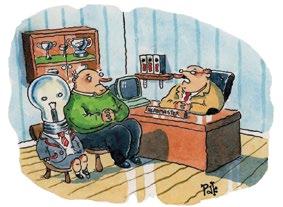
There were no end of lightbulb-related puns this month, but reader Nina Straughan had the pick of the bunch with, “He’s just not switched on at the moment”, which attracted 45 per cent of the vote and beat cartoonist Peter King’s effort, “Your son is exceptionally bright”. All very illuminating.

The Future of Care
The first in a three-part series looking at innovative ways of tackling the issues of old age and loneliness in the UK.
IN THE SEPTEMBER ISSUE Plus
• What to Eat Now
• The Solo Shepherdess
• If I Ruled the World: Steve Jones
• Saving Europe’s Forests
• “I Remember”: Anthea Turner
60 Second Stand-Up
We chatted to self-deprecating chap Mark Watson
HAVE YOU FOUND ANY PARTS OF THE COUNTRY TO BE FUNNIER THAN OTHERS?
I’ve had really enjoyable shows in the Lake District, in places not many comedians visit. Sometimes it can be a real advantage to be one of the only funny things that’s ever happened in an area.
WHAT’S YOUR MOST MEMORABLE HECKLE EXPERIENCE?
I was once late for my own show. I had to spend the first half essentially apologising to the audience—then talked about how my wife and I had recently had a baby. Immediately someone shouted, “Was he late too?”
ANY FUNNY TALES ABOUT A TIME YOU BOMBED ON STAGE?
April 5, 2005. I remember the date, it was that painful. It was a very aggressive, late-night Saturday crowd and they didn’t want to listen to me at all. They shouted “Off! Off!” and started to chuck coins—though not enough money to be any consolation.
IF YOU COULD HAVE A SUPER POWER, WHAT WOULD IT BE?
I lose things all the time, so for me it would be a super power just to

remember where I’ve put my bank card. That and invisibility.
WHAT’S YOUR FAVOURITE ONE-LINER?
Milton Jones: “People think firemen should be paid more—but apparently a poll was taken and they all fell through a hole in the floor.”
IF YOU WERE A FLY ON THE WALL, WHOSE WALL WOULD YOU BE ON?
I’d witness the judges’ discussion before the Oscars. Then place a bet.
Mark’s “I’m Not Here” show is touring. Visit markwatsonthecomedian.com for details.










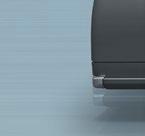





We all dearly love our four legged friends, but cleaning up after them makes vacuuming even more of a chore. Stubborn hair embedded in the carpet, the brush bar choked up… not to mention the smell. High
The cordless AirRam K9 is the 4x4 upgrade of the original AirRam, complete with extra tough features. Designed not only for great cleaning performance, but to withstand the extra strain pet hair can place on a vacuum cleaner – clogging the mechanism and making it wear out faster.
Tougher
AirRam K9 is specially designed to lift embedded hair from carpet bres, but minimise the amount of hair that gets wrapped around the brush-bar, so less cleaning for you.
Stronger
The K9 is strengthened by zinc alloy components, to resist the wear and tear caused by the toughest cleaning environments.
Sweeter
And, it features re llable oral scented lters to leave your room smelling clean and fresh.
All the great features of the original AirRam






Added to that are all the great features that have made the Gtech AirRam so popular: Mains powered upright vacuum performance†; Lightweight (3.8kg); 40 minutes run-time*; 4-hour charge-time; ‘one button’ simplicity and easy one-click assembly.

Power, performance, simplicity

Without the weight or cord holding you back, you can glide from carpet to hard- oor without stopping, unplugging or changing any settings.

Suitable for all domestic pets, or just the busiest homes, the K9 compresses the hair and dirt into bales. A removable tray lifts out, allowing you to drop the debris into the bin, without the dust cloud you can get when you empty a cylinder.

























































































































